Role of Motivation in Organization
VerifiedAdded on 2022/03/29
|77
|15797
|174
AI Summary
In this document, we will discuss the Role of Motivation in an Organization. Motivation is a technique, which is always been used by managers to increase the efficiency level of staff. The following study investigates the different types of motivational factor that influences employee motivation and the whole study will deploy under the 10 Paternoster Square branch of Sainsbury’s, London.
Contribute Materials
Your contribution can guide someone’s learning journey. Share your
documents today.
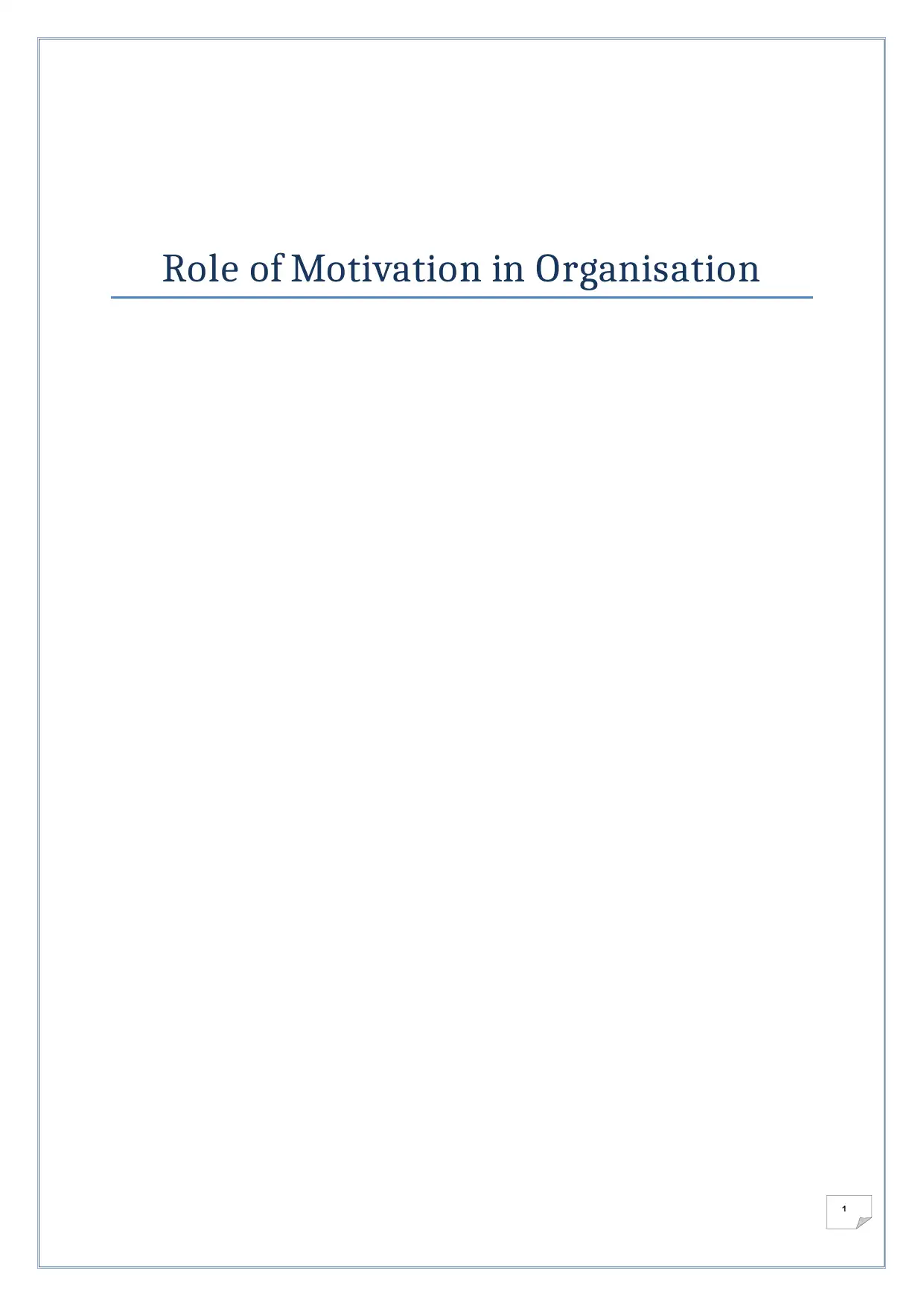
1
Role of Motivation in Organisation
Role of Motivation in Organisation
Secure Best Marks with AI Grader
Need help grading? Try our AI Grader for instant feedback on your assignments.
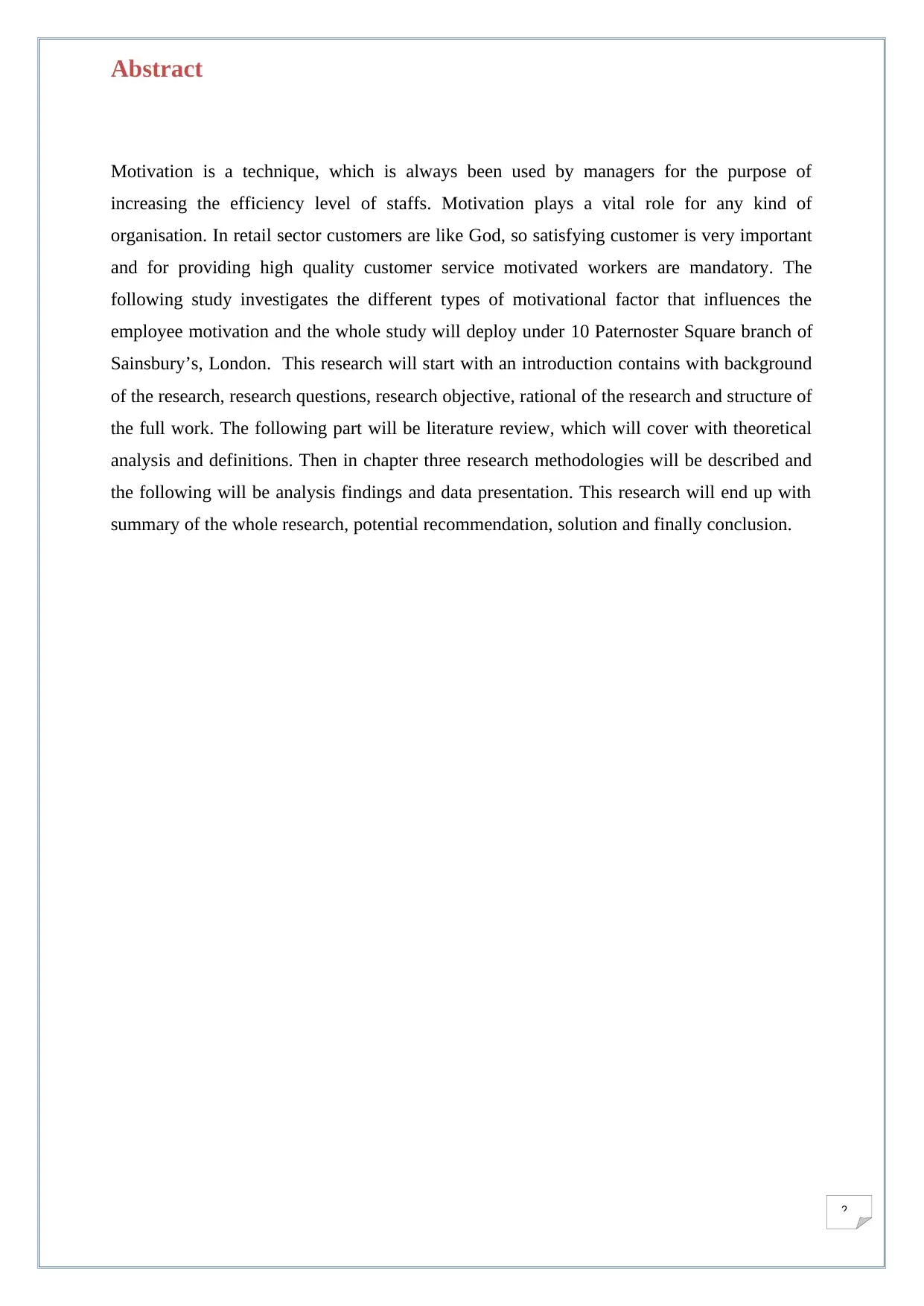
2
Abstract
Motivation is a technique, which is always been used by managers for the purpose of
increasing the efficiency level of staffs. Motivation plays a vital role for any kind of
organisation. In retail sector customers are like God, so satisfying customer is very important
and for providing high quality customer service motivated workers are mandatory. The
following study investigates the different types of motivational factor that influences the
employee motivation and the whole study will deploy under 10 Paternoster Square branch of
Sainsbury’s, London. This research will start with an introduction contains with background
of the research, research questions, research objective, rational of the research and structure of
the full work. The following part will be literature review, which will cover with theoretical
analysis and definitions. Then in chapter three research methodologies will be described and
the following will be analysis findings and data presentation. This research will end up with
summary of the whole research, potential recommendation, solution and finally conclusion.
Abstract
Motivation is a technique, which is always been used by managers for the purpose of
increasing the efficiency level of staffs. Motivation plays a vital role for any kind of
organisation. In retail sector customers are like God, so satisfying customer is very important
and for providing high quality customer service motivated workers are mandatory. The
following study investigates the different types of motivational factor that influences the
employee motivation and the whole study will deploy under 10 Paternoster Square branch of
Sainsbury’s, London. This research will start with an introduction contains with background
of the research, research questions, research objective, rational of the research and structure of
the full work. The following part will be literature review, which will cover with theoretical
analysis and definitions. Then in chapter three research methodologies will be described and
the following will be analysis findings and data presentation. This research will end up with
summary of the whole research, potential recommendation, solution and finally conclusion.
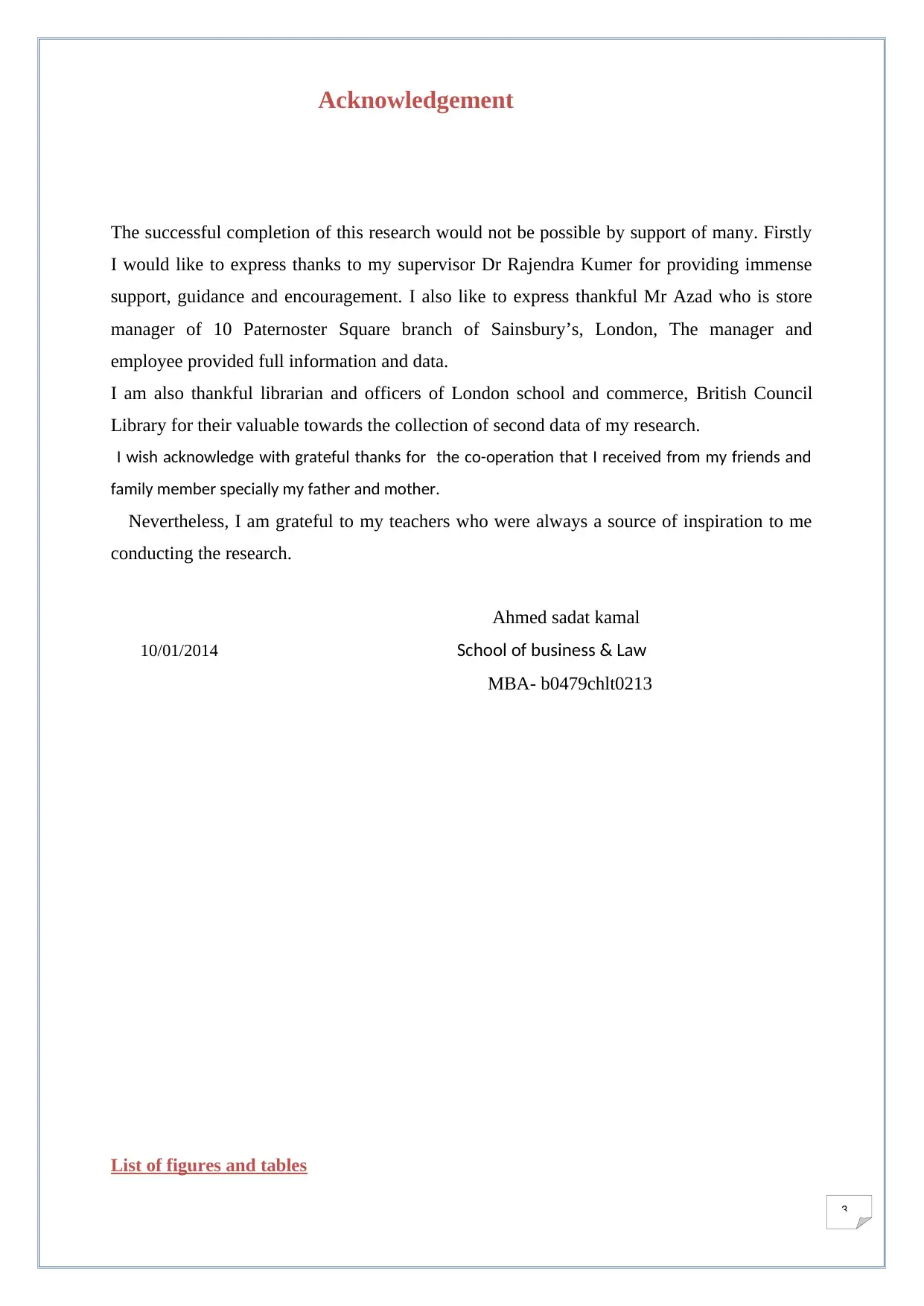
3
Acknowledgement
The successful completion of this research would not be possible by support of many. Firstly
I would like to express thanks to my supervisor Dr Rajendra Kumer for providing immense
support, guidance and encouragement. I also like to express thankful Mr Azad who is store
manager of 10 Paternoster Square branch of Sainsbury’s, London, The manager and
employee provided full information and data.
I am also thankful librarian and officers of London school and commerce, British Council
Library for their valuable towards the collection of second data of my research.
I wish acknowledge with grateful thanks for the co-operation that I received from my friends and
family member specially my father and mother.
Nevertheless, I am grateful to my teachers who were always a source of inspiration to me
conducting the research.
Ahmed sadat kamal
10/01/2014 School of business & Law
MBA- b0479chlt0213
List of figures and tables
Acknowledgement
The successful completion of this research would not be possible by support of many. Firstly
I would like to express thanks to my supervisor Dr Rajendra Kumer for providing immense
support, guidance and encouragement. I also like to express thankful Mr Azad who is store
manager of 10 Paternoster Square branch of Sainsbury’s, London, The manager and
employee provided full information and data.
I am also thankful librarian and officers of London school and commerce, British Council
Library for their valuable towards the collection of second data of my research.
I wish acknowledge with grateful thanks for the co-operation that I received from my friends and
family member specially my father and mother.
Nevertheless, I am grateful to my teachers who were always a source of inspiration to me
conducting the research.
Ahmed sadat kamal
10/01/2014 School of business & Law
MBA- b0479chlt0213
List of figures and tables
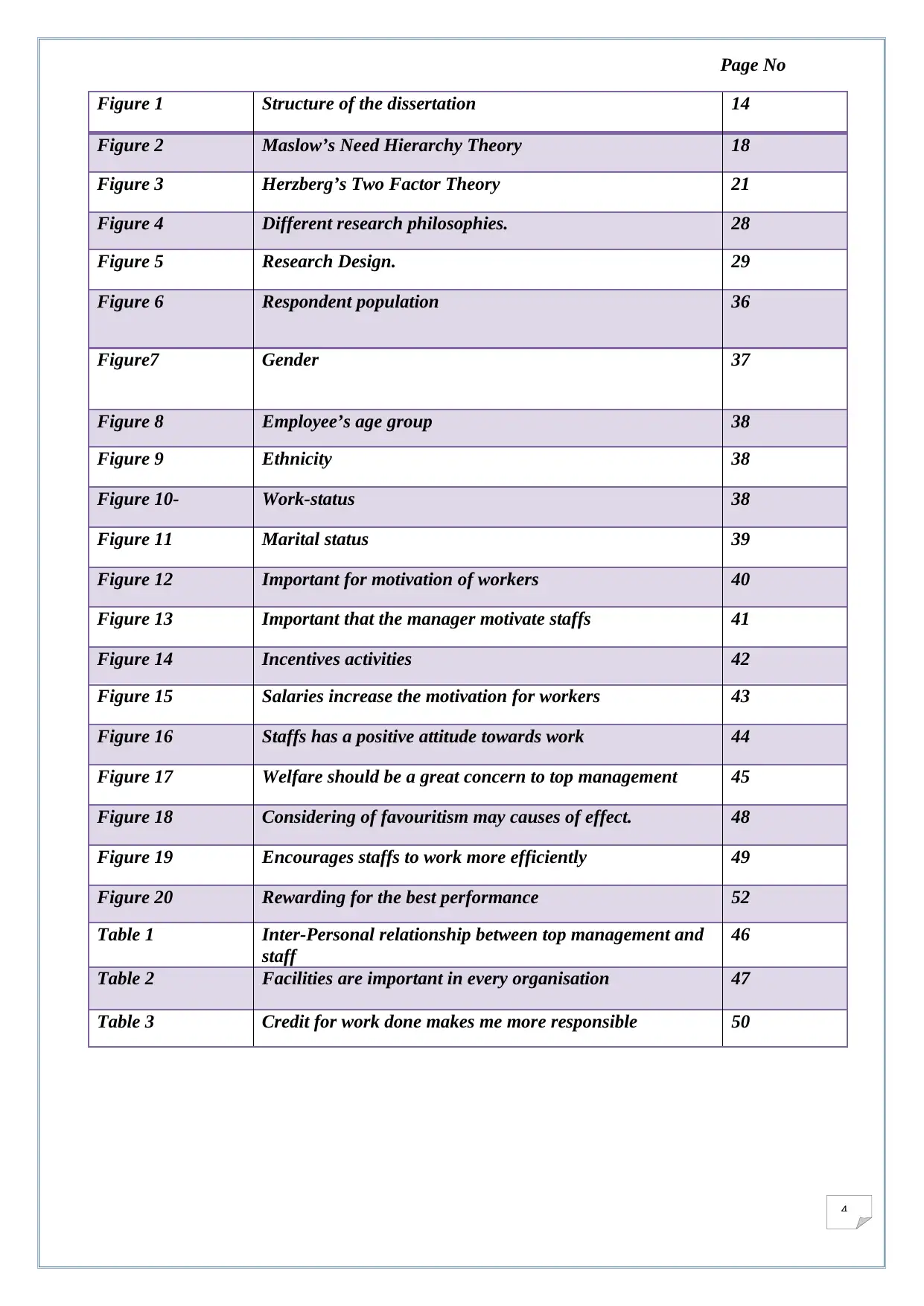
4
Page No
Figure 1 Structure of the dissertation 14
Figure 2 Maslow’s Need Hierarchy Theory 18
Figure 3 Herzberg’s Two Factor Theory 21
Figure 4 Different research philosophies. 28
Figure 5 Research Design. 29
Figure 6 Respondent population 36
Figure7 Gender 37
Figure 8 Employee’s age group 38
Figure 9 Ethnicity 38
Figure 10- Work-status 38
Figure 11 Marital status 39
Figure 12 Important for motivation of workers 40
Figure 13 Important that the manager motivate staffs 41
Figure 14 Incentives activities 42
Figure 15 Salaries increase the motivation for workers 43
Figure 16 Staffs has a positive attitude towards work 44
Figure 17 Welfare should be a great concern to top management 45
Figure 18 Considering of favouritism may causes of effect. 48
Figure 19 Encourages staffs to work more efficiently 49
Figure 20 Rewarding for the best performance 52
Table 1 Inter-Personal relationship between top management and
staff
46
Table 2 Facilities are important in every organisation 47
Table 3 Credit for work done makes me more responsible 50
Page No
Figure 1 Structure of the dissertation 14
Figure 2 Maslow’s Need Hierarchy Theory 18
Figure 3 Herzberg’s Two Factor Theory 21
Figure 4 Different research philosophies. 28
Figure 5 Research Design. 29
Figure 6 Respondent population 36
Figure7 Gender 37
Figure 8 Employee’s age group 38
Figure 9 Ethnicity 38
Figure 10- Work-status 38
Figure 11 Marital status 39
Figure 12 Important for motivation of workers 40
Figure 13 Important that the manager motivate staffs 41
Figure 14 Incentives activities 42
Figure 15 Salaries increase the motivation for workers 43
Figure 16 Staffs has a positive attitude towards work 44
Figure 17 Welfare should be a great concern to top management 45
Figure 18 Considering of favouritism may causes of effect. 48
Figure 19 Encourages staffs to work more efficiently 49
Figure 20 Rewarding for the best performance 52
Table 1 Inter-Personal relationship between top management and
staff
46
Table 2 Facilities are important in every organisation 47
Table 3 Credit for work done makes me more responsible 50
Secure Best Marks with AI Grader
Need help grading? Try our AI Grader for instant feedback on your assignments.

5
Table of contents
Table of contents
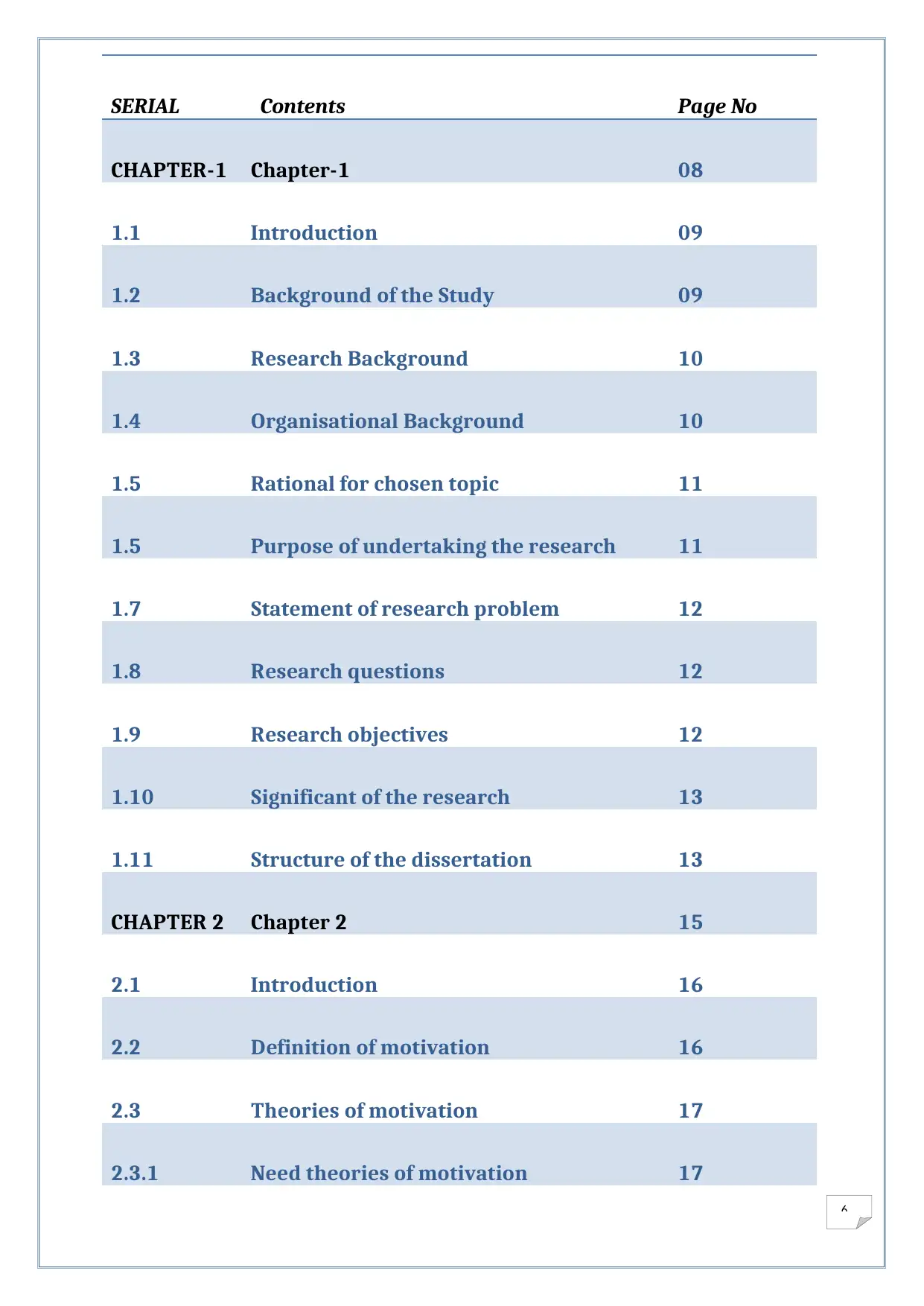
6
SERIAL Contents Page No
CHAPTER-1 Chapter-1 08
1.1 Introduction 09
1.2 Background of the Study 09
1.3 Research Background 10
1.4 Organisational Background 10
1.5 Rational for chosen topic 11
1.5 Purpose of undertaking the research 11
1.7 Statement of research problem 12
1.8 Research questions 12
1.9 Research objectives 12
1.10 Significant of the research 13
1.11 Structure of the dissertation 13
CHAPTER 2 Chapter 2 15
2.1 Introduction 16
2.2 Definition of motivation 16
2.3 Theories of motivation 17
2.3.1 Need theories of motivation 17
SERIAL Contents Page No
CHAPTER-1 Chapter-1 08
1.1 Introduction 09
1.2 Background of the Study 09
1.3 Research Background 10
1.4 Organisational Background 10
1.5 Rational for chosen topic 11
1.5 Purpose of undertaking the research 11
1.7 Statement of research problem 12
1.8 Research questions 12
1.9 Research objectives 12
1.10 Significant of the research 13
1.11 Structure of the dissertation 13
CHAPTER 2 Chapter 2 15
2.1 Introduction 16
2.2 Definition of motivation 16
2.3 Theories of motivation 17
2.3.1 Need theories of motivation 17
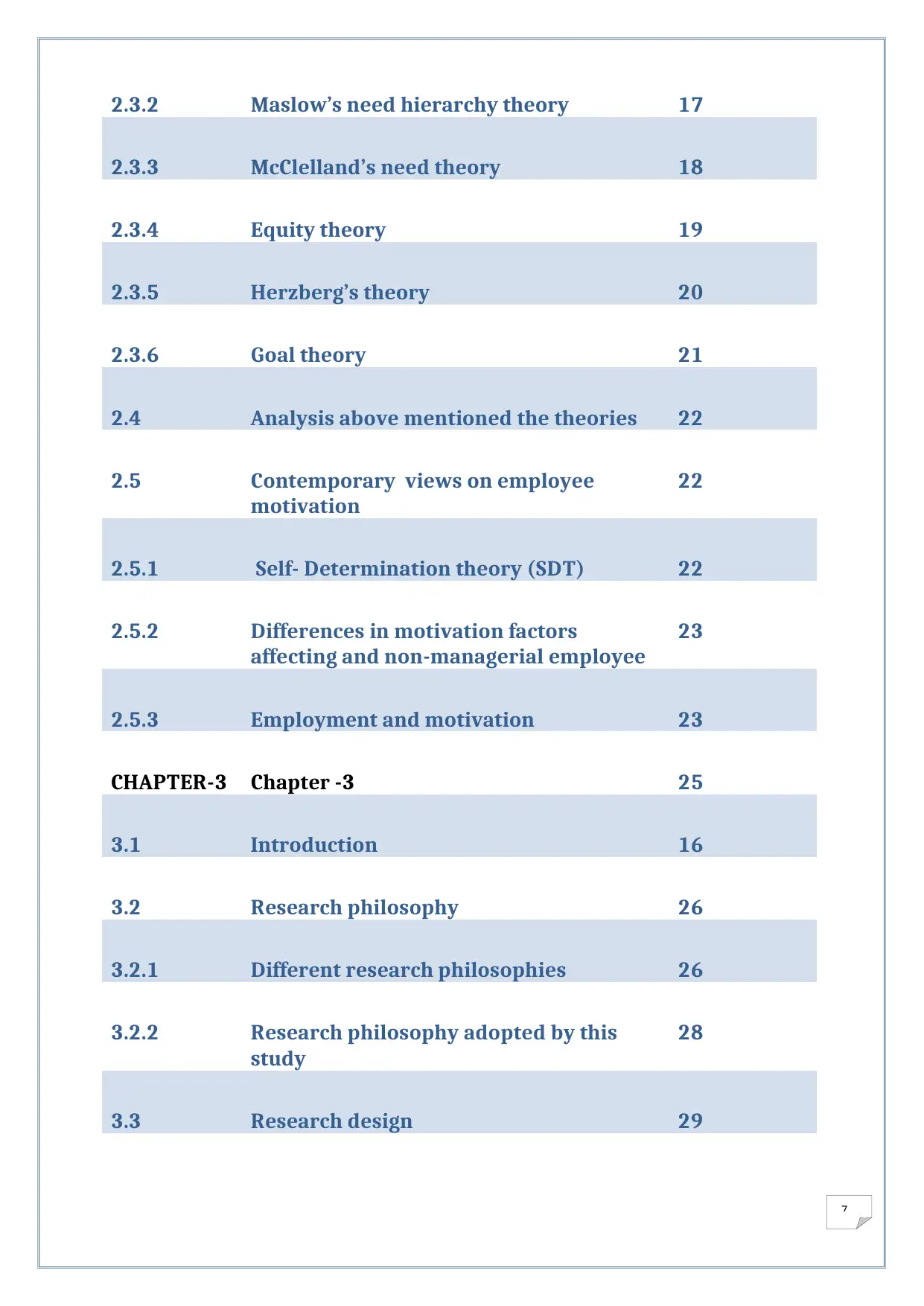
7
2.3.2 Maslow’s need hierarchy theory 17
2.3.3 McClelland’s need theory 18
2.3.4 Equity theory 19
2.3.5 Herzberg’s theory 20
2.3.6 Goal theory 21
2.4 Analysis above mentioned the theories 22
2.5 Contemporary views on employee
motivation
22
2.5.1 Self- Determination theory (SDT) 22
2.5.2 Differences in motivation factors
affecting and non-managerial employee
23
2.5.3 Employment and motivation 23
CHAPTER-3 Chapter -3 25
3.1 Introduction 16
3.2 Research philosophy 26
3.2.1 Different research philosophies 26
3.2.2 Research philosophy adopted by this
study
28
3.3 Research design 29
2.3.2 Maslow’s need hierarchy theory 17
2.3.3 McClelland’s need theory 18
2.3.4 Equity theory 19
2.3.5 Herzberg’s theory 20
2.3.6 Goal theory 21
2.4 Analysis above mentioned the theories 22
2.5 Contemporary views on employee
motivation
22
2.5.1 Self- Determination theory (SDT) 22
2.5.2 Differences in motivation factors
affecting and non-managerial employee
23
2.5.3 Employment and motivation 23
CHAPTER-3 Chapter -3 25
3.1 Introduction 16
3.2 Research philosophy 26
3.2.1 Different research philosophies 26
3.2.2 Research philosophy adopted by this
study
28
3.3 Research design 29
Paraphrase This Document
Need a fresh take? Get an instant paraphrase of this document with our AI Paraphraser
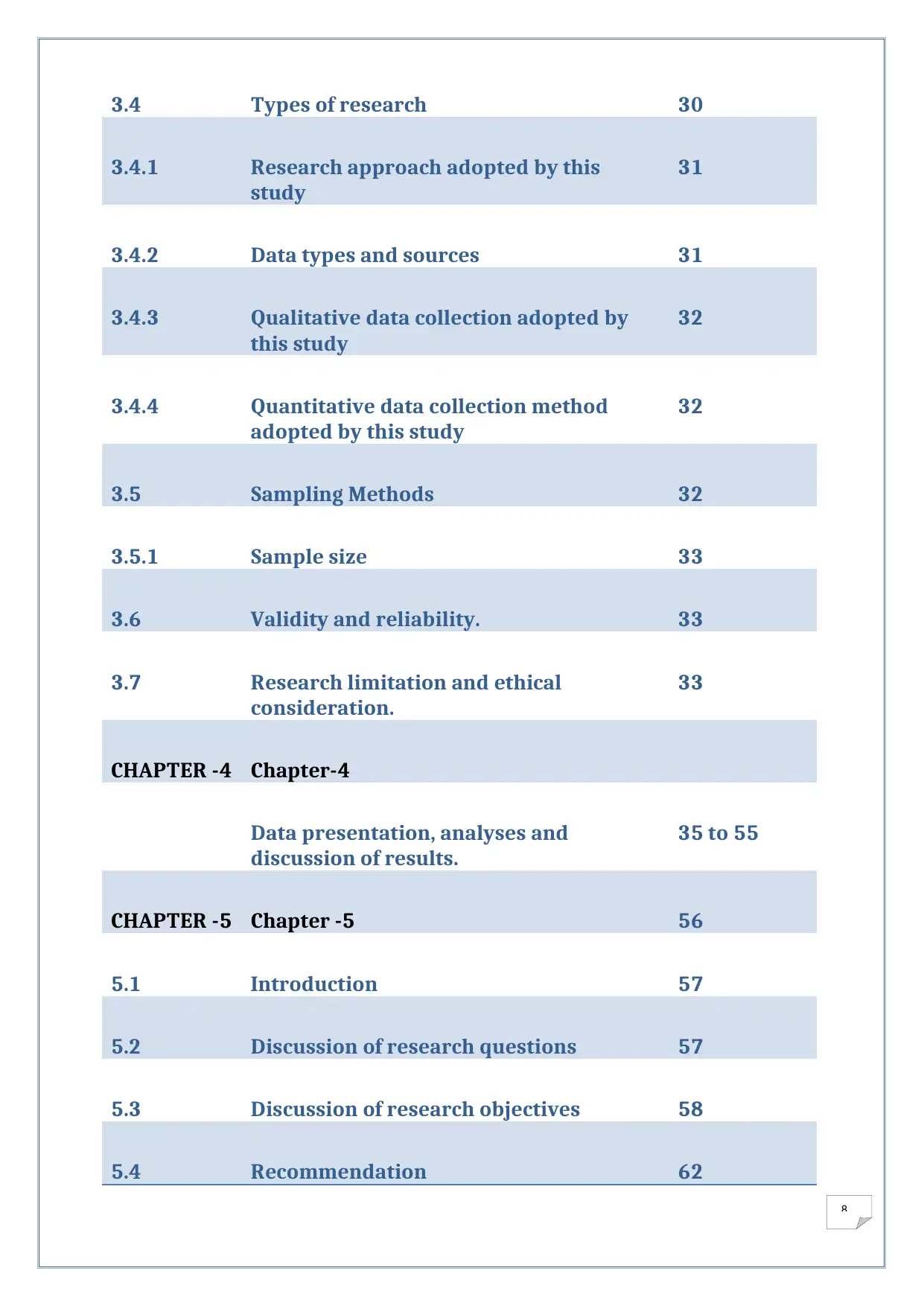
8
3.4 Types of research 30
3.4.1 Research approach adopted by this
study
31
3.4.2 Data types and sources 31
3.4.3 Qualitative data collection adopted by
this study
32
3.4.4 Quantitative data collection method
adopted by this study
32
3.5 Sampling Methods 32
3.5.1 Sample size 33
3.6 Validity and reliability. 33
3.7 Research limitation and ethical
consideration.
33
CHAPTER -4 Chapter-4
Data presentation, analyses and
discussion of results.
35 to 55
CHAPTER -5 Chapter -5 56
5.1 Introduction 57
5.2 Discussion of research questions 57
5.3 Discussion of research objectives 58
5.4 Recommendation 62
3.4 Types of research 30
3.4.1 Research approach adopted by this
study
31
3.4.2 Data types and sources 31
3.4.3 Qualitative data collection adopted by
this study
32
3.4.4 Quantitative data collection method
adopted by this study
32
3.5 Sampling Methods 32
3.5.1 Sample size 33
3.6 Validity and reliability. 33
3.7 Research limitation and ethical
consideration.
33
CHAPTER -4 Chapter-4
Data presentation, analyses and
discussion of results.
35 to 55
CHAPTER -5 Chapter -5 56
5.1 Introduction 57
5.2 Discussion of research questions 57
5.3 Discussion of research objectives 58
5.4 Recommendation 62
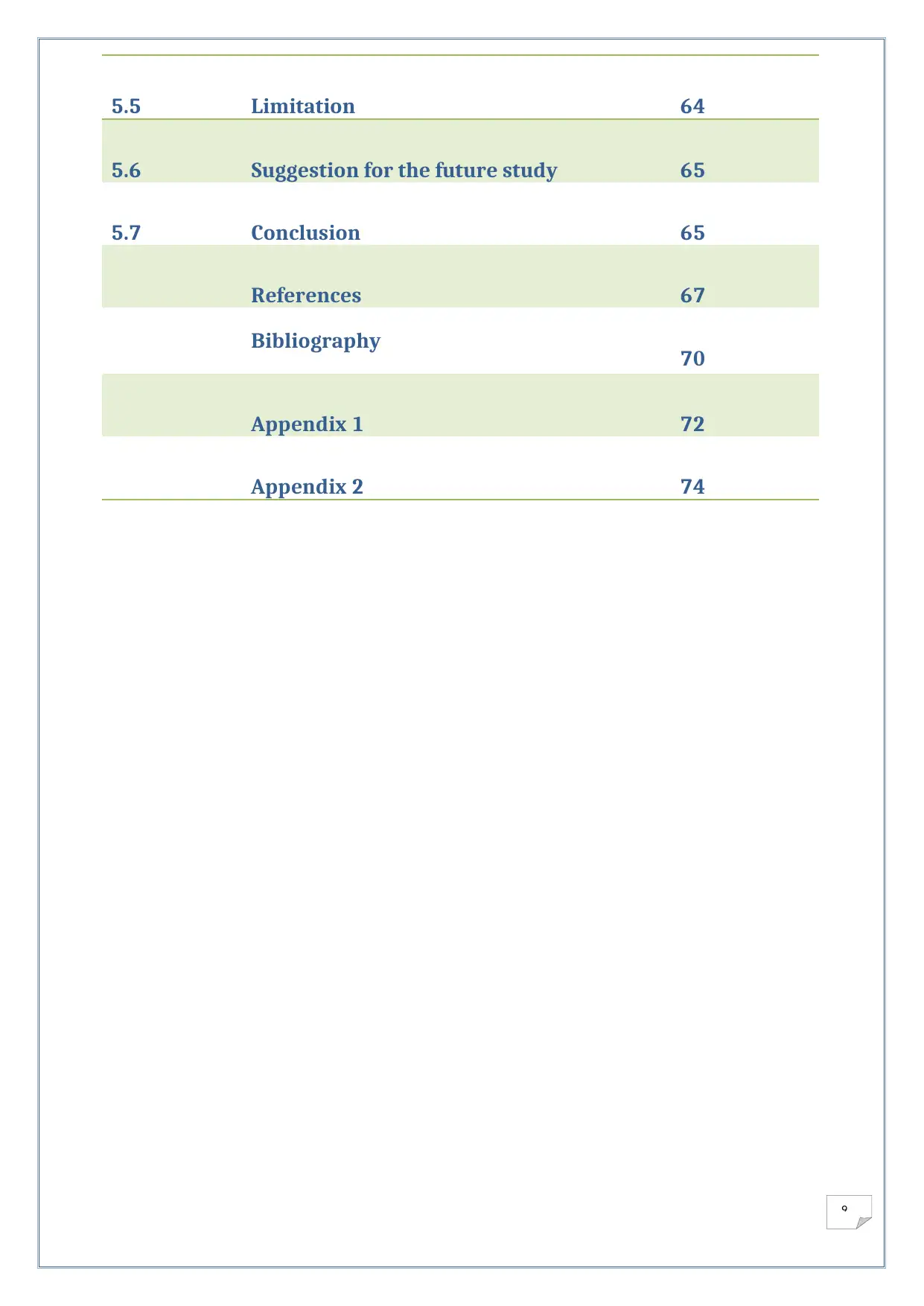
9
5.5 Limitation 64
5.6 Suggestion for the future study 65
5.7 Conclusion 65
References 67
Bibliography 70
Appendix 1 72
Appendix 2 74
5.5 Limitation 64
5.6 Suggestion for the future study 65
5.7 Conclusion 65
References 67
Bibliography 70
Appendix 1 72
Appendix 2 74

10
Chapter -1
Chapter -1
Secure Best Marks with AI Grader
Need help grading? Try our AI Grader for instant feedback on your assignments.
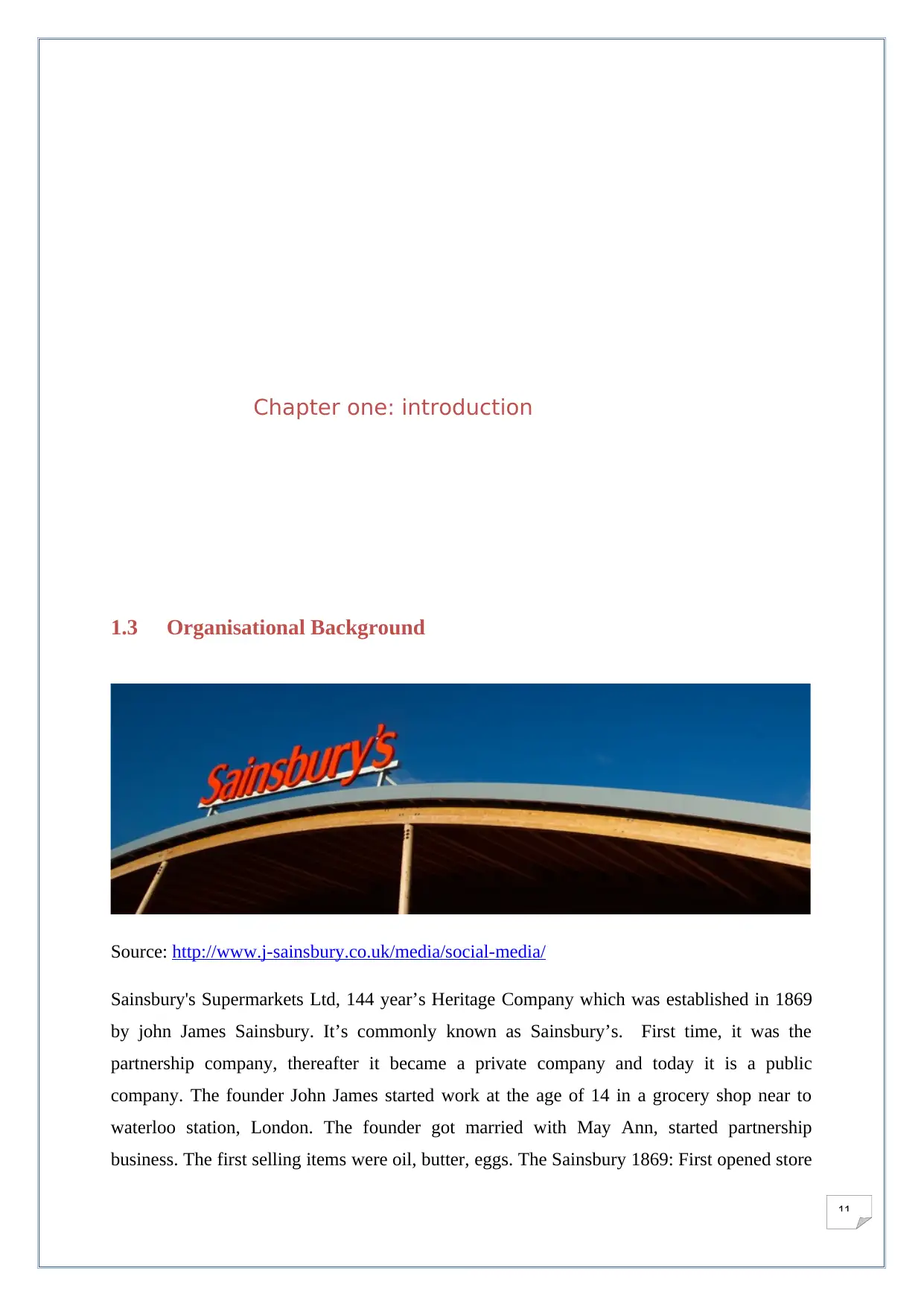
11
Chapter one: introduction
1.3 Organisational Background
Source: http://www.j-sainsbury.co.uk/media/social-media/
Sainsbury's Supermarkets Ltd, 144 year’s Heritage Company which was established in 1869
by john James Sainsbury. It’s commonly known as Sainsbury’s. First time, it was the
partnership company, thereafter it became a private company and today it is a public
company. The founder John James started work at the age of 14 in a grocery shop near to
waterloo station, London. The founder got married with May Ann, started partnership
business. The first selling items were oil, butter, eggs. The Sainsbury 1869: First opened store
Chapter one: introduction
1.3 Organisational Background
Source: http://www.j-sainsbury.co.uk/media/social-media/
Sainsbury's Supermarkets Ltd, 144 year’s Heritage Company which was established in 1869
by john James Sainsbury. It’s commonly known as Sainsbury’s. First time, it was the
partnership company, thereafter it became a private company and today it is a public
company. The founder John James started work at the age of 14 in a grocery shop near to
waterloo station, London. The founder got married with May Ann, started partnership
business. The first selling items were oil, butter, eggs. The Sainsbury 1869: First opened store
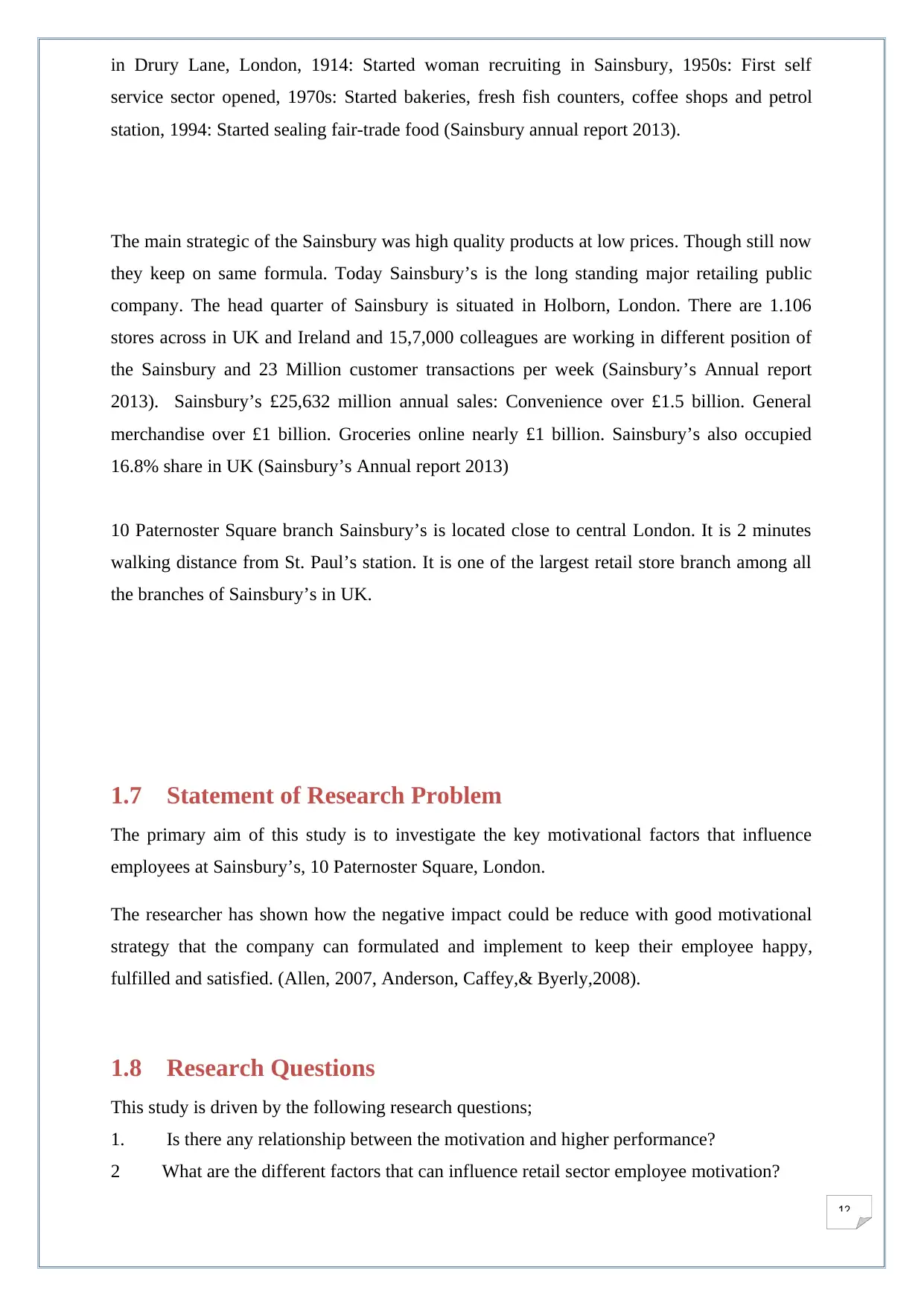
12
in Drury Lane, London, 1914: Started woman recruiting in Sainsbury, 1950s: First self
service sector opened, 1970s: Started bakeries, fresh fish counters, coffee shops and petrol
station, 1994: Started sealing fair-trade food (Sainsbury annual report 2013).
The main strategic of the Sainsbury was high quality products at low prices. Though still now
they keep on same formula. Today Sainsbury’s is the long standing major retailing public
company. The head quarter of Sainsbury is situated in Holborn, London. There are 1.106
stores across in UK and Ireland and 15,7,000 colleagues are working in different position of
the Sainsbury and 23 Million customer transactions per week (Sainsbury’s Annual report
2013). Sainsbury’s £25,632 million annual sales: Convenience over £1.5 billion. General
merchandise over £1 billion. Groceries online nearly £1 billion. Sainsbury’s also occupied
16.8% share in UK (Sainsbury’s Annual report 2013)
10 Paternoster Square branch Sainsbury’s is located close to central London. It is 2 minutes
walking distance from St. Paul’s station. It is one of the largest retail store branch among all
the branches of Sainsbury’s in UK.
1.7 Statement of Research Problem
The primary aim of this study is to investigate the key motivational factors that influence
employees at Sainsbury’s, 10 Paternoster Square, London.
The researcher has shown how the negative impact could be reduce with good motivational
strategy that the company can formulated and implement to keep their employee happy,
fulfilled and satisfied. (Allen, 2007, Anderson, Caffey,& Byerly,2008).
1.8 Research Questions
This study is driven by the following research questions;
1. Is there any relationship between the motivation and higher performance?
2 What are the different factors that can influence retail sector employee motivation?
in Drury Lane, London, 1914: Started woman recruiting in Sainsbury, 1950s: First self
service sector opened, 1970s: Started bakeries, fresh fish counters, coffee shops and petrol
station, 1994: Started sealing fair-trade food (Sainsbury annual report 2013).
The main strategic of the Sainsbury was high quality products at low prices. Though still now
they keep on same formula. Today Sainsbury’s is the long standing major retailing public
company. The head quarter of Sainsbury is situated in Holborn, London. There are 1.106
stores across in UK and Ireland and 15,7,000 colleagues are working in different position of
the Sainsbury and 23 Million customer transactions per week (Sainsbury’s Annual report
2013). Sainsbury’s £25,632 million annual sales: Convenience over £1.5 billion. General
merchandise over £1 billion. Groceries online nearly £1 billion. Sainsbury’s also occupied
16.8% share in UK (Sainsbury’s Annual report 2013)
10 Paternoster Square branch Sainsbury’s is located close to central London. It is 2 minutes
walking distance from St. Paul’s station. It is one of the largest retail store branch among all
the branches of Sainsbury’s in UK.
1.7 Statement of Research Problem
The primary aim of this study is to investigate the key motivational factors that influence
employees at Sainsbury’s, 10 Paternoster Square, London.
The researcher has shown how the negative impact could be reduce with good motivational
strategy that the company can formulated and implement to keep their employee happy,
fulfilled and satisfied. (Allen, 2007, Anderson, Caffey,& Byerly,2008).
1.8 Research Questions
This study is driven by the following research questions;
1. Is there any relationship between the motivation and higher performance?
2 What are the different factors that can influence retail sector employee motivation?
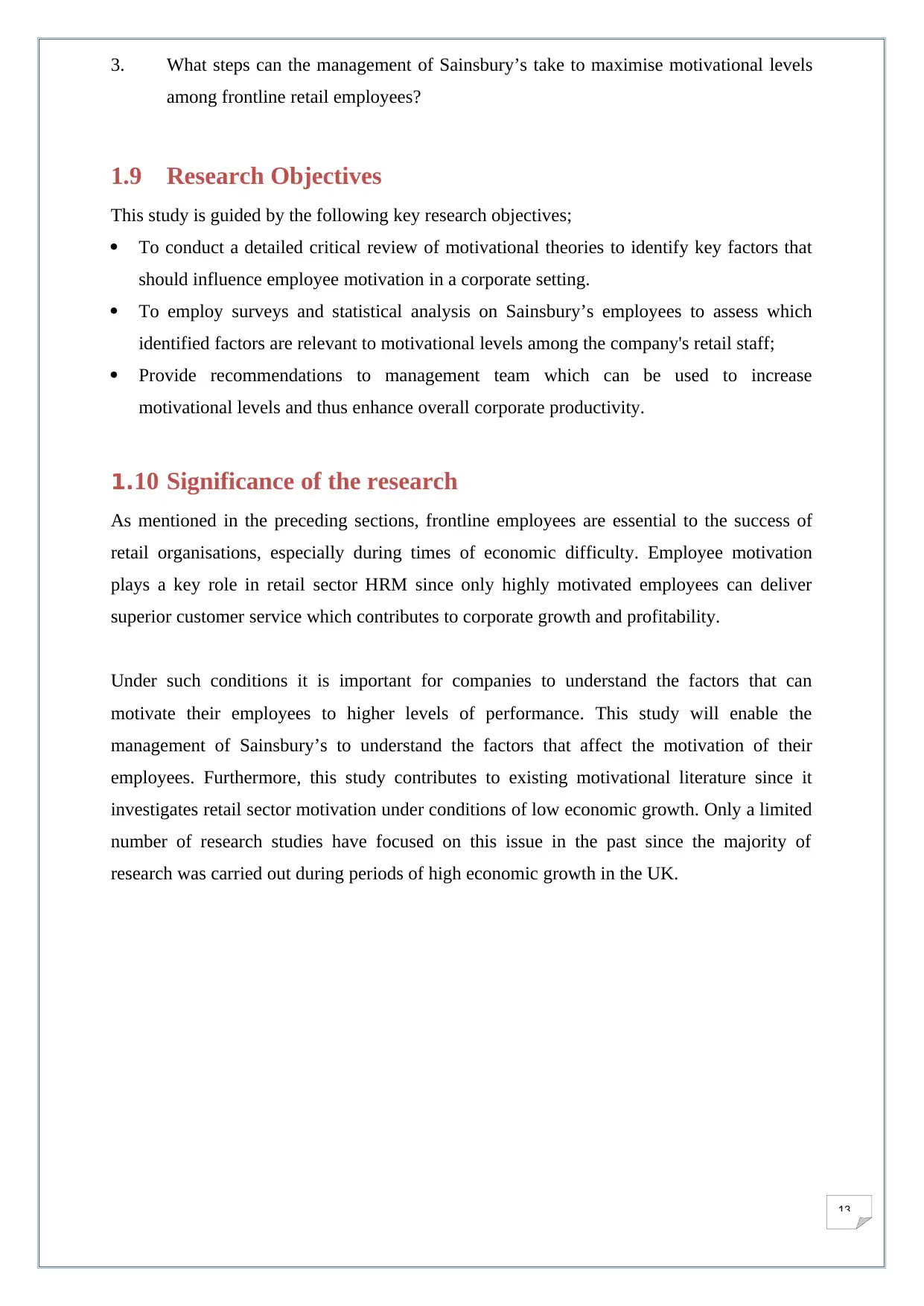
13
3. What steps can the management of Sainsbury’s take to maximise motivational levels
among frontline retail employees?
1.9 Research Objectives
This study is guided by the following key research objectives;
To conduct a detailed critical review of motivational theories to identify key factors that
should influence employee motivation in a corporate setting.
To employ surveys and statistical analysis on Sainsbury’s employees to assess which
identified factors are relevant to motivational levels among the company's retail staff;
Provide recommendations to management team which can be used to increase
motivational levels and thus enhance overall corporate productivity.
1.10 Significance of the research
As mentioned in the preceding sections, frontline employees are essential to the success of
retail organisations, especially during times of economic difficulty. Employee motivation
plays a key role in retail sector HRM since only highly motivated employees can deliver
superior customer service which contributes to corporate growth and profitability.
Under such conditions it is important for companies to understand the factors that can
motivate their employees to higher levels of performance. This study will enable the
management of Sainsbury’s to understand the factors that affect the motivation of their
employees. Furthermore, this study contributes to existing motivational literature since it
investigates retail sector motivation under conditions of low economic growth. Only a limited
number of research studies have focused on this issue in the past since the majority of
research was carried out during periods of high economic growth in the UK.
3. What steps can the management of Sainsbury’s take to maximise motivational levels
among frontline retail employees?
1.9 Research Objectives
This study is guided by the following key research objectives;
To conduct a detailed critical review of motivational theories to identify key factors that
should influence employee motivation in a corporate setting.
To employ surveys and statistical analysis on Sainsbury’s employees to assess which
identified factors are relevant to motivational levels among the company's retail staff;
Provide recommendations to management team which can be used to increase
motivational levels and thus enhance overall corporate productivity.
1.10 Significance of the research
As mentioned in the preceding sections, frontline employees are essential to the success of
retail organisations, especially during times of economic difficulty. Employee motivation
plays a key role in retail sector HRM since only highly motivated employees can deliver
superior customer service which contributes to corporate growth and profitability.
Under such conditions it is important for companies to understand the factors that can
motivate their employees to higher levels of performance. This study will enable the
management of Sainsbury’s to understand the factors that affect the motivation of their
employees. Furthermore, this study contributes to existing motivational literature since it
investigates retail sector motivation under conditions of low economic growth. Only a limited
number of research studies have focused on this issue in the past since the majority of
research was carried out during periods of high economic growth in the UK.
Paraphrase This Document
Need a fresh take? Get an instant paraphrase of this document with our AI Paraphraser
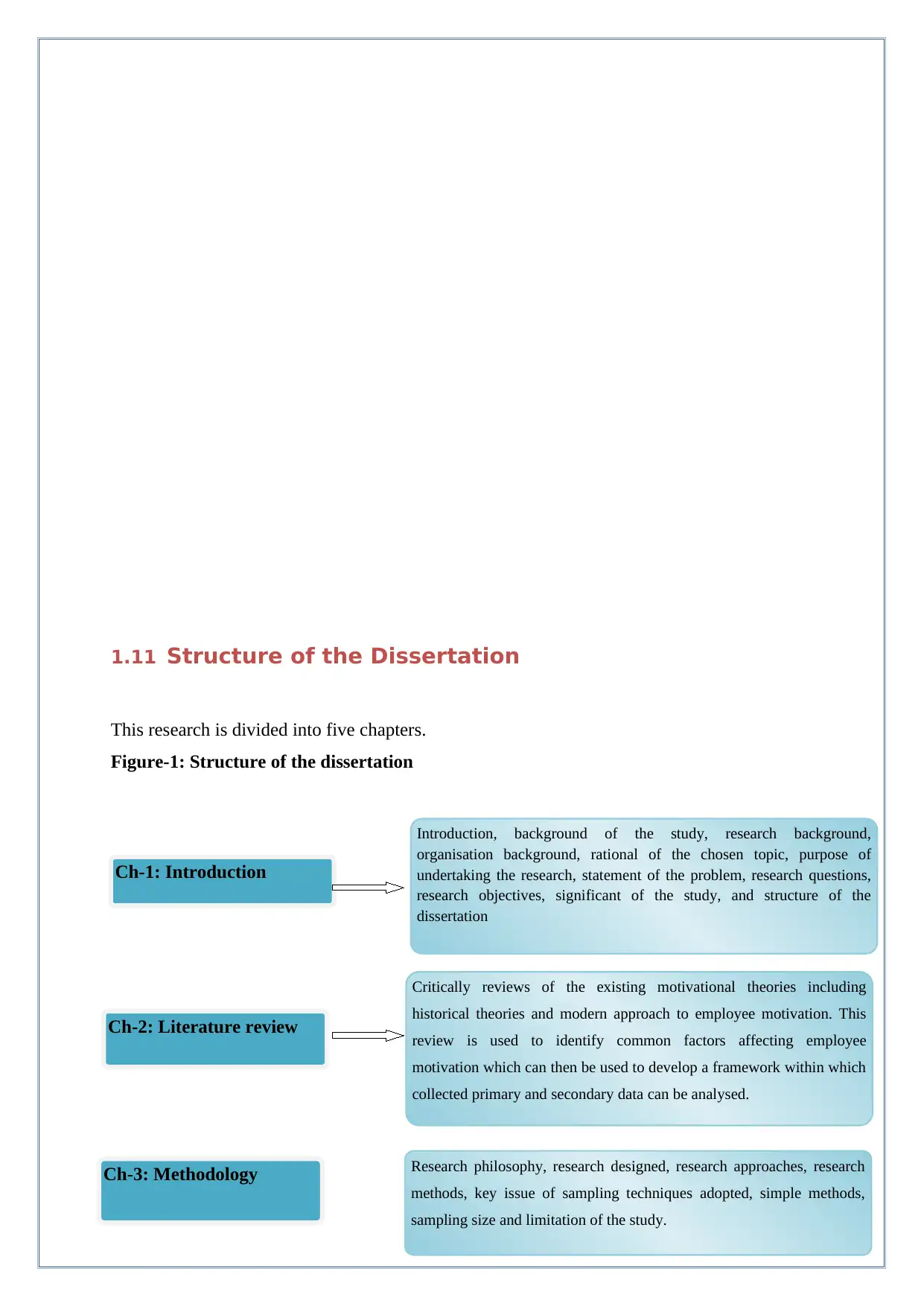
14
1.11 Structure of the Dissertation
This research is divided into five chapters.
Figure-1: Structure of the dissertation
Ch-1: Introduction
Ch-3: Methodology
Ch-2: Literature review
Introduction, background of the study, research background,
organisation background, rational of the chosen topic, purpose of
undertaking the research, statement of the problem, research questions,
research objectives, significant of the study, and structure of the
dissertation
Critically reviews of the existing motivational theories including
historical theories and modern approach to employee motivation. This
review is used to identify common factors affecting employee
motivation which can then be used to develop a framework within which
collected primary and secondary data can be analysed.
Research philosophy, research designed, research approaches, research
methods, key issue of sampling techniques adopted, simple methods,
sampling size and limitation of the study.
1.11 Structure of the Dissertation
This research is divided into five chapters.
Figure-1: Structure of the dissertation
Ch-1: Introduction
Ch-3: Methodology
Ch-2: Literature review
Introduction, background of the study, research background,
organisation background, rational of the chosen topic, purpose of
undertaking the research, statement of the problem, research questions,
research objectives, significant of the study, and structure of the
dissertation
Critically reviews of the existing motivational theories including
historical theories and modern approach to employee motivation. This
review is used to identify common factors affecting employee
motivation which can then be used to develop a framework within which
collected primary and secondary data can be analysed.
Research philosophy, research designed, research approaches, research
methods, key issue of sampling techniques adopted, simple methods,
sampling size and limitation of the study.
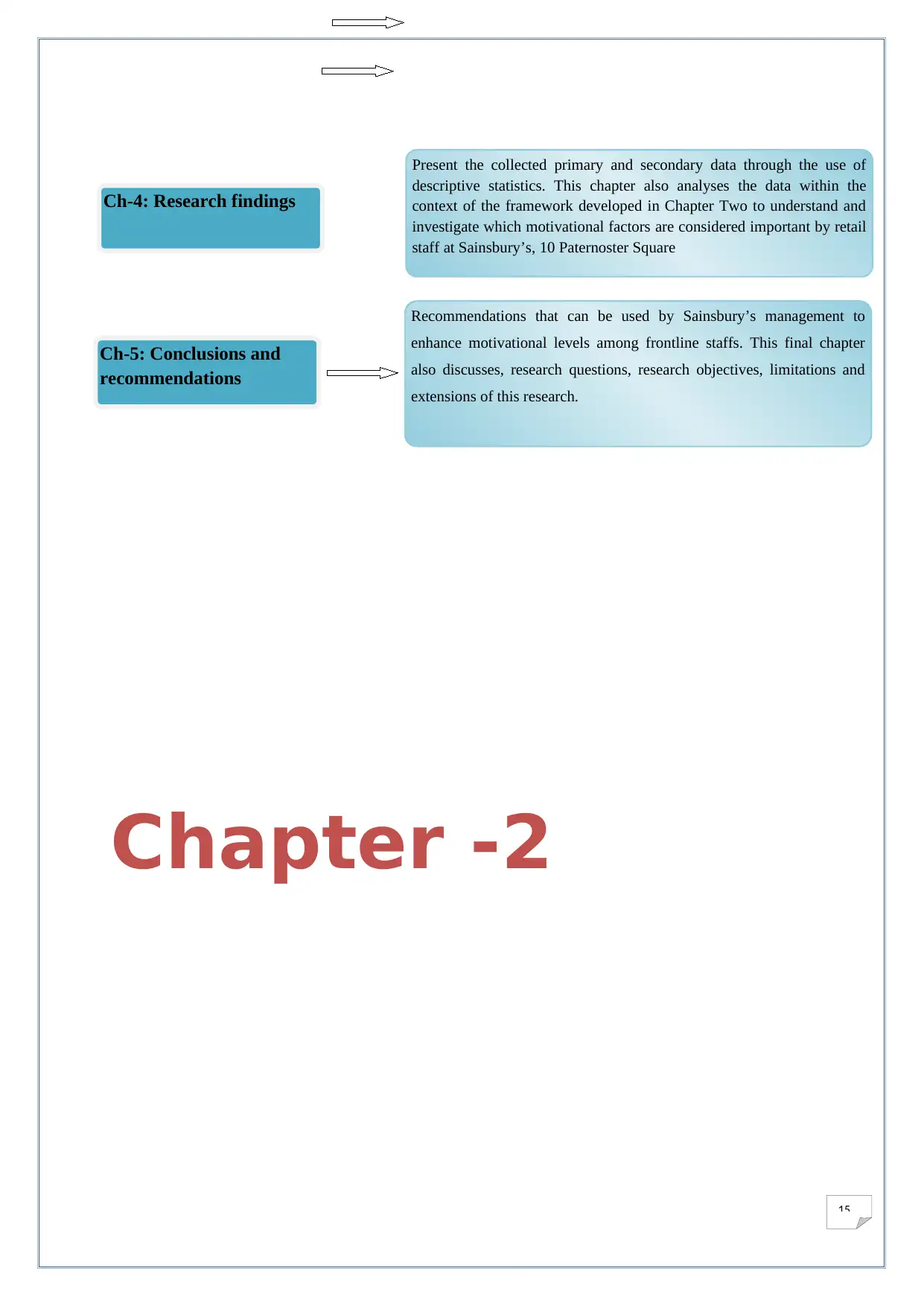
15
Chapter -2
Ch-4: Research findings
Ch-5: Conclusions and
recommendations
Recommendations that can be used by Sainsbury’s management to
enhance motivational levels among frontline staffs. This final chapter
also discusses, research questions, research objectives, limitations and
extensions of this research.
Present the collected primary and secondary data through the use of
descriptive statistics. This chapter also analyses the data within the
context of the framework developed in Chapter Two to understand and
investigate which motivational factors are considered important by retail
staff at Sainsbury’s, 10 Paternoster Square
Chapter -2
Ch-4: Research findings
Ch-5: Conclusions and
recommendations
Recommendations that can be used by Sainsbury’s management to
enhance motivational levels among frontline staffs. This final chapter
also discusses, research questions, research objectives, limitations and
extensions of this research.
Present the collected primary and secondary data through the use of
descriptive statistics. This chapter also analyses the data within the
context of the framework developed in Chapter Two to understand and
investigate which motivational factors are considered important by retail
staff at Sainsbury’s, 10 Paternoster Square
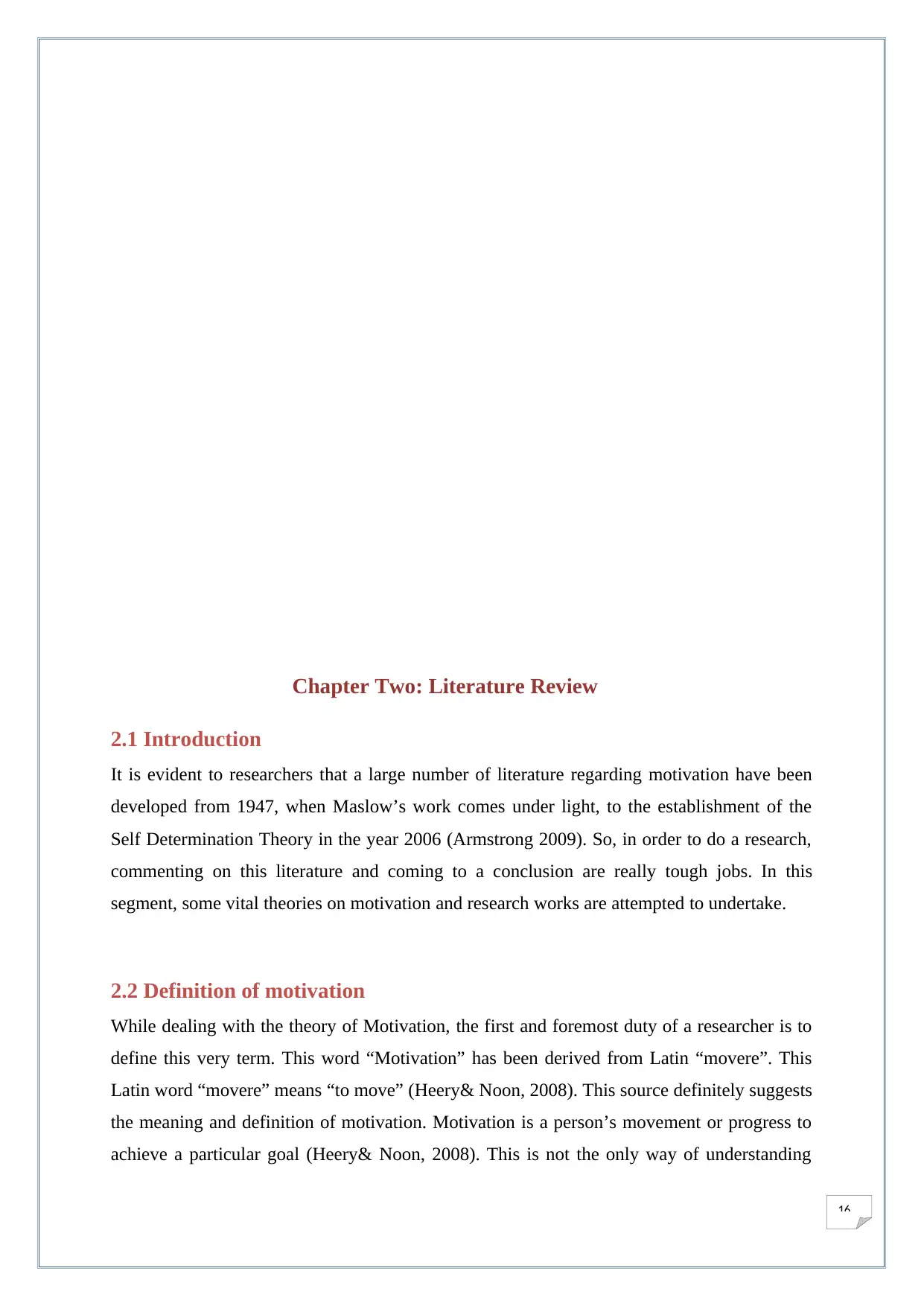
16
Chapter Two: Literature Review
2.1 Introduction
It is evident to researchers that a large number of literature regarding motivation have been
developed from 1947, when Maslow’s work comes under light, to the establishment of the
Self Determination Theory in the year 2006 (Armstrong 2009). So, in order to do a research,
commenting on this literature and coming to a conclusion are really tough jobs. In this
segment, some vital theories on motivation and research works are attempted to undertake.
2.2 Definition of motivation
While dealing with the theory of Motivation, the first and foremost duty of a researcher is to
define this very term. This word “Motivation” has been derived from Latin “movere”. This
Latin word “movere” means “to move” (Heery& Noon, 2008). This source definitely suggests
the meaning and definition of motivation. Motivation is a person’s movement or progress to
achieve a particular goal (Heery& Noon, 2008). This is not the only way of understanding
Chapter Two: Literature Review
2.1 Introduction
It is evident to researchers that a large number of literature regarding motivation have been
developed from 1947, when Maslow’s work comes under light, to the establishment of the
Self Determination Theory in the year 2006 (Armstrong 2009). So, in order to do a research,
commenting on this literature and coming to a conclusion are really tough jobs. In this
segment, some vital theories on motivation and research works are attempted to undertake.
2.2 Definition of motivation
While dealing with the theory of Motivation, the first and foremost duty of a researcher is to
define this very term. This word “Motivation” has been derived from Latin “movere”. This
Latin word “movere” means “to move” (Heery& Noon, 2008). This source definitely suggests
the meaning and definition of motivation. Motivation is a person’s movement or progress to
achieve a particular goal (Heery& Noon, 2008). This is not the only way of understanding
Secure Best Marks with AI Grader
Need help grading? Try our AI Grader for instant feedback on your assignments.
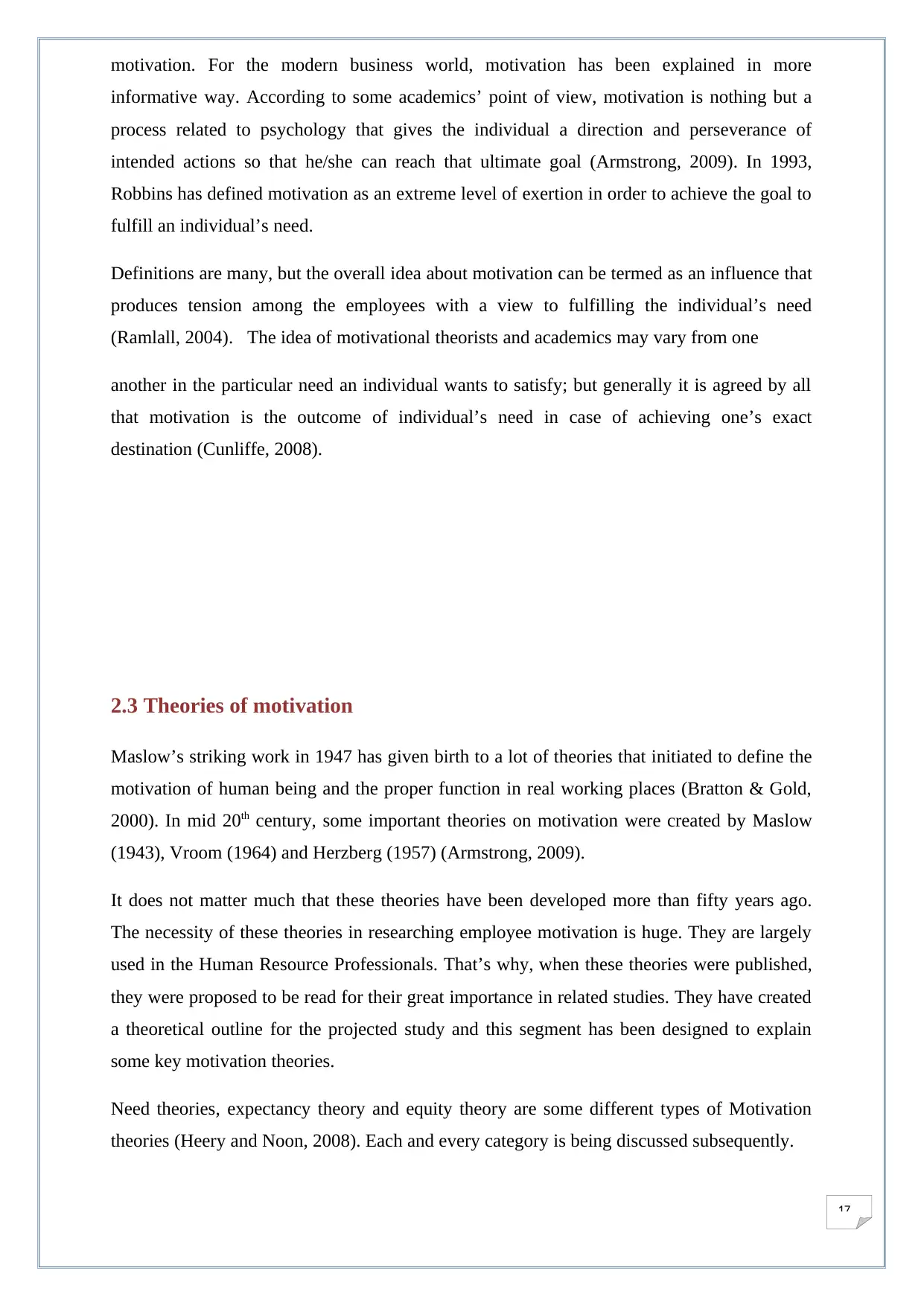
17
motivation. For the modern business world, motivation has been explained in more
informative way. According to some academics’ point of view, motivation is nothing but a
process related to psychology that gives the individual a direction and perseverance of
intended actions so that he/she can reach that ultimate goal (Armstrong, 2009). In 1993,
Robbins has defined motivation as an extreme level of exertion in order to achieve the goal to
fulfill an individual’s need.
Definitions are many, but the overall idea about motivation can be termed as an influence that
produces tension among the employees with a view to fulfilling the individual’s need
(Ramlall, 2004). The idea of motivational theorists and academics may vary from one
another in the particular need an individual wants to satisfy; but generally it is agreed by all
that motivation is the outcome of individual’s need in case of achieving one’s exact
destination (Cunliffe, 2008).
2.3 Theories of motivation
Maslow’s striking work in 1947 has given birth to a lot of theories that initiated to define the
motivation of human being and the proper function in real working places (Bratton & Gold,
2000). In mid 20th century, some important theories on motivation were created by Maslow
(1943), Vroom (1964) and Herzberg (1957) (Armstrong, 2009).
It does not matter much that these theories have been developed more than fifty years ago.
The necessity of these theories in researching employee motivation is huge. They are largely
used in the Human Resource Professionals. That’s why, when these theories were published,
they were proposed to be read for their great importance in related studies. They have created
a theoretical outline for the projected study and this segment has been designed to explain
some key motivation theories.
Need theories, expectancy theory and equity theory are some different types of Motivation
theories (Heery and Noon, 2008). Each and every category is being discussed subsequently.
motivation. For the modern business world, motivation has been explained in more
informative way. According to some academics’ point of view, motivation is nothing but a
process related to psychology that gives the individual a direction and perseverance of
intended actions so that he/she can reach that ultimate goal (Armstrong, 2009). In 1993,
Robbins has defined motivation as an extreme level of exertion in order to achieve the goal to
fulfill an individual’s need.
Definitions are many, but the overall idea about motivation can be termed as an influence that
produces tension among the employees with a view to fulfilling the individual’s need
(Ramlall, 2004). The idea of motivational theorists and academics may vary from one
another in the particular need an individual wants to satisfy; but generally it is agreed by all
that motivation is the outcome of individual’s need in case of achieving one’s exact
destination (Cunliffe, 2008).
2.3 Theories of motivation
Maslow’s striking work in 1947 has given birth to a lot of theories that initiated to define the
motivation of human being and the proper function in real working places (Bratton & Gold,
2000). In mid 20th century, some important theories on motivation were created by Maslow
(1943), Vroom (1964) and Herzberg (1957) (Armstrong, 2009).
It does not matter much that these theories have been developed more than fifty years ago.
The necessity of these theories in researching employee motivation is huge. They are largely
used in the Human Resource Professionals. That’s why, when these theories were published,
they were proposed to be read for their great importance in related studies. They have created
a theoretical outline for the projected study and this segment has been designed to explain
some key motivation theories.
Need theories, expectancy theory and equity theory are some different types of Motivation
theories (Heery and Noon, 2008). Each and every category is being discussed subsequently.
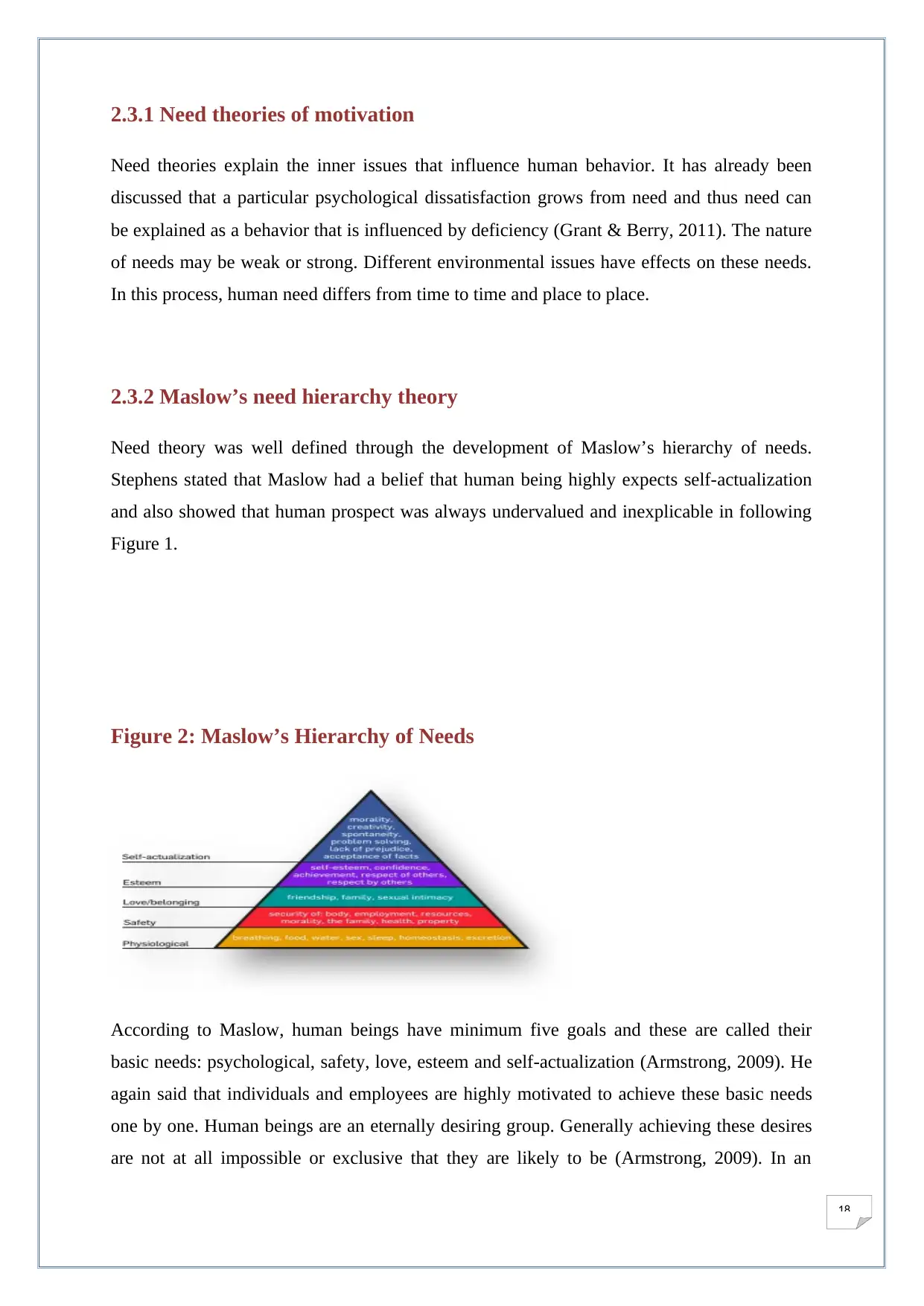
18
2.3.1 Need theories of motivation
Need theories explain the inner issues that influence human behavior. It has already been
discussed that a particular psychological dissatisfaction grows from need and thus need can
be explained as a behavior that is influenced by deficiency (Grant & Berry, 2011). The nature
of needs may be weak or strong. Different environmental issues have effects on these needs.
In this process, human need differs from time to time and place to place.
2.3.2 Maslow’s need hierarchy theory
Need theory was well defined through the development of Maslow’s hierarchy of needs.
Stephens stated that Maslow had a belief that human being highly expects self-actualization
and also showed that human prospect was always undervalued and inexplicable in following
Figure 1.
Figure 2: Maslow’s Hierarchy of Needs
According to Maslow, human beings have minimum five goals and these are called their
basic needs: psychological, safety, love, esteem and self-actualization (Armstrong, 2009). He
again said that individuals and employees are highly motivated to achieve these basic needs
one by one. Human beings are an eternally desiring group. Generally achieving these desires
are not at all impossible or exclusive that they are likely to be (Armstrong, 2009). In an
2.3.1 Need theories of motivation
Need theories explain the inner issues that influence human behavior. It has already been
discussed that a particular psychological dissatisfaction grows from need and thus need can
be explained as a behavior that is influenced by deficiency (Grant & Berry, 2011). The nature
of needs may be weak or strong. Different environmental issues have effects on these needs.
In this process, human need differs from time to time and place to place.
2.3.2 Maslow’s need hierarchy theory
Need theory was well defined through the development of Maslow’s hierarchy of needs.
Stephens stated that Maslow had a belief that human being highly expects self-actualization
and also showed that human prospect was always undervalued and inexplicable in following
Figure 1.
Figure 2: Maslow’s Hierarchy of Needs
According to Maslow, human beings have minimum five goals and these are called their
basic needs: psychological, safety, love, esteem and self-actualization (Armstrong, 2009). He
again said that individuals and employees are highly motivated to achieve these basic needs
one by one. Human beings are an eternally desiring group. Generally achieving these desires
are not at all impossible or exclusive that they are likely to be (Armstrong, 2009). In an
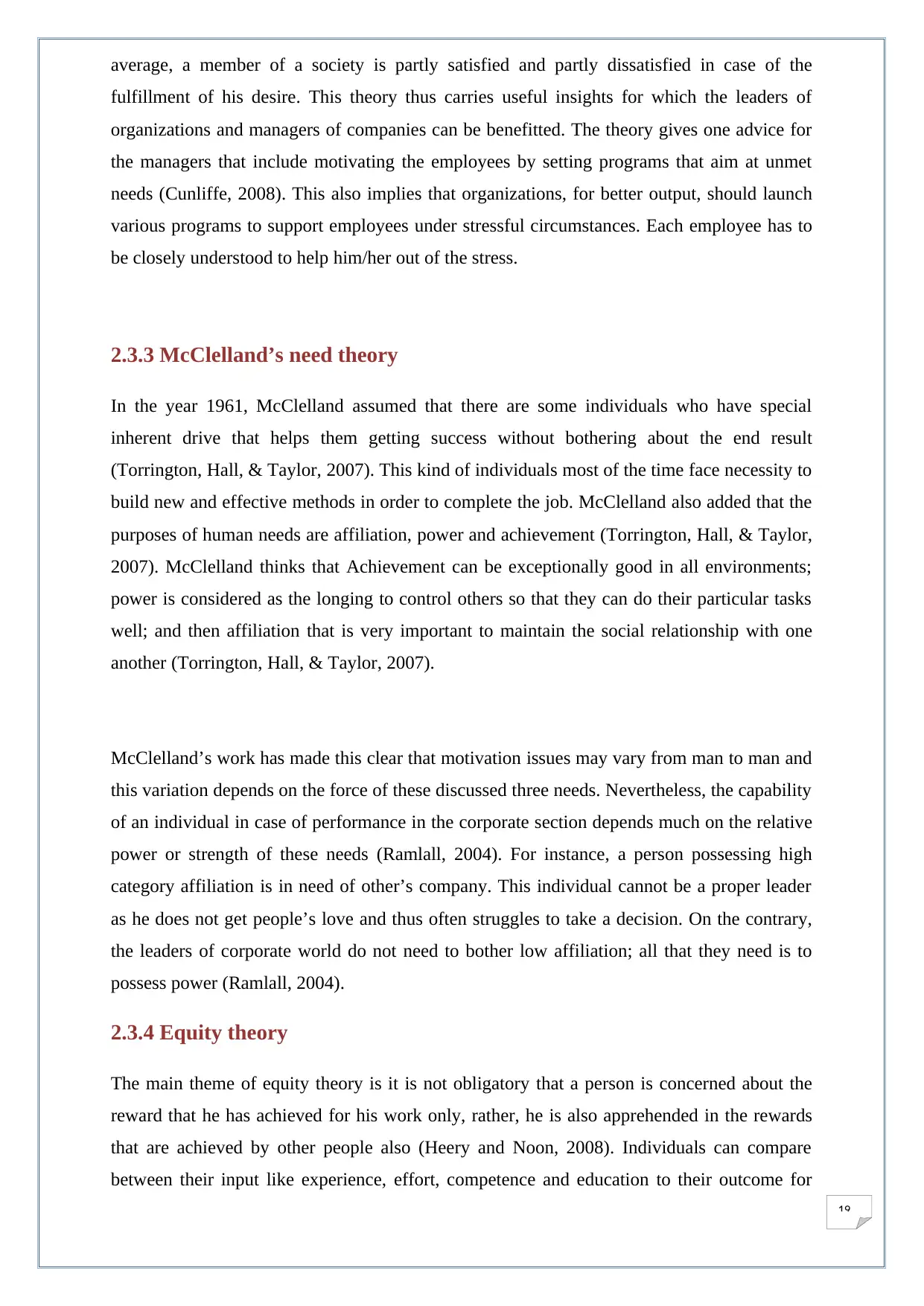
19
average, a member of a society is partly satisfied and partly dissatisfied in case of the
fulfillment of his desire. This theory thus carries useful insights for which the leaders of
organizations and managers of companies can be benefitted. The theory gives one advice for
the managers that include motivating the employees by setting programs that aim at unmet
needs (Cunliffe, 2008). This also implies that organizations, for better output, should launch
various programs to support employees under stressful circumstances. Each employee has to
be closely understood to help him/her out of the stress.
2.3.3 McClelland’s need theory
In the year 1961, McClelland assumed that there are some individuals who have special
inherent drive that helps them getting success without bothering about the end result
(Torrington, Hall, & Taylor, 2007). This kind of individuals most of the time face necessity to
build new and effective methods in order to complete the job. McClelland also added that the
purposes of human needs are affiliation, power and achievement (Torrington, Hall, & Taylor,
2007). McClelland thinks that Achievement can be exceptionally good in all environments;
power is considered as the longing to control others so that they can do their particular tasks
well; and then affiliation that is very important to maintain the social relationship with one
another (Torrington, Hall, & Taylor, 2007).
McClelland’s work has made this clear that motivation issues may vary from man to man and
this variation depends on the force of these discussed three needs. Nevertheless, the capability
of an individual in case of performance in the corporate section depends much on the relative
power or strength of these needs (Ramlall, 2004). For instance, a person possessing high
category affiliation is in need of other’s company. This individual cannot be a proper leader
as he does not get people’s love and thus often struggles to take a decision. On the contrary,
the leaders of corporate world do not need to bother low affiliation; all that they need is to
possess power (Ramlall, 2004).
2.3.4 Equity theory
The main theme of equity theory is it is not obligatory that a person is concerned about the
reward that he has achieved for his work only, rather, he is also apprehended in the rewards
that are achieved by other people also (Heery and Noon, 2008). Individuals can compare
between their input like experience, effort, competence and education to their outcome for
average, a member of a society is partly satisfied and partly dissatisfied in case of the
fulfillment of his desire. This theory thus carries useful insights for which the leaders of
organizations and managers of companies can be benefitted. The theory gives one advice for
the managers that include motivating the employees by setting programs that aim at unmet
needs (Cunliffe, 2008). This also implies that organizations, for better output, should launch
various programs to support employees under stressful circumstances. Each employee has to
be closely understood to help him/her out of the stress.
2.3.3 McClelland’s need theory
In the year 1961, McClelland assumed that there are some individuals who have special
inherent drive that helps them getting success without bothering about the end result
(Torrington, Hall, & Taylor, 2007). This kind of individuals most of the time face necessity to
build new and effective methods in order to complete the job. McClelland also added that the
purposes of human needs are affiliation, power and achievement (Torrington, Hall, & Taylor,
2007). McClelland thinks that Achievement can be exceptionally good in all environments;
power is considered as the longing to control others so that they can do their particular tasks
well; and then affiliation that is very important to maintain the social relationship with one
another (Torrington, Hall, & Taylor, 2007).
McClelland’s work has made this clear that motivation issues may vary from man to man and
this variation depends on the force of these discussed three needs. Nevertheless, the capability
of an individual in case of performance in the corporate section depends much on the relative
power or strength of these needs (Ramlall, 2004). For instance, a person possessing high
category affiliation is in need of other’s company. This individual cannot be a proper leader
as he does not get people’s love and thus often struggles to take a decision. On the contrary,
the leaders of corporate world do not need to bother low affiliation; all that they need is to
possess power (Ramlall, 2004).
2.3.4 Equity theory
The main theme of equity theory is it is not obligatory that a person is concerned about the
reward that he has achieved for his work only, rather, he is also apprehended in the rewards
that are achieved by other people also (Heery and Noon, 2008). Individuals can compare
between their input like experience, effort, competence and education to their outcome for
Paraphrase This Document
Need a fresh take? Get an instant paraphrase of this document with our AI Paraphraser
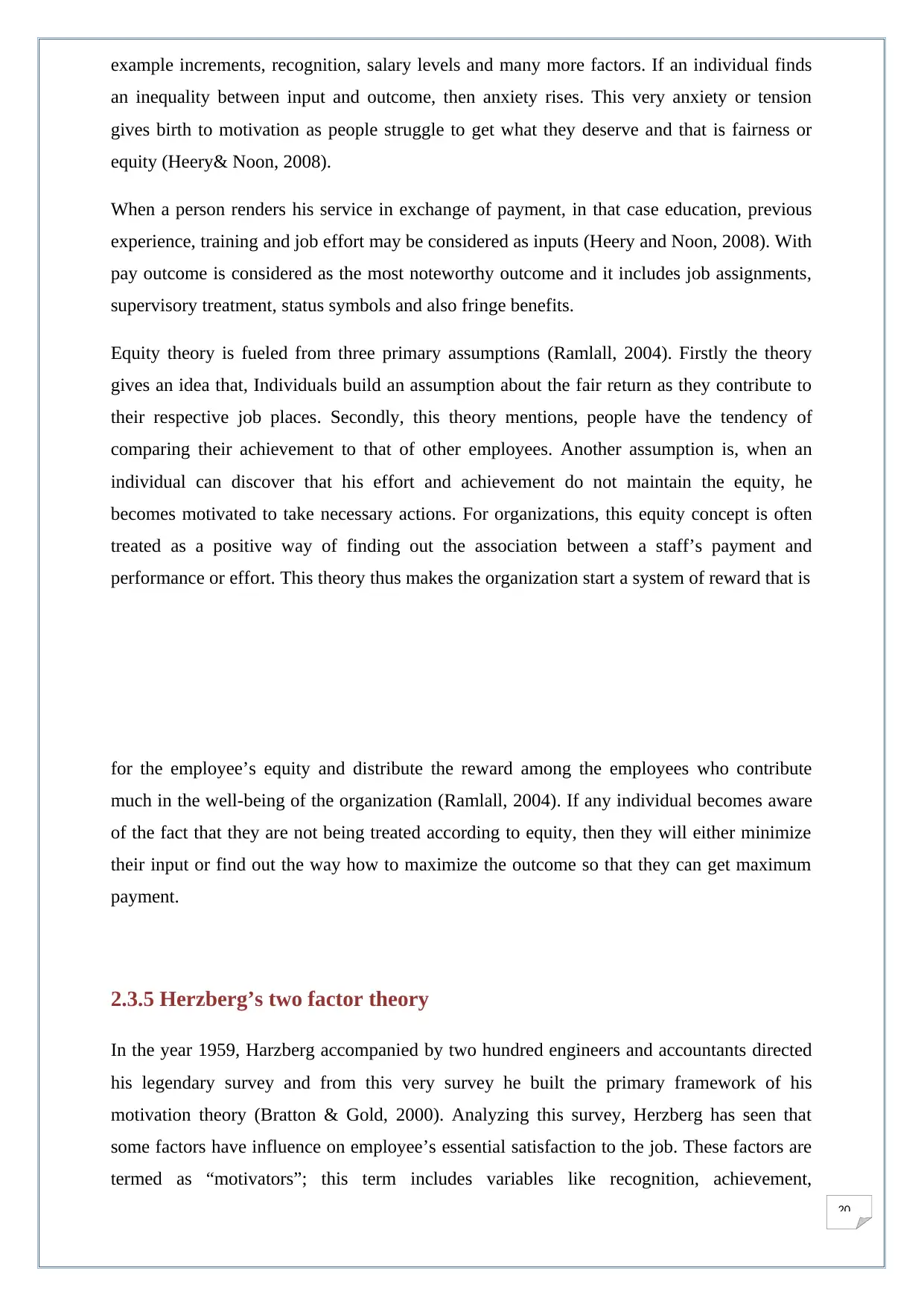
20
example increments, recognition, salary levels and many more factors. If an individual finds
an inequality between input and outcome, then anxiety rises. This very anxiety or tension
gives birth to motivation as people struggle to get what they deserve and that is fairness or
equity (Heery& Noon, 2008).
When a person renders his service in exchange of payment, in that case education, previous
experience, training and job effort may be considered as inputs (Heery and Noon, 2008). With
pay outcome is considered as the most noteworthy outcome and it includes job assignments,
supervisory treatment, status symbols and also fringe benefits.
Equity theory is fueled from three primary assumptions (Ramlall, 2004). Firstly the theory
gives an idea that, Individuals build an assumption about the fair return as they contribute to
their respective job places. Secondly, this theory mentions, people have the tendency of
comparing their achievement to that of other employees. Another assumption is, when an
individual can discover that his effort and achievement do not maintain the equity, he
becomes motivated to take necessary actions. For organizations, this equity concept is often
treated as a positive way of finding out the association between a staff’s payment and
performance or effort. This theory thus makes the organization start a system of reward that is
for the employee’s equity and distribute the reward among the employees who contribute
much in the well-being of the organization (Ramlall, 2004). If any individual becomes aware
of the fact that they are not being treated according to equity, then they will either minimize
their input or find out the way how to maximize the outcome so that they can get maximum
payment.
2.3.5 Herzberg’s two factor theory
In the year 1959, Harzberg accompanied by two hundred engineers and accountants directed
his legendary survey and from this very survey he built the primary framework of his
motivation theory (Bratton & Gold, 2000). Analyzing this survey, Herzberg has seen that
some factors have influence on employee’s essential satisfaction to the job. These factors are
termed as “motivators”; this term includes variables like recognition, achievement,
example increments, recognition, salary levels and many more factors. If an individual finds
an inequality between input and outcome, then anxiety rises. This very anxiety or tension
gives birth to motivation as people struggle to get what they deserve and that is fairness or
equity (Heery& Noon, 2008).
When a person renders his service in exchange of payment, in that case education, previous
experience, training and job effort may be considered as inputs (Heery and Noon, 2008). With
pay outcome is considered as the most noteworthy outcome and it includes job assignments,
supervisory treatment, status symbols and also fringe benefits.
Equity theory is fueled from three primary assumptions (Ramlall, 2004). Firstly the theory
gives an idea that, Individuals build an assumption about the fair return as they contribute to
their respective job places. Secondly, this theory mentions, people have the tendency of
comparing their achievement to that of other employees. Another assumption is, when an
individual can discover that his effort and achievement do not maintain the equity, he
becomes motivated to take necessary actions. For organizations, this equity concept is often
treated as a positive way of finding out the association between a staff’s payment and
performance or effort. This theory thus makes the organization start a system of reward that is
for the employee’s equity and distribute the reward among the employees who contribute
much in the well-being of the organization (Ramlall, 2004). If any individual becomes aware
of the fact that they are not being treated according to equity, then they will either minimize
their input or find out the way how to maximize the outcome so that they can get maximum
payment.
2.3.5 Herzberg’s two factor theory
In the year 1959, Harzberg accompanied by two hundred engineers and accountants directed
his legendary survey and from this very survey he built the primary framework of his
motivation theory (Bratton & Gold, 2000). Analyzing this survey, Herzberg has seen that
some factors have influence on employee’s essential satisfaction to the job. These factors are
termed as “motivators”; this term includes variables like recognition, achievement,
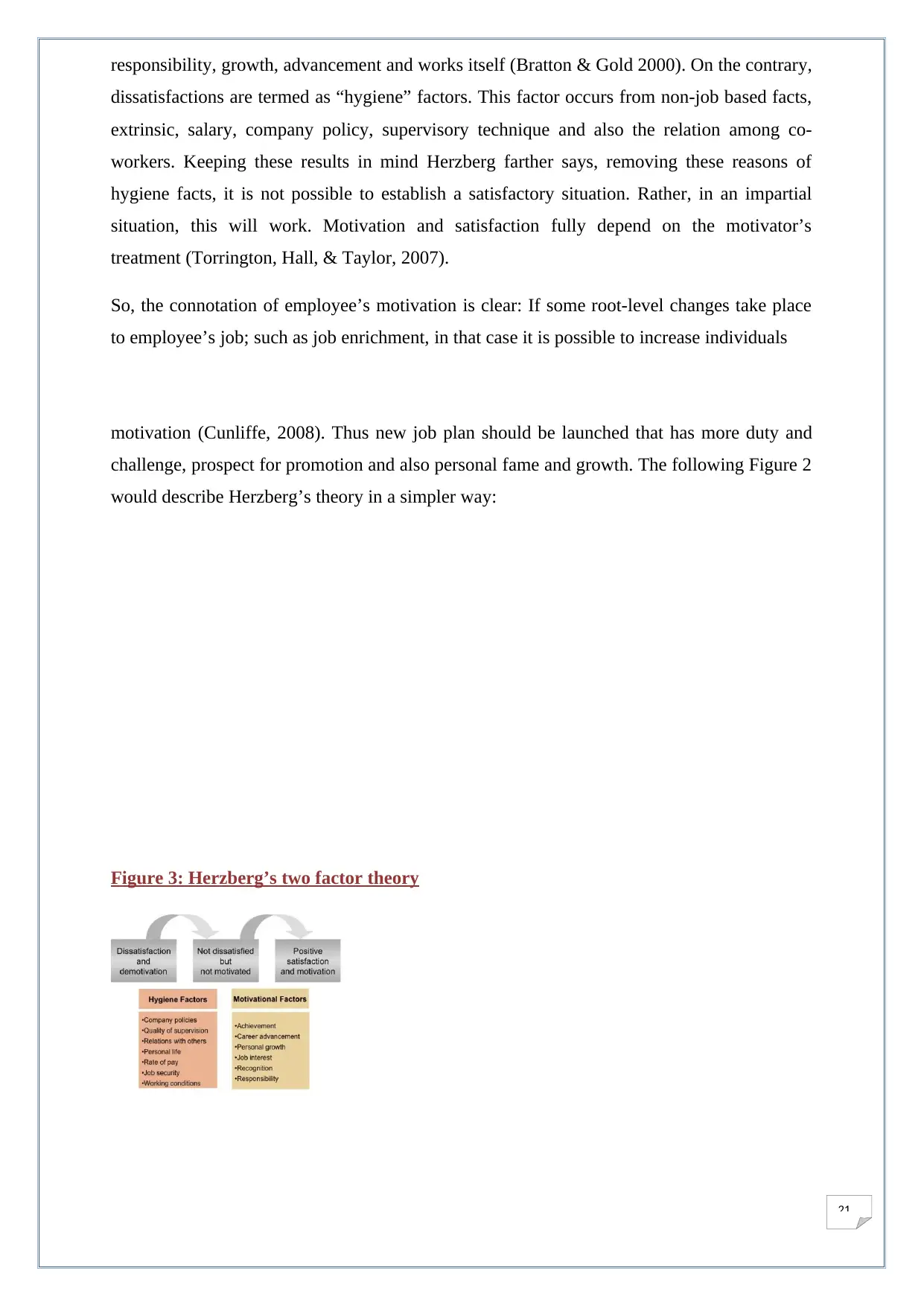
21
responsibility, growth, advancement and works itself (Bratton & Gold 2000). On the contrary,
dissatisfactions are termed as “hygiene” factors. This factor occurs from non-job based facts,
extrinsic, salary, company policy, supervisory technique and also the relation among co-
workers. Keeping these results in mind Herzberg farther says, removing these reasons of
hygiene facts, it is not possible to establish a satisfactory situation. Rather, in an impartial
situation, this will work. Motivation and satisfaction fully depend on the motivator’s
treatment (Torrington, Hall, & Taylor, 2007).
So, the connotation of employee’s motivation is clear: If some root-level changes take place
to employee’s job; such as job enrichment, in that case it is possible to increase individuals
motivation (Cunliffe, 2008). Thus new job plan should be launched that has more duty and
challenge, prospect for promotion and also personal fame and growth. The following Figure 2
would describe Herzberg’s theory in a simpler way:
Figure 3: Herzberg’s two factor theory
responsibility, growth, advancement and works itself (Bratton & Gold 2000). On the contrary,
dissatisfactions are termed as “hygiene” factors. This factor occurs from non-job based facts,
extrinsic, salary, company policy, supervisory technique and also the relation among co-
workers. Keeping these results in mind Herzberg farther says, removing these reasons of
hygiene facts, it is not possible to establish a satisfactory situation. Rather, in an impartial
situation, this will work. Motivation and satisfaction fully depend on the motivator’s
treatment (Torrington, Hall, & Taylor, 2007).
So, the connotation of employee’s motivation is clear: If some root-level changes take place
to employee’s job; such as job enrichment, in that case it is possible to increase individuals
motivation (Cunliffe, 2008). Thus new job plan should be launched that has more duty and
challenge, prospect for promotion and also personal fame and growth. The following Figure 2
would describe Herzberg’s theory in a simpler way:
Figure 3: Herzberg’s two factor theory
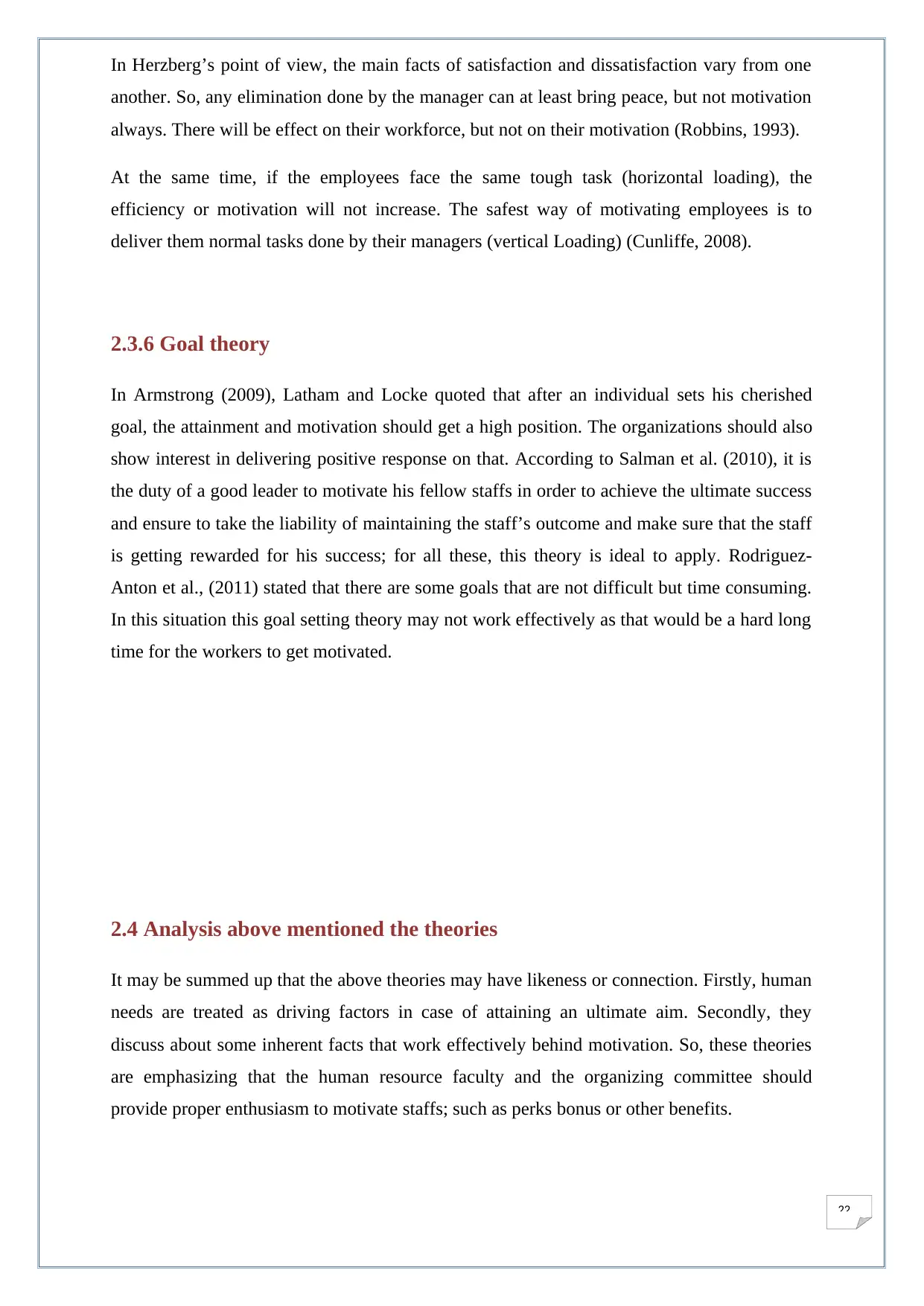
22
In Herzberg’s point of view, the main facts of satisfaction and dissatisfaction vary from one
another. So, any elimination done by the manager can at least bring peace, but not motivation
always. There will be effect on their workforce, but not on their motivation (Robbins, 1993).
At the same time, if the employees face the same tough task (horizontal loading), the
efficiency or motivation will not increase. The safest way of motivating employees is to
deliver them normal tasks done by their managers (vertical Loading) (Cunliffe, 2008).
2.3.6 Goal theory
In Armstrong (2009), Latham and Locke quoted that after an individual sets his cherished
goal, the attainment and motivation should get a high position. The organizations should also
show interest in delivering positive response on that. According to Salman et al. (2010), it is
the duty of a good leader to motivate his fellow staffs in order to achieve the ultimate success
and ensure to take the liability of maintaining the staff’s outcome and make sure that the staff
is getting rewarded for his success; for all these, this theory is ideal to apply. Rodriguez-
Anton et al., (2011) stated that there are some goals that are not difficult but time consuming.
In this situation this goal setting theory may not work effectively as that would be a hard long
time for the workers to get motivated.
2.4 Analysis above mentioned the theories
It may be summed up that the above theories may have likeness or connection. Firstly, human
needs are treated as driving factors in case of attaining an ultimate aim. Secondly, they
discuss about some inherent facts that work effectively behind motivation. So, these theories
are emphasizing that the human resource faculty and the organizing committee should
provide proper enthusiasm to motivate staffs; such as perks bonus or other benefits.
In Herzberg’s point of view, the main facts of satisfaction and dissatisfaction vary from one
another. So, any elimination done by the manager can at least bring peace, but not motivation
always. There will be effect on their workforce, but not on their motivation (Robbins, 1993).
At the same time, if the employees face the same tough task (horizontal loading), the
efficiency or motivation will not increase. The safest way of motivating employees is to
deliver them normal tasks done by their managers (vertical Loading) (Cunliffe, 2008).
2.3.6 Goal theory
In Armstrong (2009), Latham and Locke quoted that after an individual sets his cherished
goal, the attainment and motivation should get a high position. The organizations should also
show interest in delivering positive response on that. According to Salman et al. (2010), it is
the duty of a good leader to motivate his fellow staffs in order to achieve the ultimate success
and ensure to take the liability of maintaining the staff’s outcome and make sure that the staff
is getting rewarded for his success; for all these, this theory is ideal to apply. Rodriguez-
Anton et al., (2011) stated that there are some goals that are not difficult but time consuming.
In this situation this goal setting theory may not work effectively as that would be a hard long
time for the workers to get motivated.
2.4 Analysis above mentioned the theories
It may be summed up that the above theories may have likeness or connection. Firstly, human
needs are treated as driving factors in case of attaining an ultimate aim. Secondly, they
discuss about some inherent facts that work effectively behind motivation. So, these theories
are emphasizing that the human resource faculty and the organizing committee should
provide proper enthusiasm to motivate staffs; such as perks bonus or other benefits.
Secure Best Marks with AI Grader
Need help grading? Try our AI Grader for instant feedback on your assignments.
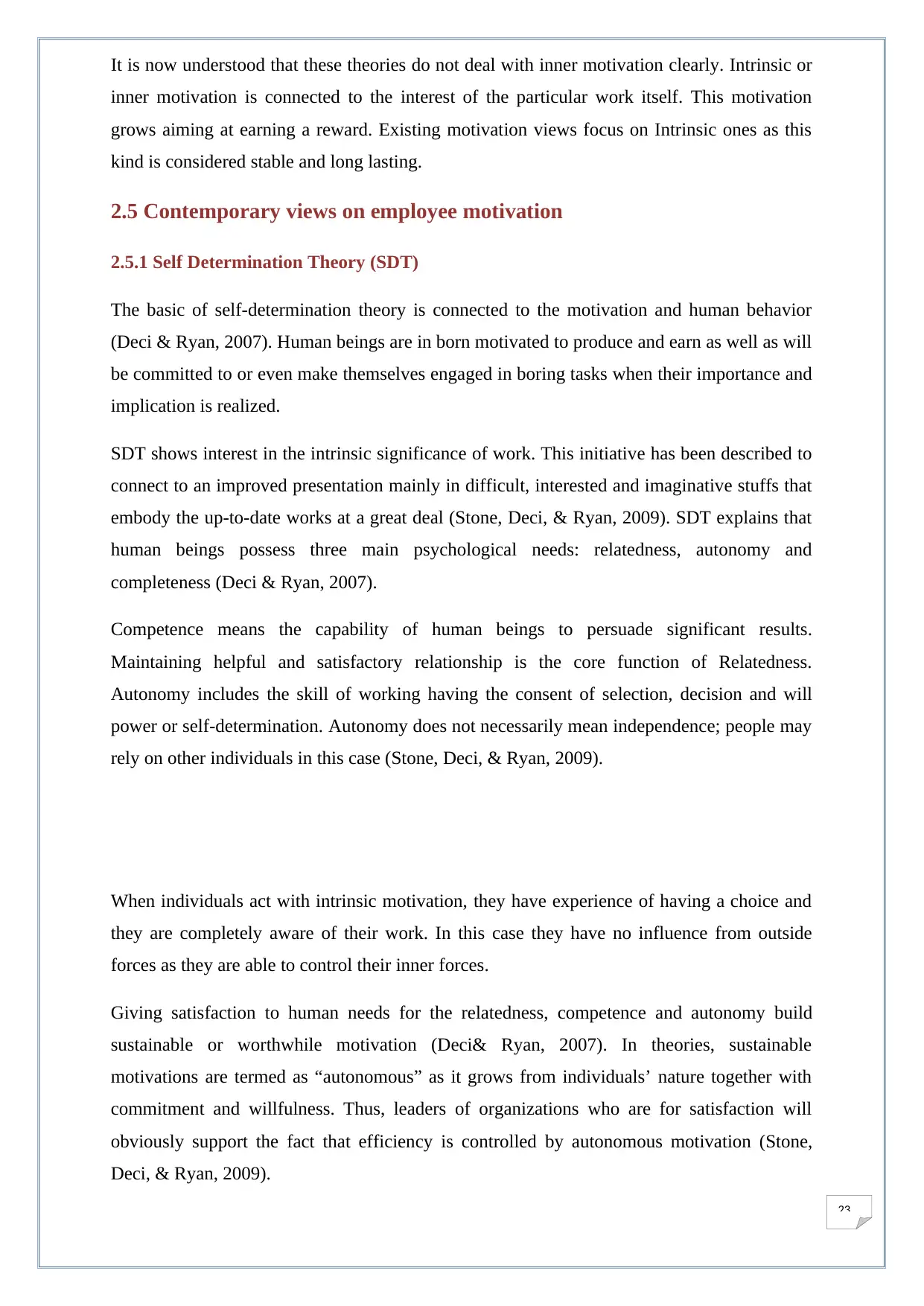
23
It is now understood that these theories do not deal with inner motivation clearly. Intrinsic or
inner motivation is connected to the interest of the particular work itself. This motivation
grows aiming at earning a reward. Existing motivation views focus on Intrinsic ones as this
kind is considered stable and long lasting.
2.5 Contemporary views on employee motivation
2.5.1 Self Determination Theory (SDT)
The basic of self-determination theory is connected to the motivation and human behavior
(Deci & Ryan, 2007). Human beings are in born motivated to produce and earn as well as will
be committed to or even make themselves engaged in boring tasks when their importance and
implication is realized.
SDT shows interest in the intrinsic significance of work. This initiative has been described to
connect to an improved presentation mainly in difficult, interested and imaginative stuffs that
embody the up-to-date works at a great deal (Stone, Deci, & Ryan, 2009). SDT explains that
human beings possess three main psychological needs: relatedness, autonomy and
completeness (Deci & Ryan, 2007).
Competence means the capability of human beings to persuade significant results.
Maintaining helpful and satisfactory relationship is the core function of Relatedness.
Autonomy includes the skill of working having the consent of selection, decision and will
power or self-determination. Autonomy does not necessarily mean independence; people may
rely on other individuals in this case (Stone, Deci, & Ryan, 2009).
When individuals act with intrinsic motivation, they have experience of having a choice and
they are completely aware of their work. In this case they have no influence from outside
forces as they are able to control their inner forces.
Giving satisfaction to human needs for the relatedness, competence and autonomy build
sustainable or worthwhile motivation (Deci& Ryan, 2007). In theories, sustainable
motivations are termed as “autonomous” as it grows from individuals’ nature together with
commitment and willfulness. Thus, leaders of organizations who are for satisfaction will
obviously support the fact that efficiency is controlled by autonomous motivation (Stone,
Deci, & Ryan, 2009).
It is now understood that these theories do not deal with inner motivation clearly. Intrinsic or
inner motivation is connected to the interest of the particular work itself. This motivation
grows aiming at earning a reward. Existing motivation views focus on Intrinsic ones as this
kind is considered stable and long lasting.
2.5 Contemporary views on employee motivation
2.5.1 Self Determination Theory (SDT)
The basic of self-determination theory is connected to the motivation and human behavior
(Deci & Ryan, 2007). Human beings are in born motivated to produce and earn as well as will
be committed to or even make themselves engaged in boring tasks when their importance and
implication is realized.
SDT shows interest in the intrinsic significance of work. This initiative has been described to
connect to an improved presentation mainly in difficult, interested and imaginative stuffs that
embody the up-to-date works at a great deal (Stone, Deci, & Ryan, 2009). SDT explains that
human beings possess three main psychological needs: relatedness, autonomy and
completeness (Deci & Ryan, 2007).
Competence means the capability of human beings to persuade significant results.
Maintaining helpful and satisfactory relationship is the core function of Relatedness.
Autonomy includes the skill of working having the consent of selection, decision and will
power or self-determination. Autonomy does not necessarily mean independence; people may
rely on other individuals in this case (Stone, Deci, & Ryan, 2009).
When individuals act with intrinsic motivation, they have experience of having a choice and
they are completely aware of their work. In this case they have no influence from outside
forces as they are able to control their inner forces.
Giving satisfaction to human needs for the relatedness, competence and autonomy build
sustainable or worthwhile motivation (Deci& Ryan, 2007). In theories, sustainable
motivations are termed as “autonomous” as it grows from individuals’ nature together with
commitment and willfulness. Thus, leaders of organizations who are for satisfaction will
obviously support the fact that efficiency is controlled by autonomous motivation (Stone,
Deci, & Ryan, 2009).
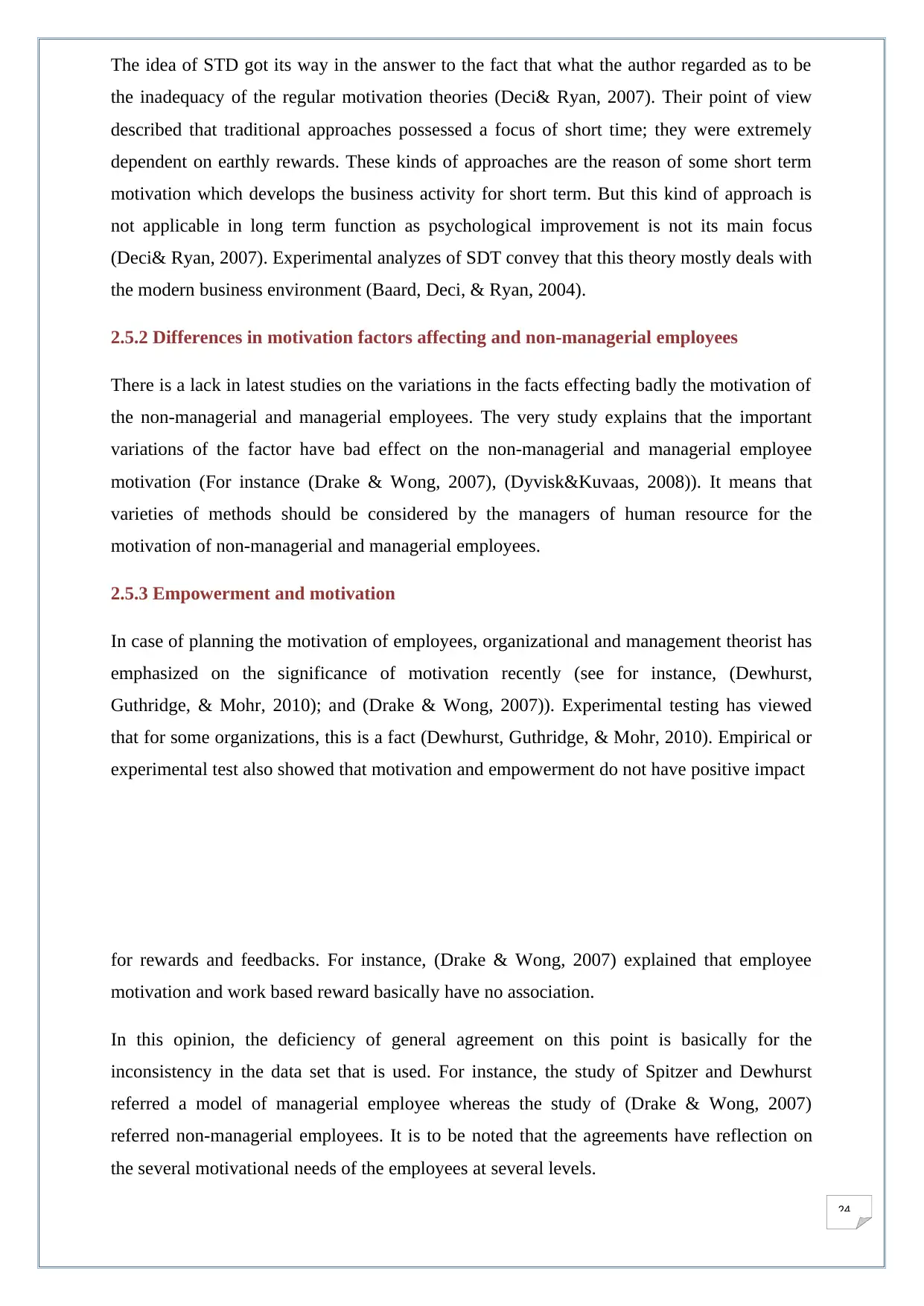
24
The idea of STD got its way in the answer to the fact that what the author regarded as to be
the inadequacy of the regular motivation theories (Deci& Ryan, 2007). Their point of view
described that traditional approaches possessed a focus of short time; they were extremely
dependent on earthly rewards. These kinds of approaches are the reason of some short term
motivation which develops the business activity for short term. But this kind of approach is
not applicable in long term function as psychological improvement is not its main focus
(Deci& Ryan, 2007). Experimental analyzes of SDT convey that this theory mostly deals with
the modern business environment (Baard, Deci, & Ryan, 2004).
2.5.2 Differences in motivation factors affecting and non-managerial employees
There is a lack in latest studies on the variations in the facts effecting badly the motivation of
the non-managerial and managerial employees. The very study explains that the important
variations of the factor have bad effect on the non-managerial and managerial employee
motivation (For instance (Drake & Wong, 2007), (Dyvisk&Kuvaas, 2008)). It means that
varieties of methods should be considered by the managers of human resource for the
motivation of non-managerial and managerial employees.
2.5.3 Empowerment and motivation
In case of planning the motivation of employees, organizational and management theorist has
emphasized on the significance of motivation recently (see for instance, (Dewhurst,
Guthridge, & Mohr, 2010); and (Drake & Wong, 2007)). Experimental testing has viewed
that for some organizations, this is a fact (Dewhurst, Guthridge, & Mohr, 2010). Empirical or
experimental test also showed that motivation and empowerment do not have positive impact
for rewards and feedbacks. For instance, (Drake & Wong, 2007) explained that employee
motivation and work based reward basically have no association.
In this opinion, the deficiency of general agreement on this point is basically for the
inconsistency in the data set that is used. For instance, the study of Spitzer and Dewhurst
referred a model of managerial employee whereas the study of (Drake & Wong, 2007)
referred non-managerial employees. It is to be noted that the agreements have reflection on
the several motivational needs of the employees at several levels.
The idea of STD got its way in the answer to the fact that what the author regarded as to be
the inadequacy of the regular motivation theories (Deci& Ryan, 2007). Their point of view
described that traditional approaches possessed a focus of short time; they were extremely
dependent on earthly rewards. These kinds of approaches are the reason of some short term
motivation which develops the business activity for short term. But this kind of approach is
not applicable in long term function as psychological improvement is not its main focus
(Deci& Ryan, 2007). Experimental analyzes of SDT convey that this theory mostly deals with
the modern business environment (Baard, Deci, & Ryan, 2004).
2.5.2 Differences in motivation factors affecting and non-managerial employees
There is a lack in latest studies on the variations in the facts effecting badly the motivation of
the non-managerial and managerial employees. The very study explains that the important
variations of the factor have bad effect on the non-managerial and managerial employee
motivation (For instance (Drake & Wong, 2007), (Dyvisk&Kuvaas, 2008)). It means that
varieties of methods should be considered by the managers of human resource for the
motivation of non-managerial and managerial employees.
2.5.3 Empowerment and motivation
In case of planning the motivation of employees, organizational and management theorist has
emphasized on the significance of motivation recently (see for instance, (Dewhurst,
Guthridge, & Mohr, 2010); and (Drake & Wong, 2007)). Experimental testing has viewed
that for some organizations, this is a fact (Dewhurst, Guthridge, & Mohr, 2010). Empirical or
experimental test also showed that motivation and empowerment do not have positive impact
for rewards and feedbacks. For instance, (Drake & Wong, 2007) explained that employee
motivation and work based reward basically have no association.
In this opinion, the deficiency of general agreement on this point is basically for the
inconsistency in the data set that is used. For instance, the study of Spitzer and Dewhurst
referred a model of managerial employee whereas the study of (Drake & Wong, 2007)
referred non-managerial employees. It is to be noted that the agreements have reflection on
the several motivational needs of the employees at several levels.
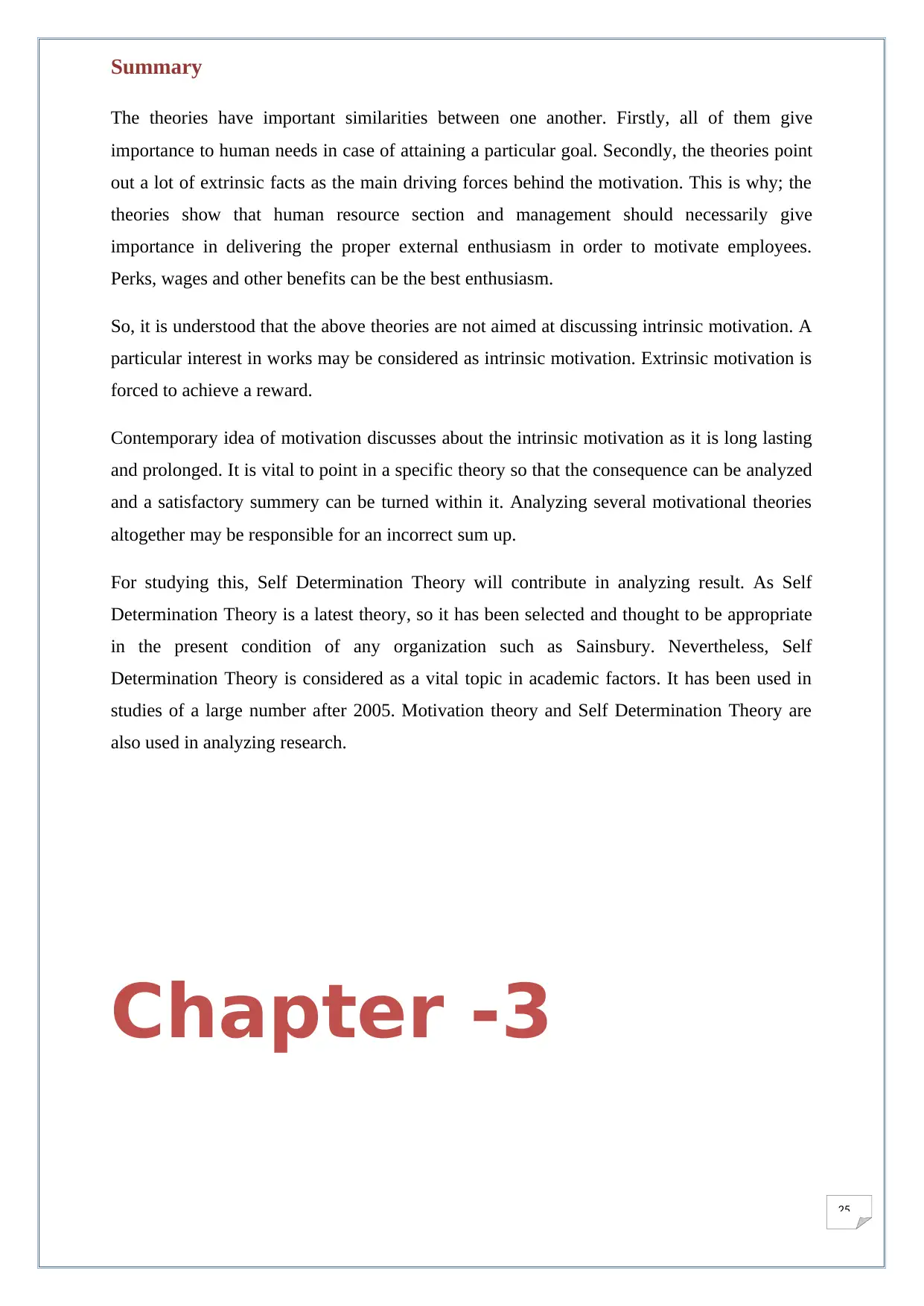
25
Summary
The theories have important similarities between one another. Firstly, all of them give
importance to human needs in case of attaining a particular goal. Secondly, the theories point
out a lot of extrinsic facts as the main driving forces behind the motivation. This is why; the
theories show that human resource section and management should necessarily give
importance in delivering the proper external enthusiasm in order to motivate employees.
Perks, wages and other benefits can be the best enthusiasm.
So, it is understood that the above theories are not aimed at discussing intrinsic motivation. A
particular interest in works may be considered as intrinsic motivation. Extrinsic motivation is
forced to achieve a reward.
Contemporary idea of motivation discusses about the intrinsic motivation as it is long lasting
and prolonged. It is vital to point in a specific theory so that the consequence can be analyzed
and a satisfactory summery can be turned within it. Analyzing several motivational theories
altogether may be responsible for an incorrect sum up.
For studying this, Self Determination Theory will contribute in analyzing result. As Self
Determination Theory is a latest theory, so it has been selected and thought to be appropriate
in the present condition of any organization such as Sainsbury. Nevertheless, Self
Determination Theory is considered as a vital topic in academic factors. It has been used in
studies of a large number after 2005. Motivation theory and Self Determination Theory are
also used in analyzing research.
Chapter -3
Summary
The theories have important similarities between one another. Firstly, all of them give
importance to human needs in case of attaining a particular goal. Secondly, the theories point
out a lot of extrinsic facts as the main driving forces behind the motivation. This is why; the
theories show that human resource section and management should necessarily give
importance in delivering the proper external enthusiasm in order to motivate employees.
Perks, wages and other benefits can be the best enthusiasm.
So, it is understood that the above theories are not aimed at discussing intrinsic motivation. A
particular interest in works may be considered as intrinsic motivation. Extrinsic motivation is
forced to achieve a reward.
Contemporary idea of motivation discusses about the intrinsic motivation as it is long lasting
and prolonged. It is vital to point in a specific theory so that the consequence can be analyzed
and a satisfactory summery can be turned within it. Analyzing several motivational theories
altogether may be responsible for an incorrect sum up.
For studying this, Self Determination Theory will contribute in analyzing result. As Self
Determination Theory is a latest theory, so it has been selected and thought to be appropriate
in the present condition of any organization such as Sainsbury. Nevertheless, Self
Determination Theory is considered as a vital topic in academic factors. It has been used in
studies of a large number after 2005. Motivation theory and Self Determination Theory are
also used in analyzing research.
Chapter -3
Paraphrase This Document
Need a fresh take? Get an instant paraphrase of this document with our AI Paraphraser
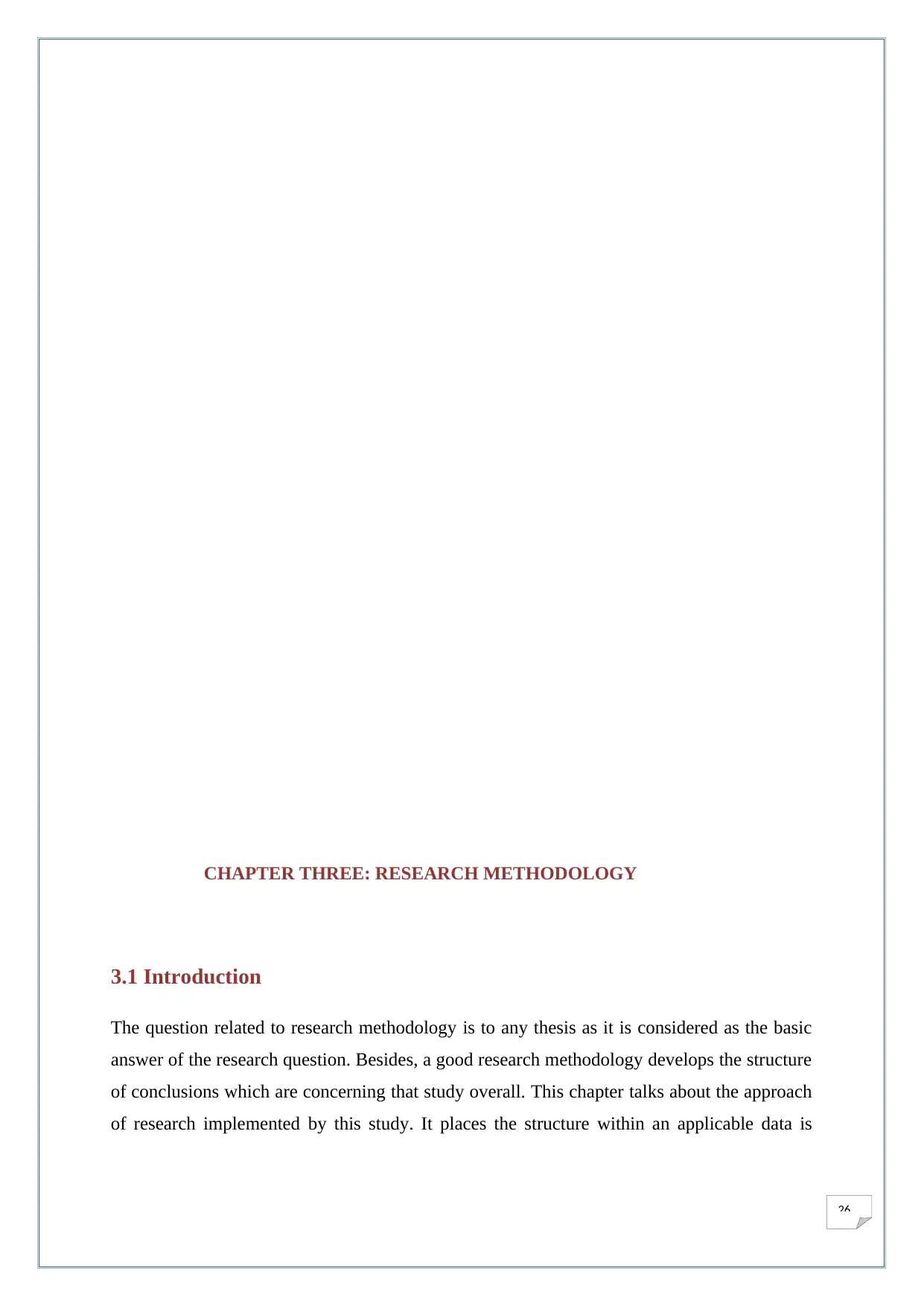
26
CHAPTER THREE: RESEARCH METHODOLOGY
3.1 Introduction
The question related to research methodology is to any thesis as it is considered as the basic
answer of the research question. Besides, a good research methodology develops the structure
of conclusions which are concerning that study overall. This chapter talks about the approach
of research implemented by this study. It places the structure within an applicable data is
CHAPTER THREE: RESEARCH METHODOLOGY
3.1 Introduction
The question related to research methodology is to any thesis as it is considered as the basic
answer of the research question. Besides, a good research methodology develops the structure
of conclusions which are concerning that study overall. This chapter talks about the approach
of research implemented by this study. It places the structure within an applicable data is
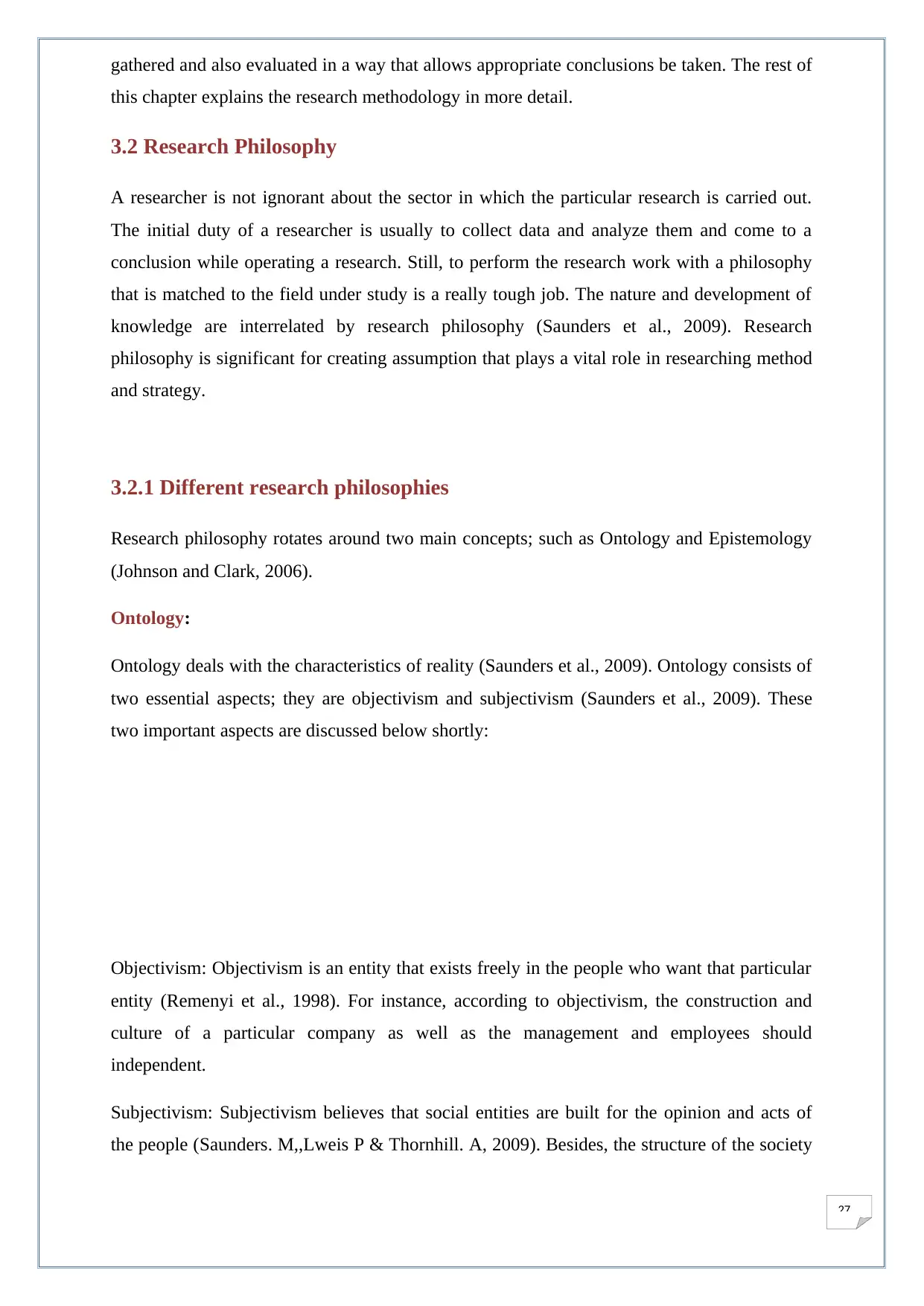
27
gathered and also evaluated in a way that allows appropriate conclusions be taken. The rest of
this chapter explains the research methodology in more detail.
3.2 Research Philosophy
A researcher is not ignorant about the sector in which the particular research is carried out.
The initial duty of a researcher is usually to collect data and analyze them and come to a
conclusion while operating a research. Still, to perform the research work with a philosophy
that is matched to the field under study is a really tough job. The nature and development of
knowledge are interrelated by research philosophy (Saunders et al., 2009). Research
philosophy is significant for creating assumption that plays a vital role in researching method
and strategy.
3.2.1 Different research philosophies
Research philosophy rotates around two main concepts; such as Ontology and Epistemology
(Johnson and Clark, 2006).
Ontology:
Ontology deals with the characteristics of reality (Saunders et al., 2009). Ontology consists of
two essential aspects; they are objectivism and subjectivism (Saunders et al., 2009). These
two important aspects are discussed below shortly:
Objectivism: Objectivism is an entity that exists freely in the people who want that particular
entity (Remenyi et al., 1998). For instance, according to objectivism, the construction and
culture of a particular company as well as the management and employees should
independent.
Subjectivism: Subjectivism believes that social entities are built for the opinion and acts of
the people (Saunders. M,,Lweis P & Thornhill. A, 2009). Besides, the structure of the society
gathered and also evaluated in a way that allows appropriate conclusions be taken. The rest of
this chapter explains the research methodology in more detail.
3.2 Research Philosophy
A researcher is not ignorant about the sector in which the particular research is carried out.
The initial duty of a researcher is usually to collect data and analyze them and come to a
conclusion while operating a research. Still, to perform the research work with a philosophy
that is matched to the field under study is a really tough job. The nature and development of
knowledge are interrelated by research philosophy (Saunders et al., 2009). Research
philosophy is significant for creating assumption that plays a vital role in researching method
and strategy.
3.2.1 Different research philosophies
Research philosophy rotates around two main concepts; such as Ontology and Epistemology
(Johnson and Clark, 2006).
Ontology:
Ontology deals with the characteristics of reality (Saunders et al., 2009). Ontology consists of
two essential aspects; they are objectivism and subjectivism (Saunders et al., 2009). These
two important aspects are discussed below shortly:
Objectivism: Objectivism is an entity that exists freely in the people who want that particular
entity (Remenyi et al., 1998). For instance, according to objectivism, the construction and
culture of a particular company as well as the management and employees should
independent.
Subjectivism: Subjectivism believes that social entities are built for the opinion and acts of
the people (Saunders. M,,Lweis P & Thornhill. A, 2009). Besides, the structure of the society
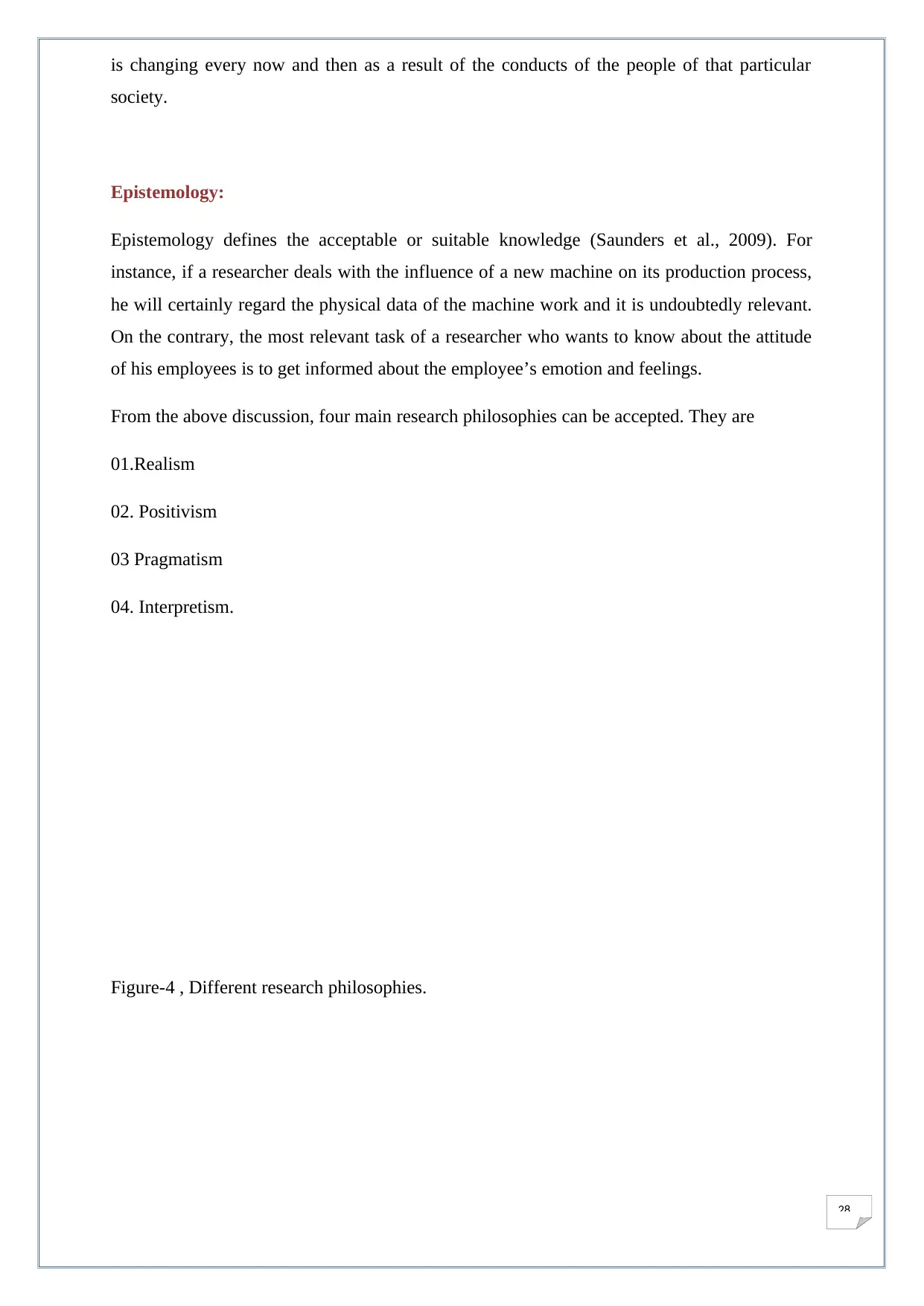
28
is changing every now and then as a result of the conducts of the people of that particular
society.
Epistemology:
Epistemology defines the acceptable or suitable knowledge (Saunders et al., 2009). For
instance, if a researcher deals with the influence of a new machine on its production process,
he will certainly regard the physical data of the machine work and it is undoubtedly relevant.
On the contrary, the most relevant task of a researcher who wants to know about the attitude
of his employees is to get informed about the employee’s emotion and feelings.
From the above discussion, four main research philosophies can be accepted. They are
01.Realism
02. Positivism
03 Pragmatism
04. Interpretism.
Figure-4 , Different research philosophies.
is changing every now and then as a result of the conducts of the people of that particular
society.
Epistemology:
Epistemology defines the acceptable or suitable knowledge (Saunders et al., 2009). For
instance, if a researcher deals with the influence of a new machine on its production process,
he will certainly regard the physical data of the machine work and it is undoubtedly relevant.
On the contrary, the most relevant task of a researcher who wants to know about the attitude
of his employees is to get informed about the employee’s emotion and feelings.
From the above discussion, four main research philosophies can be accepted. They are
01.Realism
02. Positivism
03 Pragmatism
04. Interpretism.
Figure-4 , Different research philosophies.
Secure Best Marks with AI Grader
Need help grading? Try our AI Grader for instant feedback on your assignments.
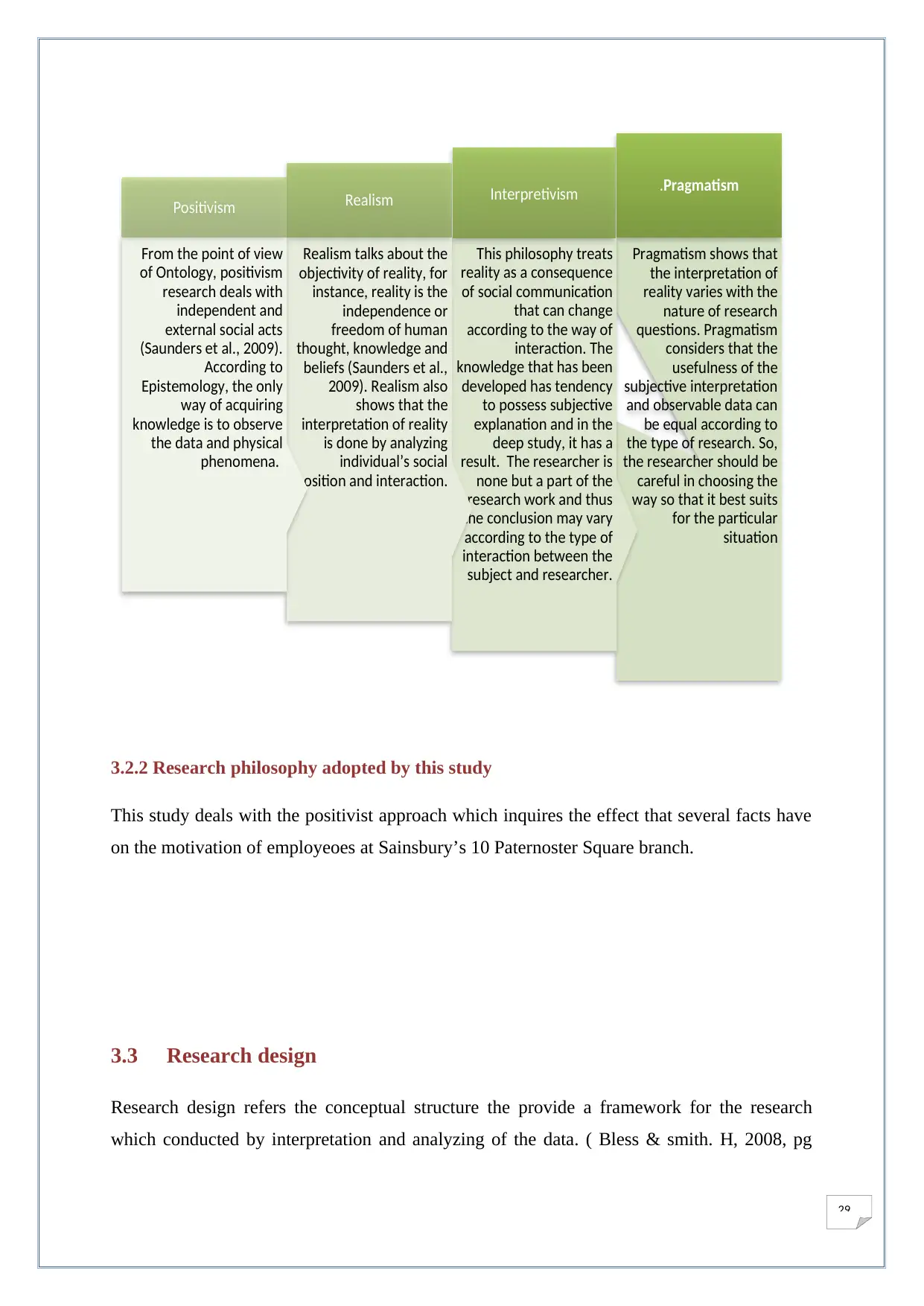
29
3.2.2 Research philosophy adopted by this study
This study deals with the positivist approach which inquires the effect that several facts have
on the motivation of employeoes at Sainsbury’s 10 Paternoster Square branch.
3.3 Research design
Research design refers the conceptual structure the provide a framework for the research
which conducted by interpretation and analyzing of the data. ( Bless & smith. H, 2008, pg
Pragmatism shows that
the interpretation of
reality varies with the
nature of research
questions. Pragmatism
considers that the
usefulness of the
subjective interpretation
and observable data can
be equal according to
the type of research. So,
the researcher should be
careful in choosing the
way so that it best suits
for the particular
situation
.Pragmatism
This philosophy treats
reality as a consequence
of social communication
that can change
according to the way of
interaction. The
knowledge that has been
developed has tendency
to possess subjective
explanation and in the
deep study, it has a
result. The researcher is
none but a part of the
research work and thus
the conclusion may vary
according to the type of
interaction between the
subject and researcher.
Interpretivism
Realism talks about the
objectivity of reality, for
instance, reality is the
independence or
freedom of human
thought, knowledge and
beliefs (Saunders et al.,
2009). Realism also
shows that the
interpretation of reality
is done by analyzing
individual’s social
position and interaction.
Realism
From the point of view
of Ontology, positivism
research deals with
independent and
external social acts
(Saunders et al., 2009).
According to
Epistemology, the only
way of acquiring
knowledge is to observe
the data and physical
phenomena.
Positivism
3.2.2 Research philosophy adopted by this study
This study deals with the positivist approach which inquires the effect that several facts have
on the motivation of employeoes at Sainsbury’s 10 Paternoster Square branch.
3.3 Research design
Research design refers the conceptual structure the provide a framework for the research
which conducted by interpretation and analyzing of the data. ( Bless & smith. H, 2008, pg
Pragmatism shows that
the interpretation of
reality varies with the
nature of research
questions. Pragmatism
considers that the
usefulness of the
subjective interpretation
and observable data can
be equal according to
the type of research. So,
the researcher should be
careful in choosing the
way so that it best suits
for the particular
situation
.Pragmatism
This philosophy treats
reality as a consequence
of social communication
that can change
according to the way of
interaction. The
knowledge that has been
developed has tendency
to possess subjective
explanation and in the
deep study, it has a
result. The researcher is
none but a part of the
research work and thus
the conclusion may vary
according to the type of
interaction between the
subject and researcher.
Interpretivism
Realism talks about the
objectivity of reality, for
instance, reality is the
independence or
freedom of human
thought, knowledge and
beliefs (Saunders et al.,
2009). Realism also
shows that the
interpretation of reality
is done by analyzing
individual’s social
position and interaction.
Realism
From the point of view
of Ontology, positivism
research deals with
independent and
external social acts
(Saunders et al., 2009).
According to
Epistemology, the only
way of acquiring
knowledge is to observe
the data and physical
phenomena.
Positivism
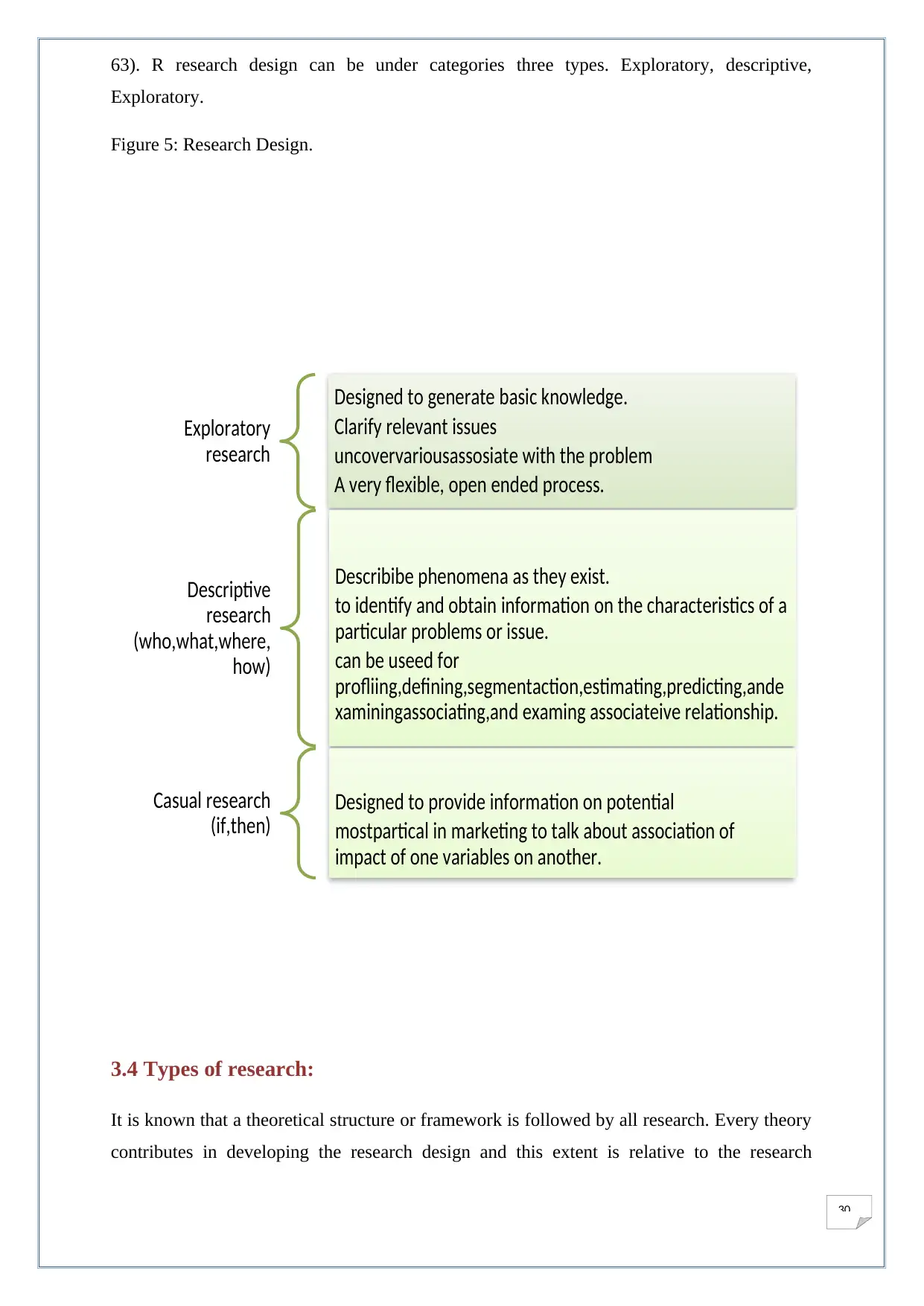
30
63). R research design can be under categories three types. Exploratory, descriptive,
Exploratory.
Figure 5: Research Design.
3.4 Types of research:
It is known that a theoretical structure or framework is followed by all research. Every theory
contributes in developing the research design and this extent is relative to the research
Exploratory
research
Designed to generate basic knowledge.
Clarify relevant issues
uncovervariousassosiate with the problem
A very flexible, open ended process.
Descriptive
research
(who,what,where,
how)
Describibe phenomena as they exist.
to identify and obtain information on the characteristics of a
particular problems or issue.
can be useed for
profliing,defining,segmentaction,estimating,predicting,ande
xaminingassociating,and examing associateive relationship.
Casual research
(if,then)
Designed to provide information on potential
mostpartical in marketing to talk about association of
impact of one variables on another.
63). R research design can be under categories three types. Exploratory, descriptive,
Exploratory.
Figure 5: Research Design.
3.4 Types of research:
It is known that a theoretical structure or framework is followed by all research. Every theory
contributes in developing the research design and this extent is relative to the research
Exploratory
research
Designed to generate basic knowledge.
Clarify relevant issues
uncovervariousassosiate with the problem
A very flexible, open ended process.
Descriptive
research
(who,what,where,
how)
Describibe phenomena as they exist.
to identify and obtain information on the characteristics of a
particular problems or issue.
can be useed for
profliing,defining,segmentaction,estimating,predicting,ande
xaminingassociating,and examing associateive relationship.
Casual research
(if,then)
Designed to provide information on potential
mostpartical in marketing to talk about association of
impact of one variables on another.
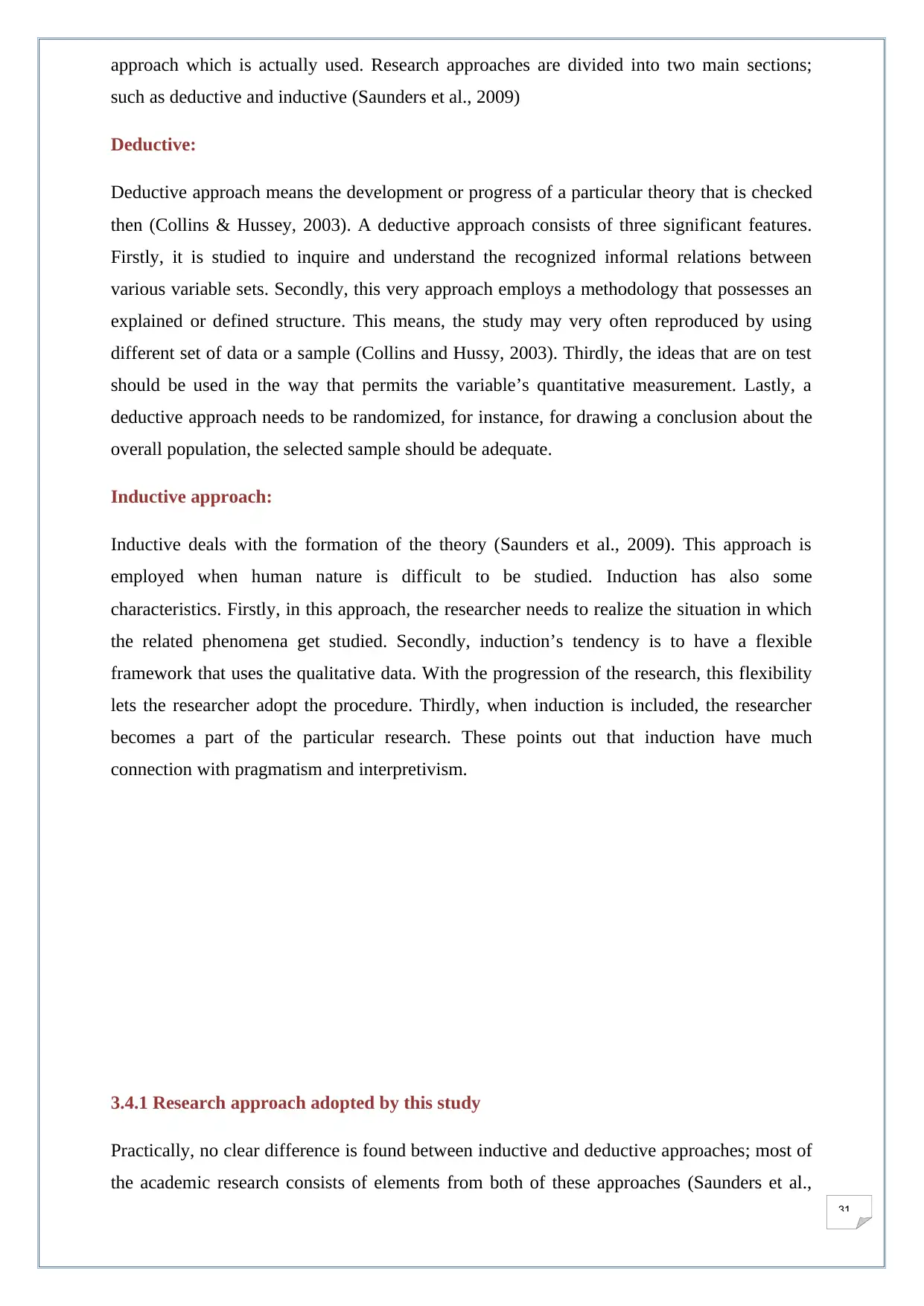
31
approach which is actually used. Research approaches are divided into two main sections;
such as deductive and inductive (Saunders et al., 2009)
Deductive:
Deductive approach means the development or progress of a particular theory that is checked
then (Collins & Hussey, 2003). A deductive approach consists of three significant features.
Firstly, it is studied to inquire and understand the recognized informal relations between
various variable sets. Secondly, this very approach employs a methodology that possesses an
explained or defined structure. This means, the study may very often reproduced by using
different set of data or a sample (Collins and Hussy, 2003). Thirdly, the ideas that are on test
should be used in the way that permits the variable’s quantitative measurement. Lastly, a
deductive approach needs to be randomized, for instance, for drawing a conclusion about the
overall population, the selected sample should be adequate.
Inductive approach:
Inductive deals with the formation of the theory (Saunders et al., 2009). This approach is
employed when human nature is difficult to be studied. Induction has also some
characteristics. Firstly, in this approach, the researcher needs to realize the situation in which
the related phenomena get studied. Secondly, induction’s tendency is to have a flexible
framework that uses the qualitative data. With the progression of the research, this flexibility
lets the researcher adopt the procedure. Thirdly, when induction is included, the researcher
becomes a part of the particular research. These points out that induction have much
connection with pragmatism and interpretivism.
3.4.1 Research approach adopted by this study
Practically, no clear difference is found between inductive and deductive approaches; most of
the academic research consists of elements from both of these approaches (Saunders et al.,
approach which is actually used. Research approaches are divided into two main sections;
such as deductive and inductive (Saunders et al., 2009)
Deductive:
Deductive approach means the development or progress of a particular theory that is checked
then (Collins & Hussey, 2003). A deductive approach consists of three significant features.
Firstly, it is studied to inquire and understand the recognized informal relations between
various variable sets. Secondly, this very approach employs a methodology that possesses an
explained or defined structure. This means, the study may very often reproduced by using
different set of data or a sample (Collins and Hussy, 2003). Thirdly, the ideas that are on test
should be used in the way that permits the variable’s quantitative measurement. Lastly, a
deductive approach needs to be randomized, for instance, for drawing a conclusion about the
overall population, the selected sample should be adequate.
Inductive approach:
Inductive deals with the formation of the theory (Saunders et al., 2009). This approach is
employed when human nature is difficult to be studied. Induction has also some
characteristics. Firstly, in this approach, the researcher needs to realize the situation in which
the related phenomena get studied. Secondly, induction’s tendency is to have a flexible
framework that uses the qualitative data. With the progression of the research, this flexibility
lets the researcher adopt the procedure. Thirdly, when induction is included, the researcher
becomes a part of the particular research. These points out that induction have much
connection with pragmatism and interpretivism.
3.4.1 Research approach adopted by this study
Practically, no clear difference is found between inductive and deductive approaches; most of
the academic research consists of elements from both of these approaches (Saunders et al.,
Paraphrase This Document
Need a fresh take? Get an instant paraphrase of this document with our AI Paraphraser
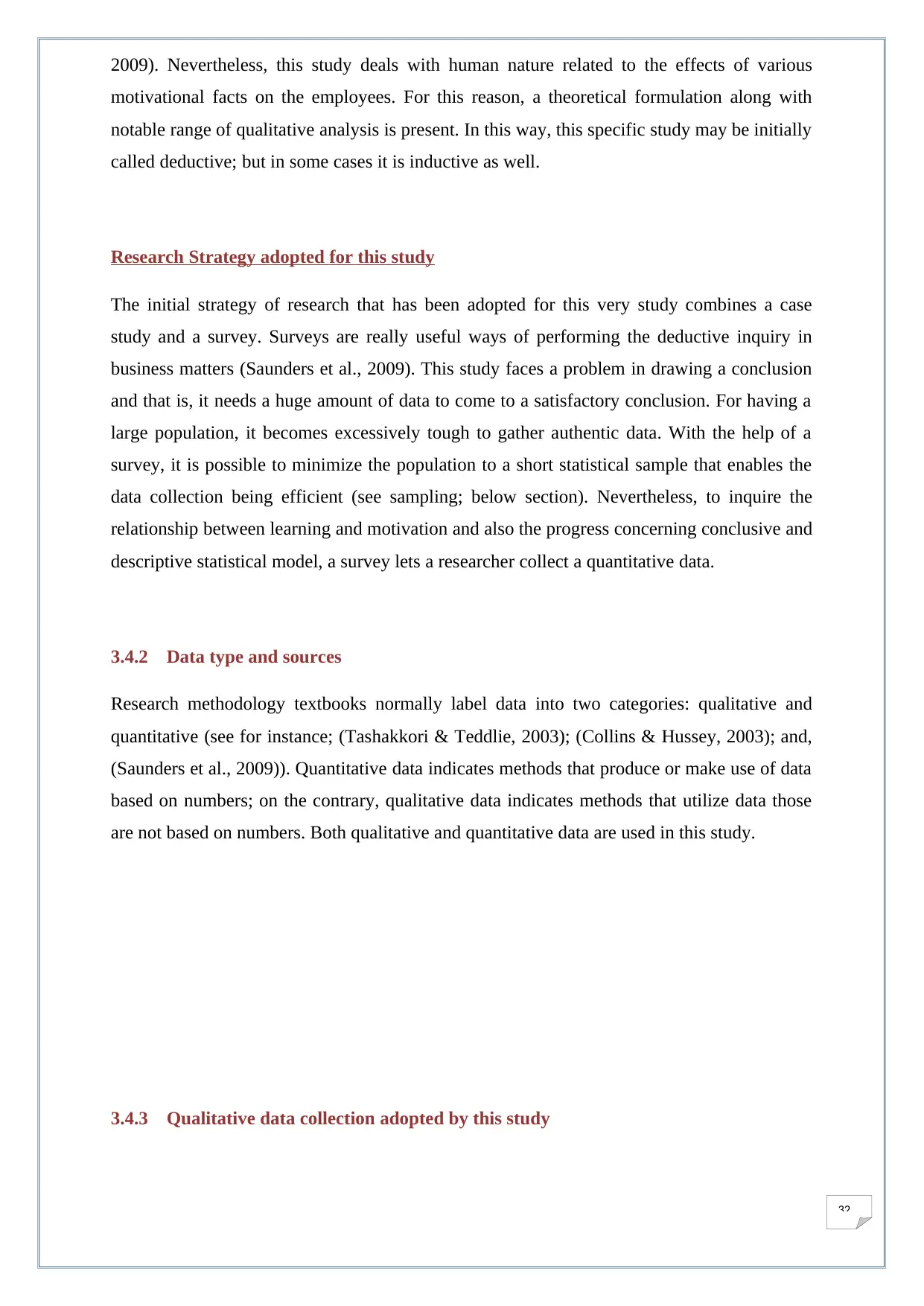
32
2009). Nevertheless, this study deals with human nature related to the effects of various
motivational facts on the employees. For this reason, a theoretical formulation along with
notable range of qualitative analysis is present. In this way, this specific study may be initially
called deductive; but in some cases it is inductive as well.
Research Strategy adopted for this study
The initial strategy of research that has been adopted for this very study combines a case
study and a survey. Surveys are really useful ways of performing the deductive inquiry in
business matters (Saunders et al., 2009). This study faces a problem in drawing a conclusion
and that is, it needs a huge amount of data to come to a satisfactory conclusion. For having a
large population, it becomes excessively tough to gather authentic data. With the help of a
survey, it is possible to minimize the population to a short statistical sample that enables the
data collection being efficient (see sampling; below section). Nevertheless, to inquire the
relationship between learning and motivation and also the progress concerning conclusive and
descriptive statistical model, a survey lets a researcher collect a quantitative data.
3.4.2 Data type and sources
Research methodology textbooks normally label data into two categories: qualitative and
quantitative (see for instance; (Tashakkori & Teddlie, 2003); (Collins & Hussey, 2003); and,
(Saunders et al., 2009)). Quantitative data indicates methods that produce or make use of data
based on numbers; on the contrary, qualitative data indicates methods that utilize data those
are not based on numbers. Both qualitative and quantitative data are used in this study.
3.4.3 Qualitative data collection adopted by this study
2009). Nevertheless, this study deals with human nature related to the effects of various
motivational facts on the employees. For this reason, a theoretical formulation along with
notable range of qualitative analysis is present. In this way, this specific study may be initially
called deductive; but in some cases it is inductive as well.
Research Strategy adopted for this study
The initial strategy of research that has been adopted for this very study combines a case
study and a survey. Surveys are really useful ways of performing the deductive inquiry in
business matters (Saunders et al., 2009). This study faces a problem in drawing a conclusion
and that is, it needs a huge amount of data to come to a satisfactory conclusion. For having a
large population, it becomes excessively tough to gather authentic data. With the help of a
survey, it is possible to minimize the population to a short statistical sample that enables the
data collection being efficient (see sampling; below section). Nevertheless, to inquire the
relationship between learning and motivation and also the progress concerning conclusive and
descriptive statistical model, a survey lets a researcher collect a quantitative data.
3.4.2 Data type and sources
Research methodology textbooks normally label data into two categories: qualitative and
quantitative (see for instance; (Tashakkori & Teddlie, 2003); (Collins & Hussey, 2003); and,
(Saunders et al., 2009)). Quantitative data indicates methods that produce or make use of data
based on numbers; on the contrary, qualitative data indicates methods that utilize data those
are not based on numbers. Both qualitative and quantitative data are used in this study.
3.4.3 Qualitative data collection adopted by this study
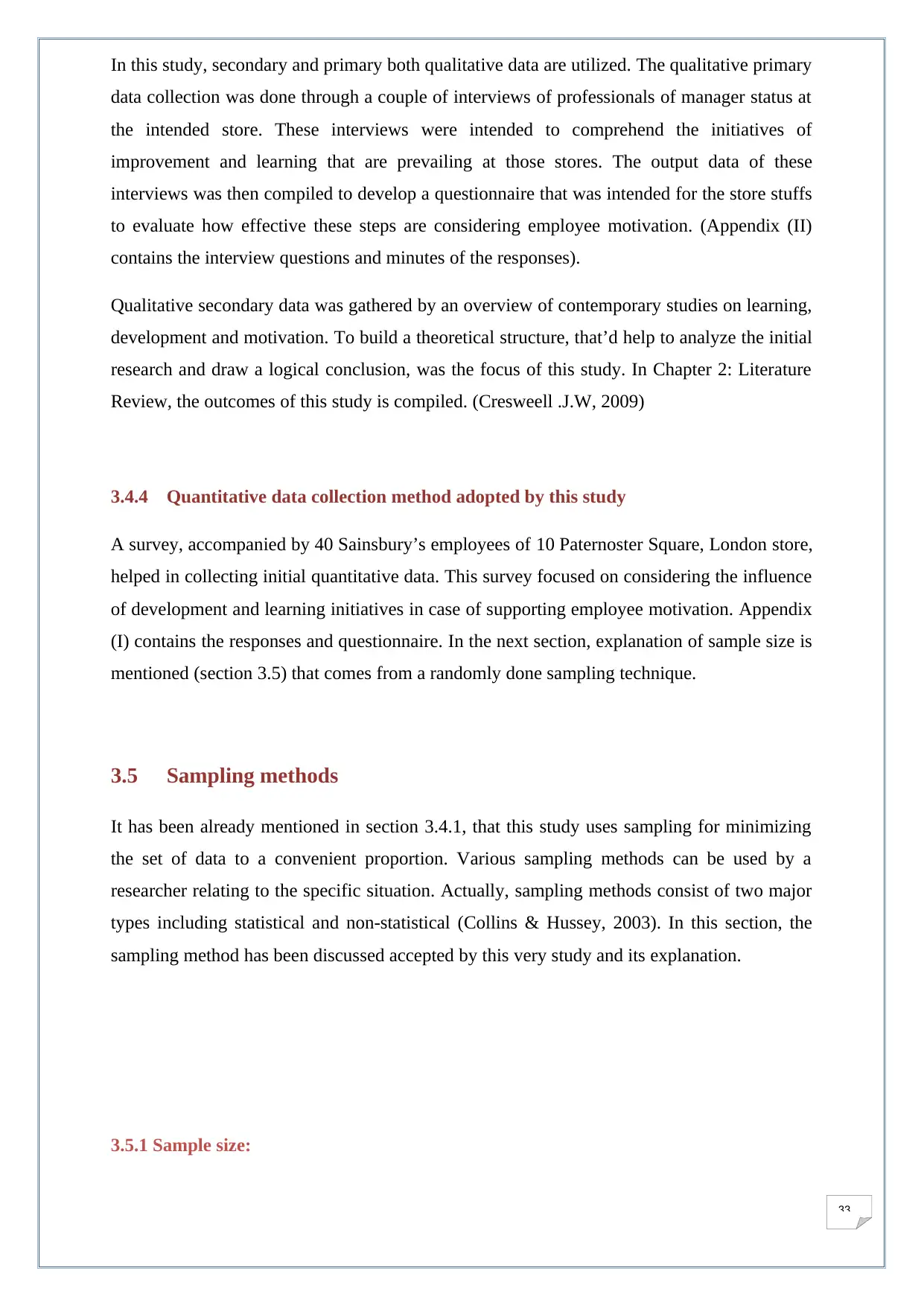
33
In this study, secondary and primary both qualitative data are utilized. The qualitative primary
data collection was done through a couple of interviews of professionals of manager status at
the intended store. These interviews were intended to comprehend the initiatives of
improvement and learning that are prevailing at those stores. The output data of these
interviews was then compiled to develop a questionnaire that was intended for the store stuffs
to evaluate how effective these steps are considering employee motivation. (Appendix (II)
contains the interview questions and minutes of the responses).
Qualitative secondary data was gathered by an overview of contemporary studies on learning,
development and motivation. To build a theoretical structure, that’d help to analyze the initial
research and draw a logical conclusion, was the focus of this study. In Chapter 2: Literature
Review, the outcomes of this study is compiled. (Cresweell .J.W, 2009)
3.4.4 Quantitative data collection method adopted by this study
A survey, accompanied by 40 Sainsbury’s employees of 10 Paternoster Square, London store,
helped in collecting initial quantitative data. This survey focused on considering the influence
of development and learning initiatives in case of supporting employee motivation. Appendix
(I) contains the responses and questionnaire. In the next section, explanation of sample size is
mentioned (section 3.5) that comes from a randomly done sampling technique.
3.5 Sampling methods
It has been already mentioned in section 3.4.1, that this study uses sampling for minimizing
the set of data to a convenient proportion. Various sampling methods can be used by a
researcher relating to the specific situation. Actually, sampling methods consist of two major
types including statistical and non-statistical (Collins & Hussey, 2003). In this section, the
sampling method has been discussed accepted by this very study and its explanation.
3.5.1 Sample size:
In this study, secondary and primary both qualitative data are utilized. The qualitative primary
data collection was done through a couple of interviews of professionals of manager status at
the intended store. These interviews were intended to comprehend the initiatives of
improvement and learning that are prevailing at those stores. The output data of these
interviews was then compiled to develop a questionnaire that was intended for the store stuffs
to evaluate how effective these steps are considering employee motivation. (Appendix (II)
contains the interview questions and minutes of the responses).
Qualitative secondary data was gathered by an overview of contemporary studies on learning,
development and motivation. To build a theoretical structure, that’d help to analyze the initial
research and draw a logical conclusion, was the focus of this study. In Chapter 2: Literature
Review, the outcomes of this study is compiled. (Cresweell .J.W, 2009)
3.4.4 Quantitative data collection method adopted by this study
A survey, accompanied by 40 Sainsbury’s employees of 10 Paternoster Square, London store,
helped in collecting initial quantitative data. This survey focused on considering the influence
of development and learning initiatives in case of supporting employee motivation. Appendix
(I) contains the responses and questionnaire. In the next section, explanation of sample size is
mentioned (section 3.5) that comes from a randomly done sampling technique.
3.5 Sampling methods
It has been already mentioned in section 3.4.1, that this study uses sampling for minimizing
the set of data to a convenient proportion. Various sampling methods can be used by a
researcher relating to the specific situation. Actually, sampling methods consist of two major
types including statistical and non-statistical (Collins & Hussey, 2003). In this section, the
sampling method has been discussed accepted by this very study and its explanation.
3.5.1 Sample size:
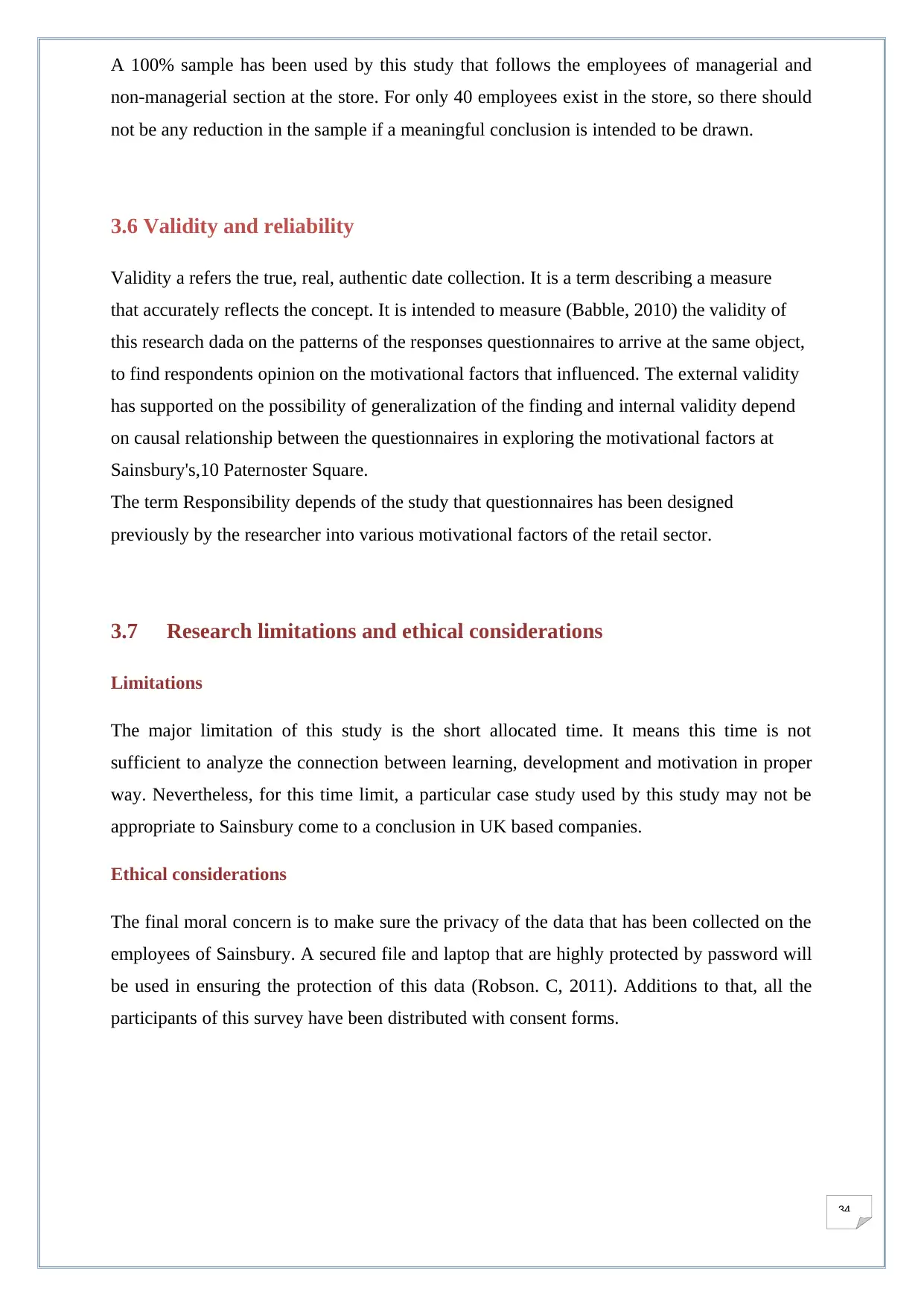
34
A 100% sample has been used by this study that follows the employees of managerial and
non-managerial section at the store. For only 40 employees exist in the store, so there should
not be any reduction in the sample if a meaningful conclusion is intended to be drawn.
3.6 Validity and reliability
Validity a refers the true, real, authentic date collection. It is a term describing a measure
that accurately reflects the concept. It is intended to measure (Babble, 2010) the validity of
this research dada on the patterns of the responses questionnaires to arrive at the same object,
to find respondents opinion on the motivational factors that influenced. The external validity
has supported on the possibility of generalization of the finding and internal validity depend
on causal relationship between the questionnaires in exploring the motivational factors at
Sainsbury's,10 Paternoster Square.
The term Responsibility depends of the study that questionnaires has been designed
previously by the researcher into various motivational factors of the retail sector.
3.7 Research limitations and ethical considerations
Limitations
The major limitation of this study is the short allocated time. It means this time is not
sufficient to analyze the connection between learning, development and motivation in proper
way. Nevertheless, for this time limit, a particular case study used by this study may not be
appropriate to Sainsbury come to a conclusion in UK based companies.
Ethical considerations
The final moral concern is to make sure the privacy of the data that has been collected on the
employees of Sainsbury. A secured file and laptop that are highly protected by password will
be used in ensuring the protection of this data (Robson. C, 2011). Additions to that, all the
participants of this survey have been distributed with consent forms.
A 100% sample has been used by this study that follows the employees of managerial and
non-managerial section at the store. For only 40 employees exist in the store, so there should
not be any reduction in the sample if a meaningful conclusion is intended to be drawn.
3.6 Validity and reliability
Validity a refers the true, real, authentic date collection. It is a term describing a measure
that accurately reflects the concept. It is intended to measure (Babble, 2010) the validity of
this research dada on the patterns of the responses questionnaires to arrive at the same object,
to find respondents opinion on the motivational factors that influenced. The external validity
has supported on the possibility of generalization of the finding and internal validity depend
on causal relationship between the questionnaires in exploring the motivational factors at
Sainsbury's,10 Paternoster Square.
The term Responsibility depends of the study that questionnaires has been designed
previously by the researcher into various motivational factors of the retail sector.
3.7 Research limitations and ethical considerations
Limitations
The major limitation of this study is the short allocated time. It means this time is not
sufficient to analyze the connection between learning, development and motivation in proper
way. Nevertheless, for this time limit, a particular case study used by this study may not be
appropriate to Sainsbury come to a conclusion in UK based companies.
Ethical considerations
The final moral concern is to make sure the privacy of the data that has been collected on the
employees of Sainsbury. A secured file and laptop that are highly protected by password will
be used in ensuring the protection of this data (Robson. C, 2011). Additions to that, all the
participants of this survey have been distributed with consent forms.
Secure Best Marks with AI Grader
Need help grading? Try our AI Grader for instant feedback on your assignments.
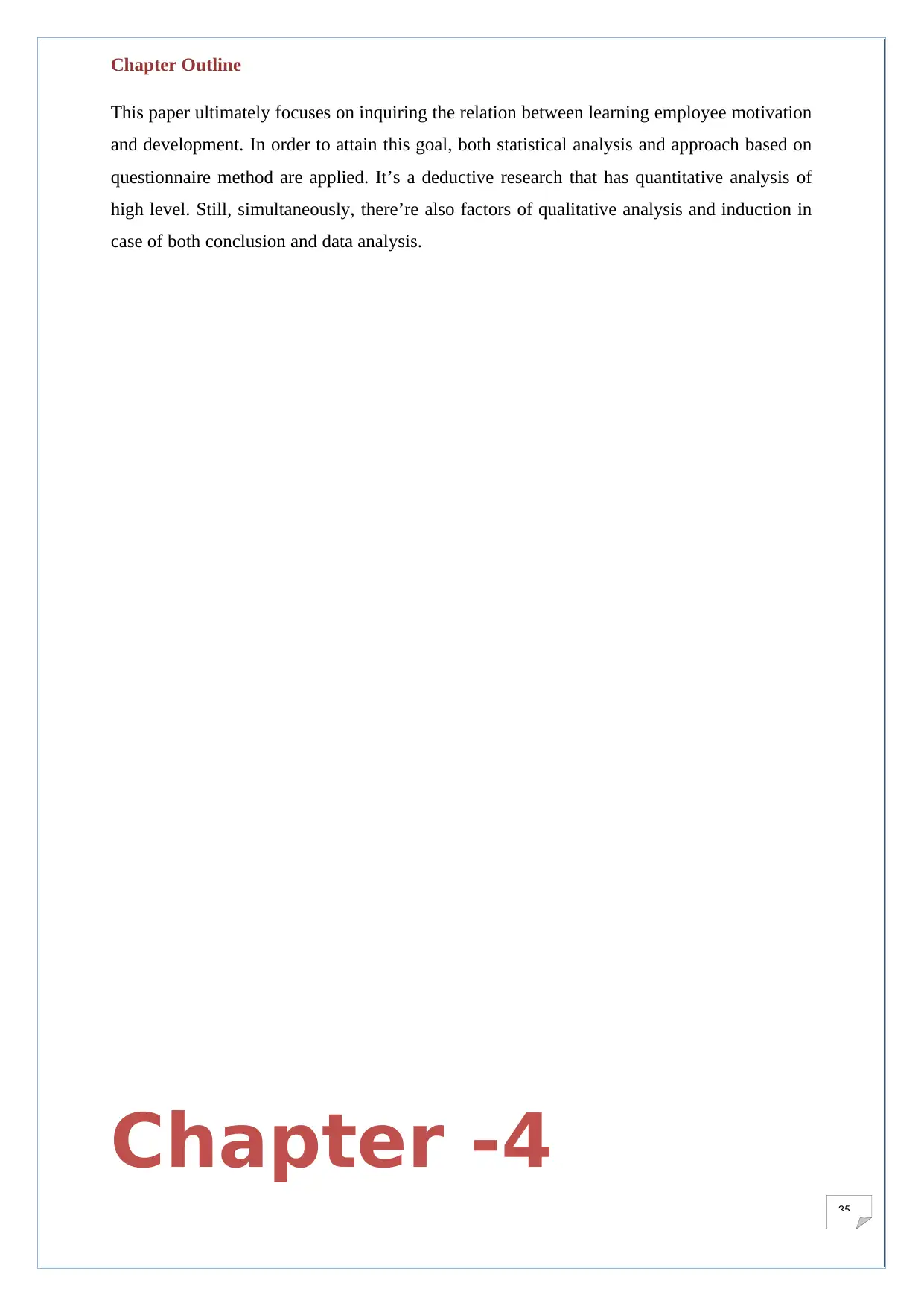
35
Chapter Outline
This paper ultimately focuses on inquiring the relation between learning employee motivation
and development. In order to attain this goal, both statistical analysis and approach based on
questionnaire method are applied. It’s a deductive research that has quantitative analysis of
high level. Still, simultaneously, there’re also factors of qualitative analysis and induction in
case of both conclusion and data analysis.
Chapter -4
Chapter Outline
This paper ultimately focuses on inquiring the relation between learning employee motivation
and development. In order to attain this goal, both statistical analysis and approach based on
questionnaire method are applied. It’s a deductive research that has quantitative analysis of
high level. Still, simultaneously, there’re also factors of qualitative analysis and induction in
case of both conclusion and data analysis.
Chapter -4
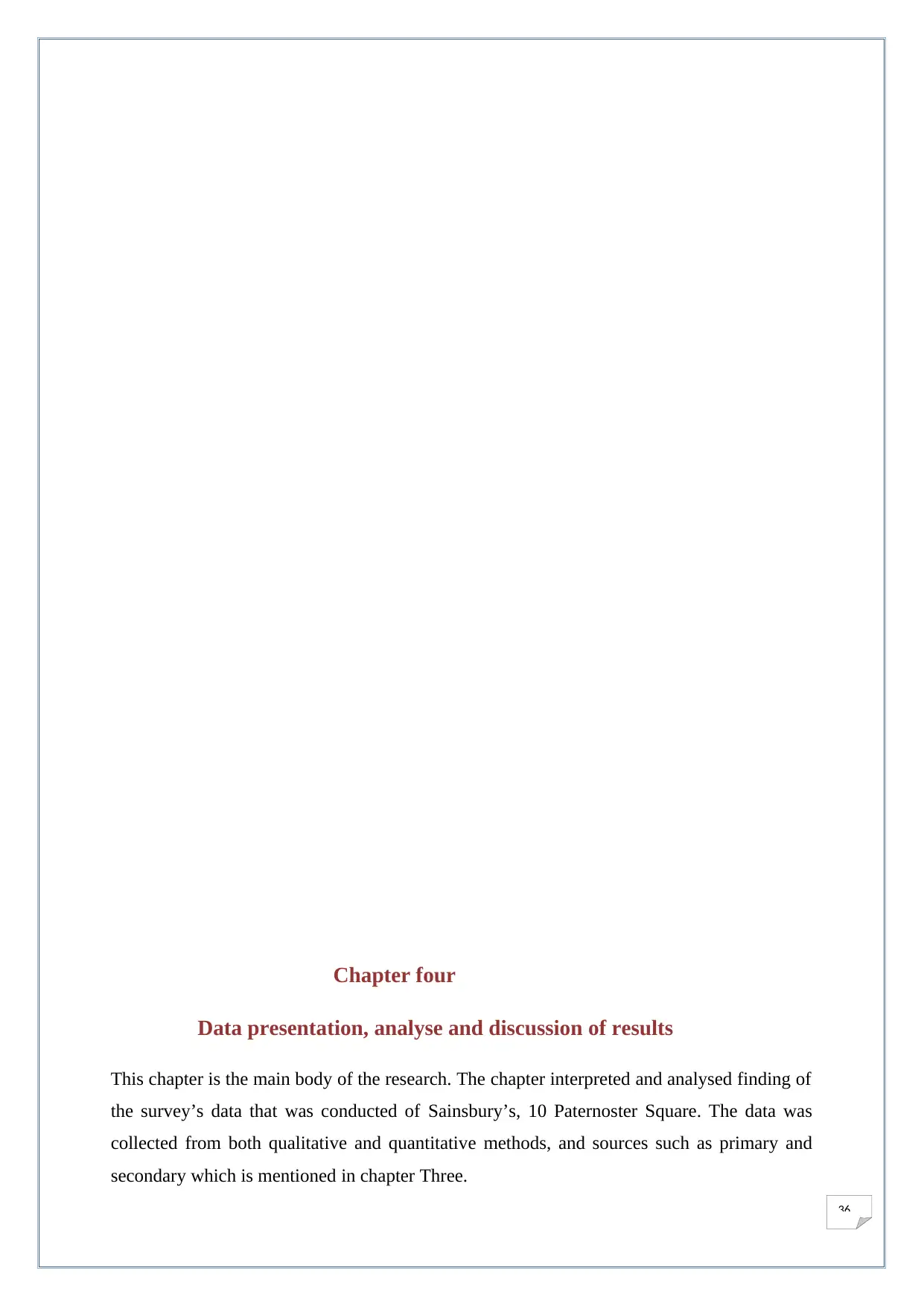
36
Chapter four
Data presentation, analyse and discussion of results
This chapter is the main body of the research. The chapter interpreted and analysed finding of
the survey’s data that was conducted of Sainsbury’s, 10 Paternoster Square. The data was
collected from both qualitative and quantitative methods, and sources such as primary and
secondary which is mentioned in chapter Three.
Chapter four
Data presentation, analyse and discussion of results
This chapter is the main body of the research. The chapter interpreted and analysed finding of
the survey’s data that was conducted of Sainsbury’s, 10 Paternoster Square. The data was
collected from both qualitative and quantitative methods, and sources such as primary and
secondary which is mentioned in chapter Three.
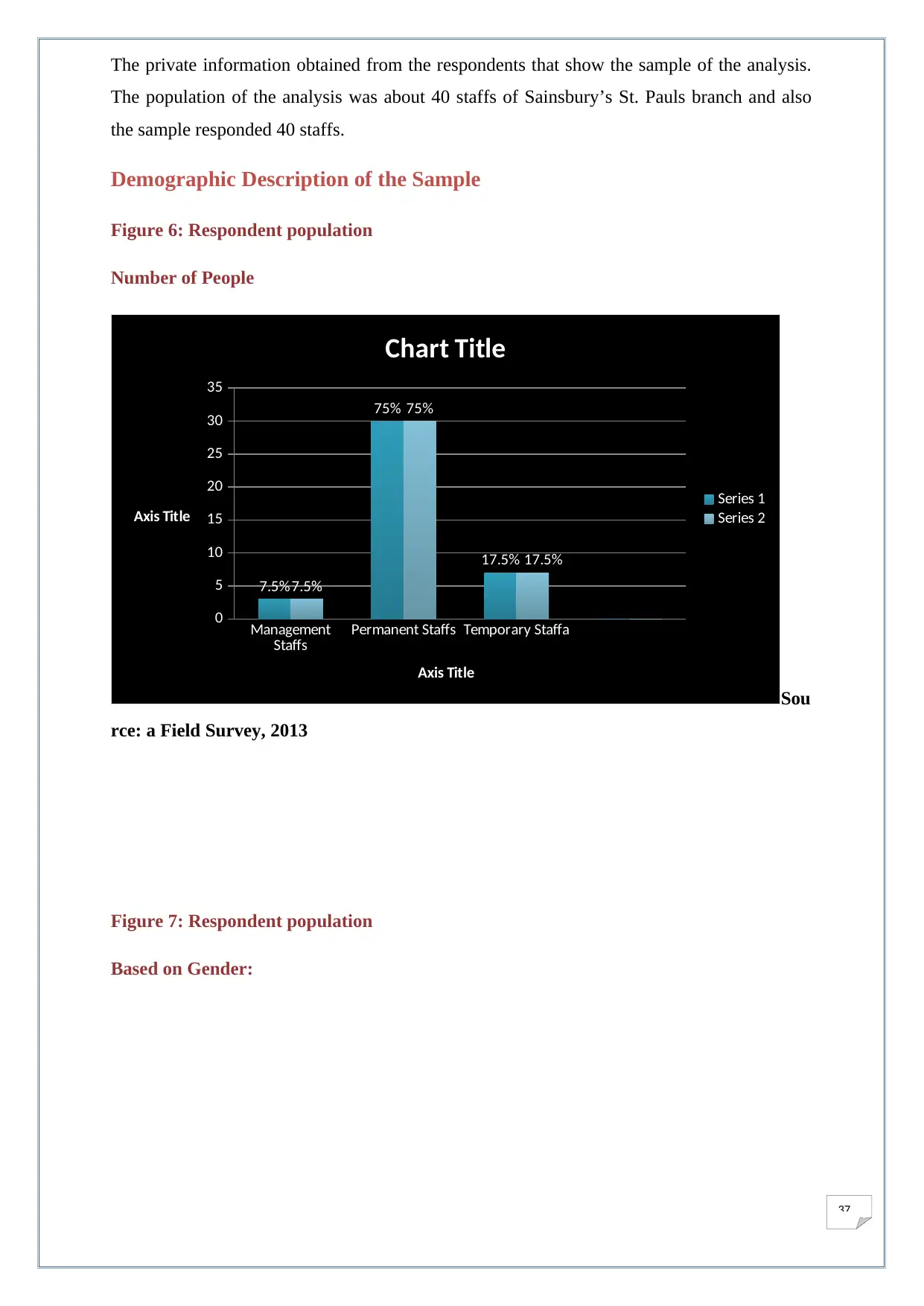
37
The private information obtained from the respondents that show the sample of the analysis.
The population of the analysis was about 40 staffs of Sainsbury’s St. Pauls branch and also
the sample responded 40 staffs.
Demographic Description of the Sample
Figure 6: Respondent population
Number of People
Management
Staffs Permanent Staffs Temporary Staffa
0
5
10
15
20
25
30
35
7.5%
75%
17.5%
7.5%
75%
17.5%
Chart Title
Series 1
Series 2
Axis Title
Axis Title
Sou
rce: a Field Survey, 2013
Figure 7: Respondent population
Based on Gender:
The private information obtained from the respondents that show the sample of the analysis.
The population of the analysis was about 40 staffs of Sainsbury’s St. Pauls branch and also
the sample responded 40 staffs.
Demographic Description of the Sample
Figure 6: Respondent population
Number of People
Management
Staffs Permanent Staffs Temporary Staffa
0
5
10
15
20
25
30
35
7.5%
75%
17.5%
7.5%
75%
17.5%
Chart Title
Series 1
Series 2
Axis Title
Axis Title
Sou
rce: a Field Survey, 2013
Figure 7: Respondent population
Based on Gender:
Paraphrase This Document
Need a fresh take? Get an instant paraphrase of this document with our AI Paraphraser
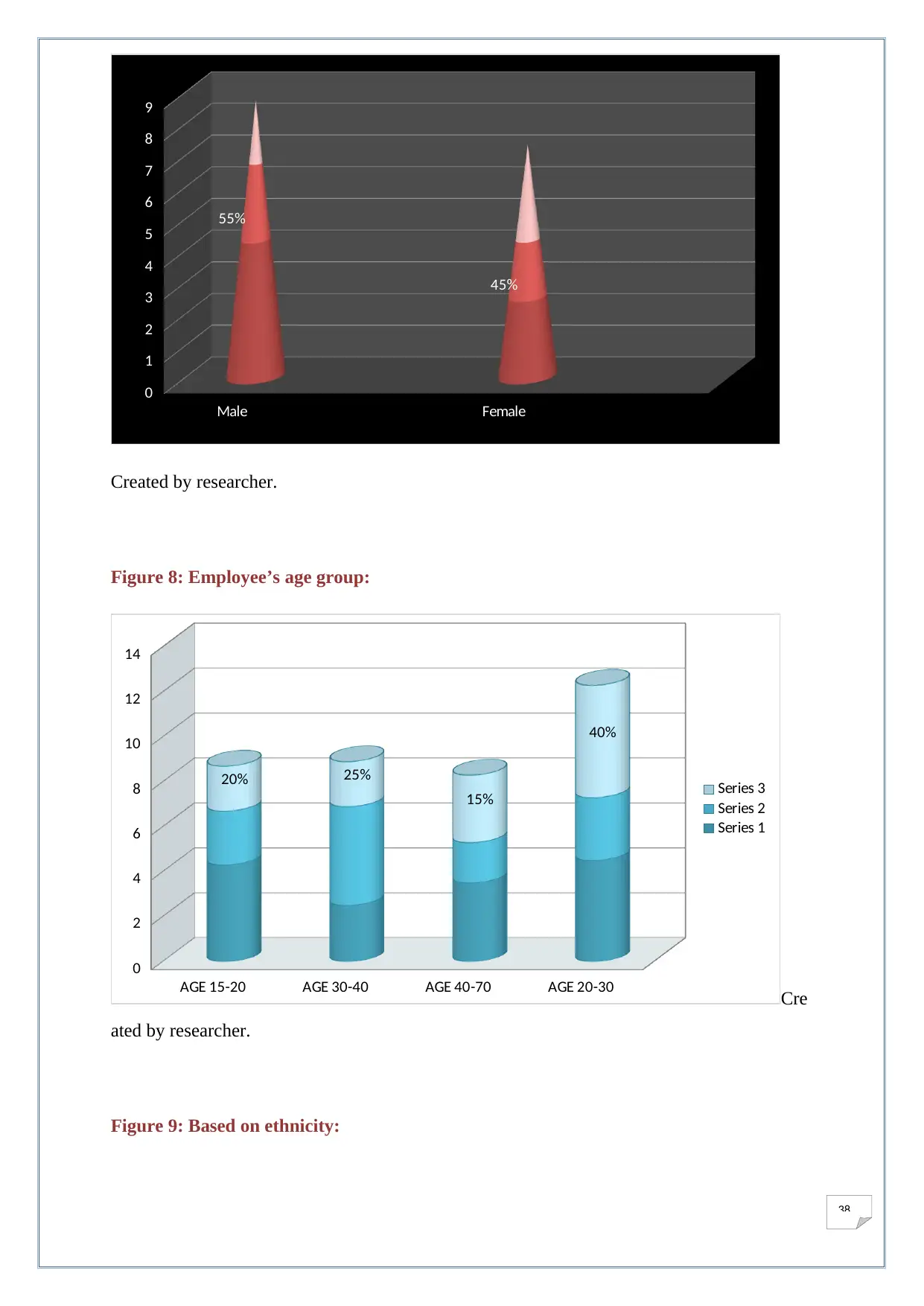
38
Male Female
0
1
2
3
4
5
6
7
8
9
55%
45%
Created by researcher.
Figure 8: Employee’s age group:
AGE 15-20 AGE 30-40 AGE 40-70 AGE 20-30
0
2
4
6
8
10
12
14
20% 25%
15%
40%
Series 3
Series 2
Series 1
Cre
ated by researcher.
Figure 9: Based on ethnicity:
Male Female
0
1
2
3
4
5
6
7
8
9
55%
45%
Created by researcher.
Figure 8: Employee’s age group:
AGE 15-20 AGE 30-40 AGE 40-70 AGE 20-30
0
2
4
6
8
10
12
14
20% 25%
15%
40%
Series 3
Series 2
Series 1
Cre
ated by researcher.
Figure 9: Based on ethnicity:
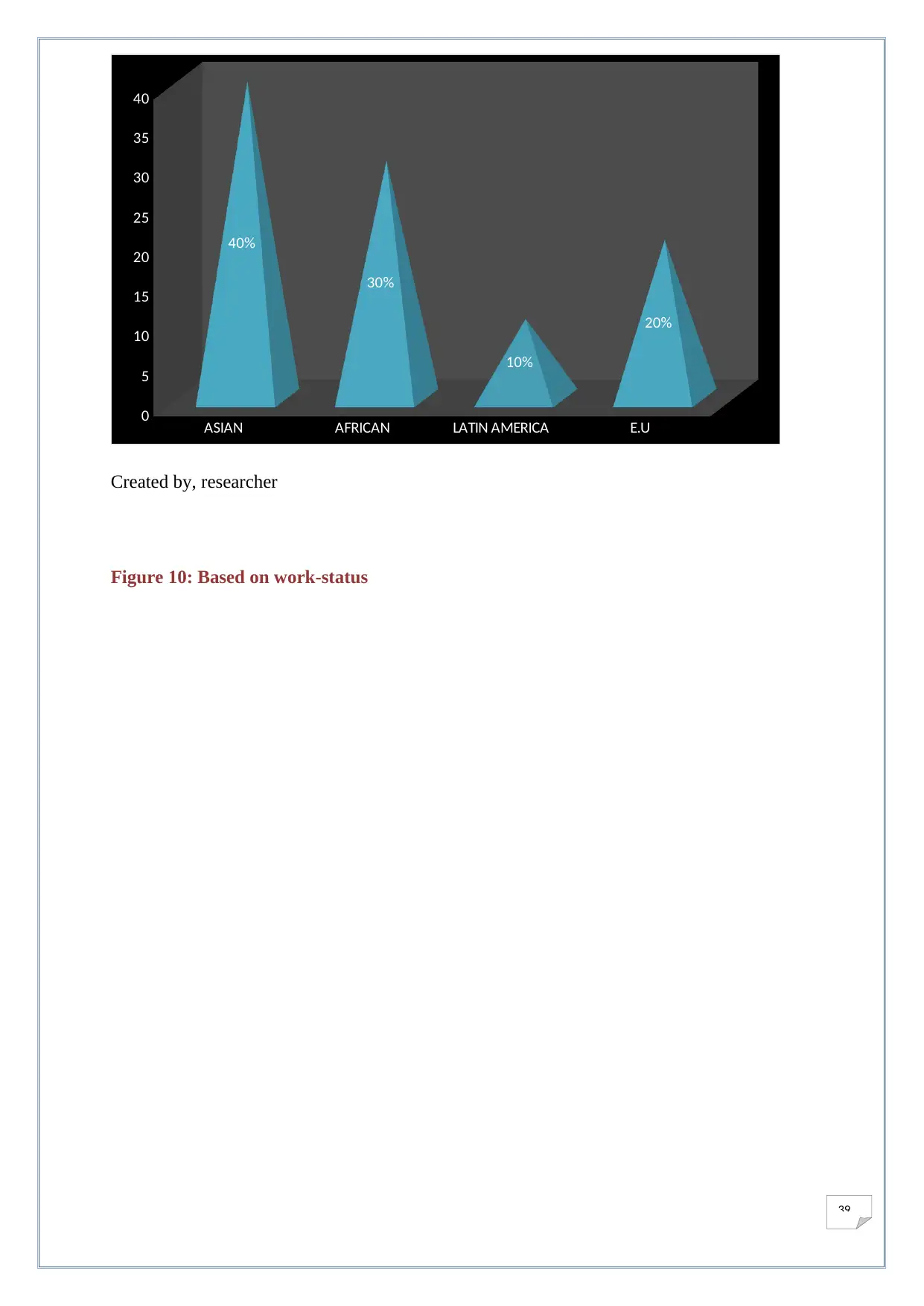
39
ASIAN AFRICAN LATIN AMERICA E.U
0
5
10
15
20
25
30
35
40
40%
30%
10%
20%
Created by, researcher
Figure 10: Based on work-status
ASIAN AFRICAN LATIN AMERICA E.U
0
5
10
15
20
25
30
35
40
40%
30%
10%
20%
Created by, researcher
Figure 10: Based on work-status
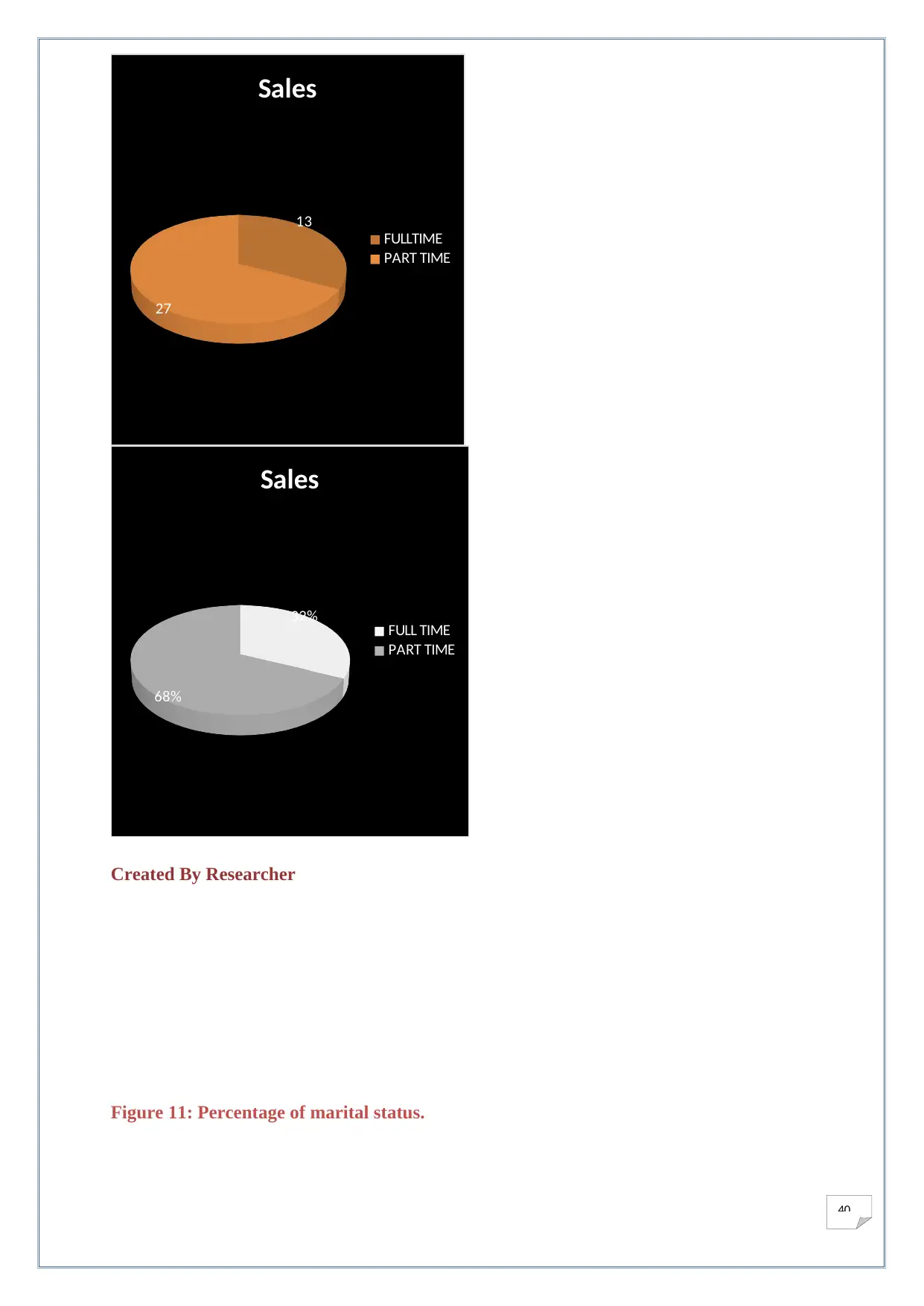
40
32%
68%
Sales
FULL TIME
PART TIME
Created By Researcher
Figure 11: Percentage of marital status.
13
27
Sales
FULLTIME
PART TIME
32%
68%
Sales
FULL TIME
PART TIME
Created By Researcher
Figure 11: Percentage of marital status.
13
27
Sales
FULLTIME
PART TIME
Secure Best Marks with AI Grader
Need help grading? Try our AI Grader for instant feedback on your assignments.
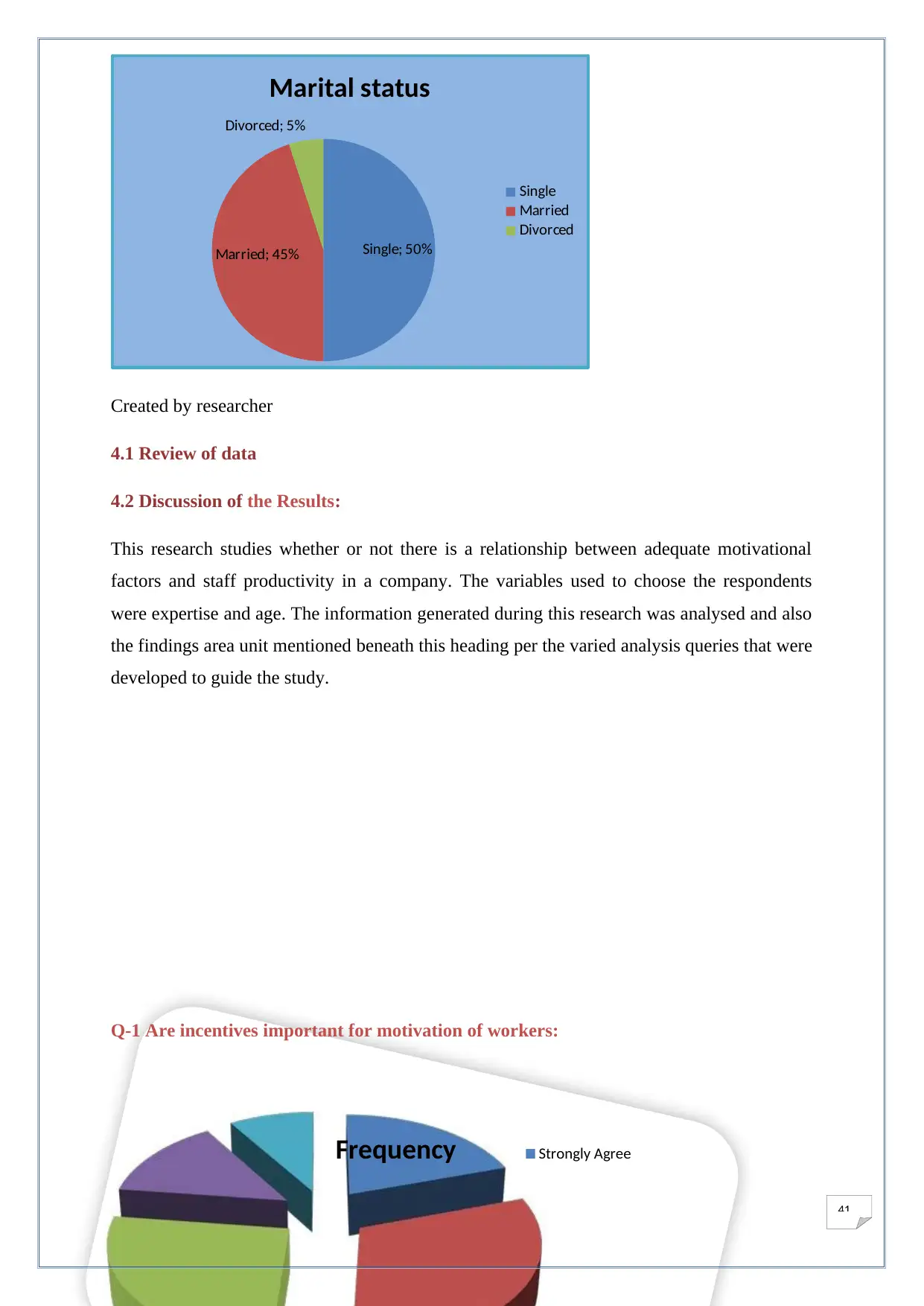
41
Single; 50%Married; 45%
Divorced; 5%
Marital status
Single
Married
Divorced
Created by researcher
4.1 Review of data
4.2 Discussion of the Results:
This research studies whether or not there is a relationship between adequate motivational
factors and staff productivity in a company. The variables used to choose the respondents
were expertise and age. The information generated during this research was analysed and also
the findings area unit mentioned beneath this heading per the varied analysis queries that were
developed to guide the study.
Q-1 Are incentives important for motivation of workers:
Frequency Strongly Agree
Single; 50%Married; 45%
Divorced; 5%
Marital status
Single
Married
Divorced
Created by researcher
4.1 Review of data
4.2 Discussion of the Results:
This research studies whether or not there is a relationship between adequate motivational
factors and staff productivity in a company. The variables used to choose the respondents
were expertise and age. The information generated during this research was analysed and also
the findings area unit mentioned beneath this heading per the varied analysis queries that were
developed to guide the study.
Q-1 Are incentives important for motivation of workers:
Frequency Strongly Agree
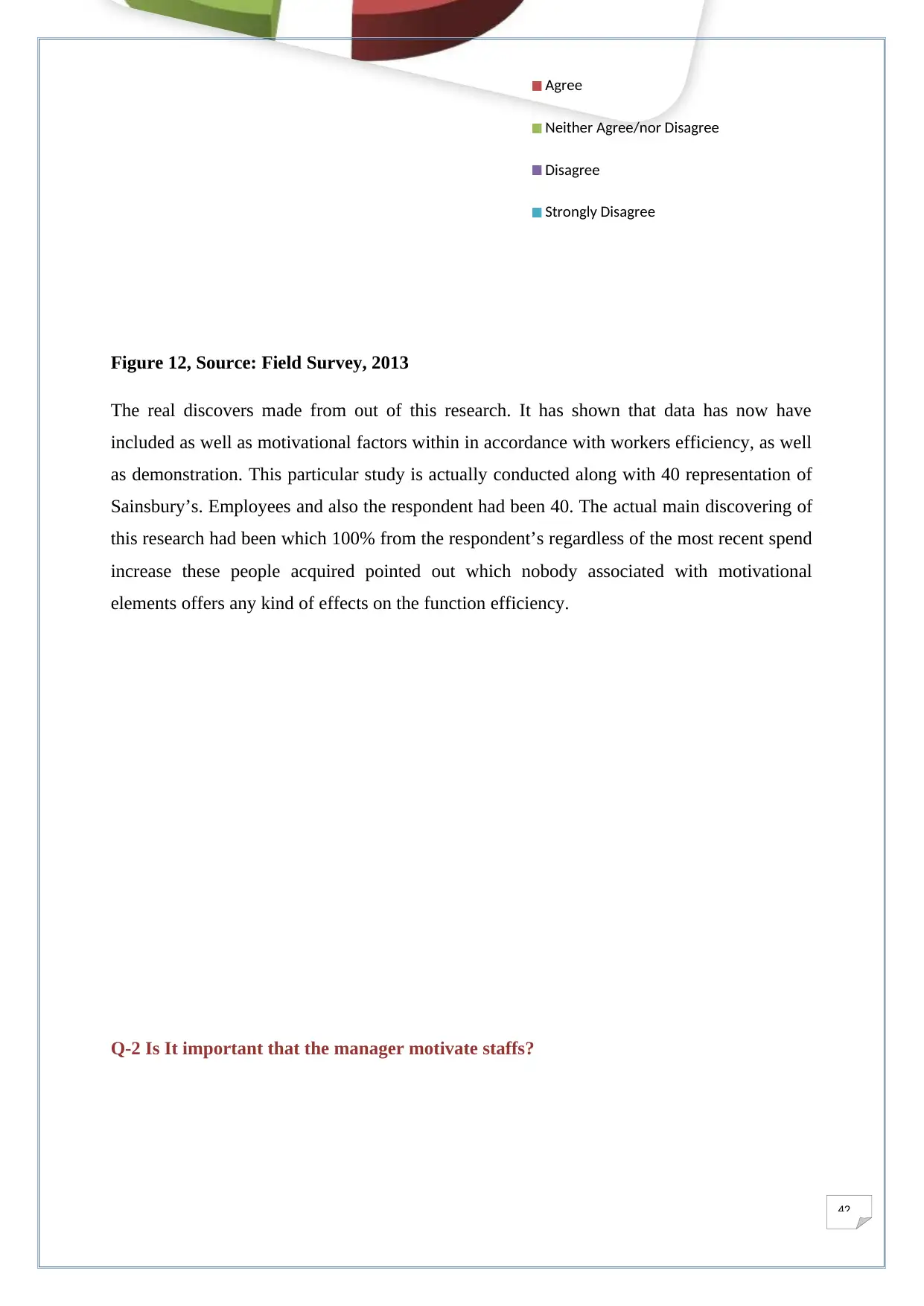
42
Agree
Neither Agree/nor Disagree
Disagree
Strongly Disagree
Figure 12, Source: Field Survey, 2013
The real discovers made from out of this research. It has shown that data has now have
included as well as motivational factors within in accordance with workers efficiency, as well
as demonstration. This particular study is actually conducted along with 40 representation of
Sainsbury’s. Employees and also the respondent had been 40. The actual main discovering of
this research had been which 100% from the respondent’s regardless of the most recent spend
increase these people acquired pointed out which nobody associated with motivational
elements offers any kind of effects on the function efficiency.
Q-2 Is It important that the manager motivate staffs?
Agree
Neither Agree/nor Disagree
Disagree
Strongly Disagree
Figure 12, Source: Field Survey, 2013
The real discovers made from out of this research. It has shown that data has now have
included as well as motivational factors within in accordance with workers efficiency, as well
as demonstration. This particular study is actually conducted along with 40 representation of
Sainsbury’s. Employees and also the respondent had been 40. The actual main discovering of
this research had been which 100% from the respondent’s regardless of the most recent spend
increase these people acquired pointed out which nobody associated with motivational
elements offers any kind of effects on the function efficiency.
Q-2 Is It important that the manager motivate staffs?
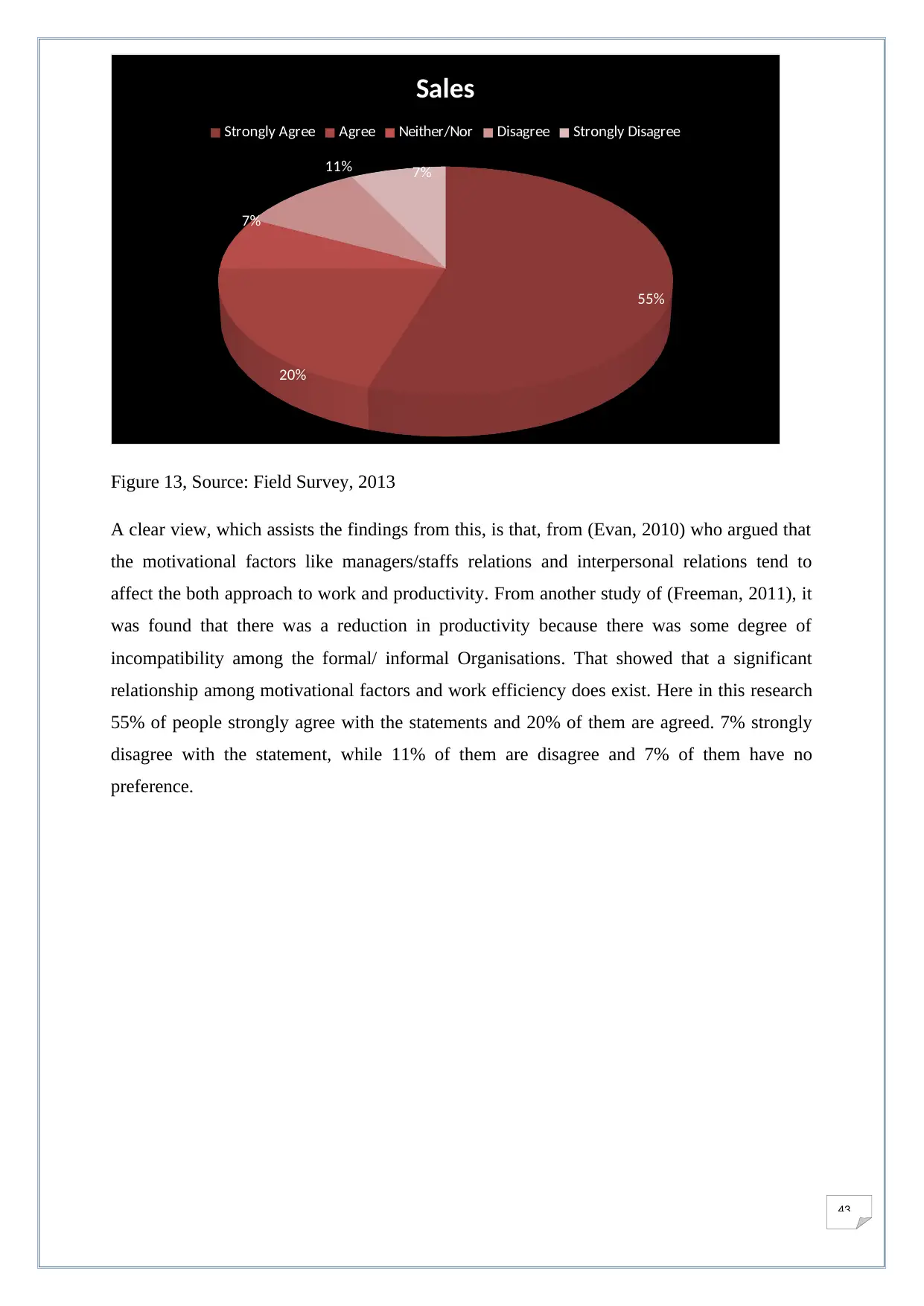
43
55%
20%
7%
11% 7%
Sales
Strongly Agree Agree Neither/Nor Disagree Strongly Disagree
Figure 13, Source: Field Survey, 2013
A clear view, which assists the findings from this, is that, from (Evan, 2010) who argued that
the motivational factors like managers/staffs relations and interpersonal relations tend to
affect the both approach to work and productivity. From another study of (Freeman, 2011), it
was found that there was a reduction in productivity because there was some degree of
incompatibility among the formal/ informal Organisations. That showed that a significant
relationship among motivational factors and work efficiency does exist. Here in this research
55% of people strongly agree with the statements and 20% of them are agreed. 7% strongly
disagree with the statement, while 11% of them are disagree and 7% of them have no
preference.
55%
20%
7%
11% 7%
Sales
Strongly Agree Agree Neither/Nor Disagree Strongly Disagree
Figure 13, Source: Field Survey, 2013
A clear view, which assists the findings from this, is that, from (Evan, 2010) who argued that
the motivational factors like managers/staffs relations and interpersonal relations tend to
affect the both approach to work and productivity. From another study of (Freeman, 2011), it
was found that there was a reduction in productivity because there was some degree of
incompatibility among the formal/ informal Organisations. That showed that a significant
relationship among motivational factors and work efficiency does exist. Here in this research
55% of people strongly agree with the statements and 20% of them are agreed. 7% strongly
disagree with the statement, while 11% of them are disagree and 7% of them have no
preference.
Paraphrase This Document
Need a fresh take? Get an instant paraphrase of this document with our AI Paraphraser
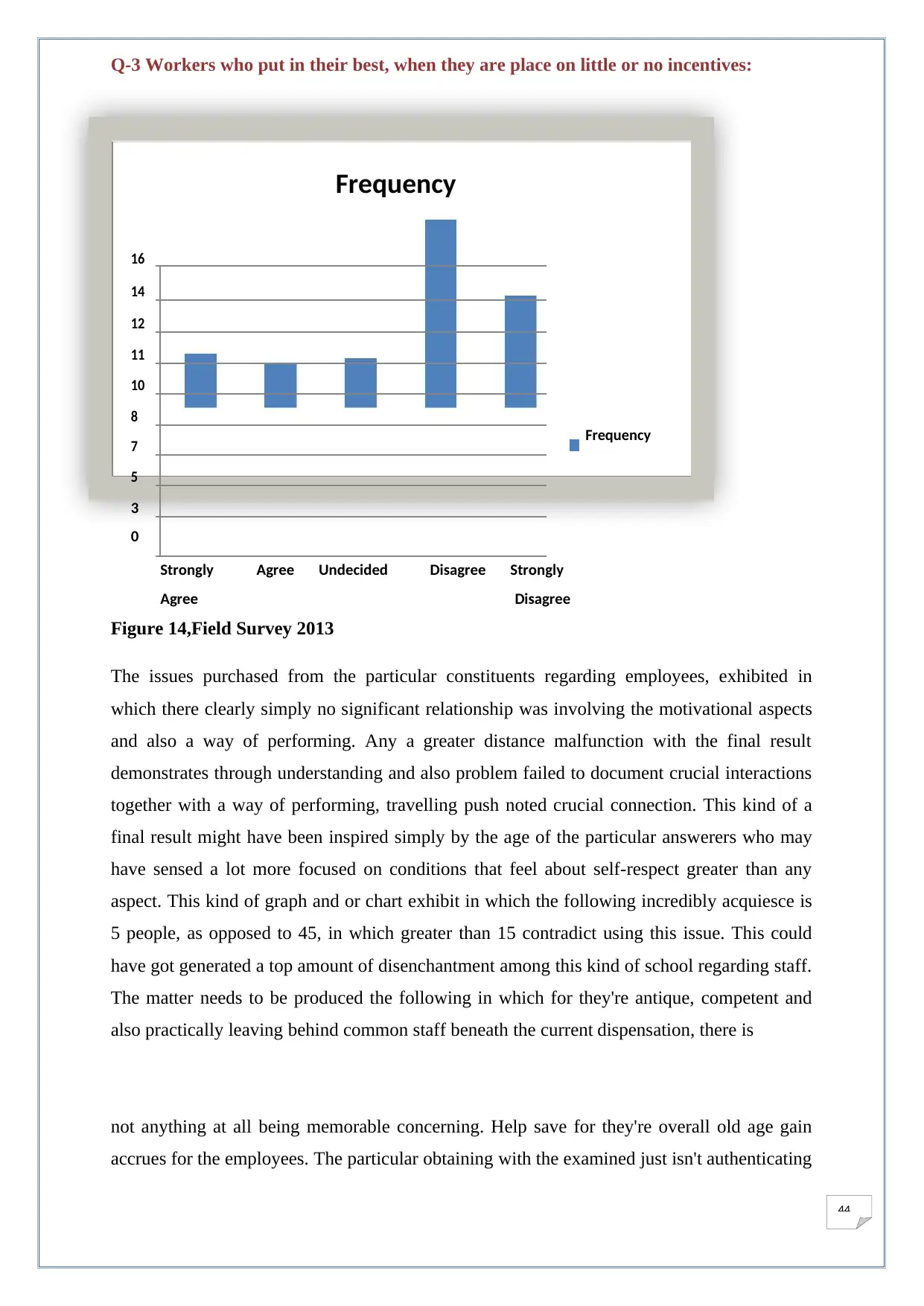
44
Q-3 Workers who put in their best, when they are place on little or no incentives:
Frequency
16
14
12
11
10
8
Frequency
7
5
3
0
Strongly Agree Undecided Disagree Strongly
Agree Disagree
Figure 14,Field Survey 2013
The issues purchased from the particular constituents regarding employees, exhibited in
which there clearly simply no significant relationship was involving the motivational aspects
and also a way of performing. Any a greater distance malfunction with the final result
demonstrates through understanding and also problem failed to document crucial interactions
together with a way of performing, travelling push noted crucial connection. This kind of a
final result might have been inspired simply by the age of the particular answerers who may
have sensed a lot more focused on conditions that feel about self-respect greater than any
aspect. This kind of graph and or chart exhibit in which the following incredibly acquiesce is
5 people, as opposed to 45, in which greater than 15 contradict using this issue. This could
have got generated a top amount of disenchantment among this kind of school regarding staff.
The matter needs to be produced the following in which for they're antique, competent and
also practically leaving behind common staff beneath the current dispensation, there is
not anything at all being memorable concerning. Help save for they're overall old age gain
accrues for the employees. The particular obtaining with the examined just isn't authenticating
Q-3 Workers who put in their best, when they are place on little or no incentives:
Frequency
16
14
12
11
10
8
Frequency
7
5
3
0
Strongly Agree Undecided Disagree Strongly
Agree Disagree
Figure 14,Field Survey 2013
The issues purchased from the particular constituents regarding employees, exhibited in
which there clearly simply no significant relationship was involving the motivational aspects
and also a way of performing. Any a greater distance malfunction with the final result
demonstrates through understanding and also problem failed to document crucial interactions
together with a way of performing, travelling push noted crucial connection. This kind of a
final result might have been inspired simply by the age of the particular answerers who may
have sensed a lot more focused on conditions that feel about self-respect greater than any
aspect. This kind of graph and or chart exhibit in which the following incredibly acquiesce is
5 people, as opposed to 45, in which greater than 15 contradict using this issue. This could
have got generated a top amount of disenchantment among this kind of school regarding staff.
The matter needs to be produced the following in which for they're antique, competent and
also practically leaving behind common staff beneath the current dispensation, there is
not anything at all being memorable concerning. Help save for they're overall old age gain
accrues for the employees. The particular obtaining with the examined just isn't authenticating
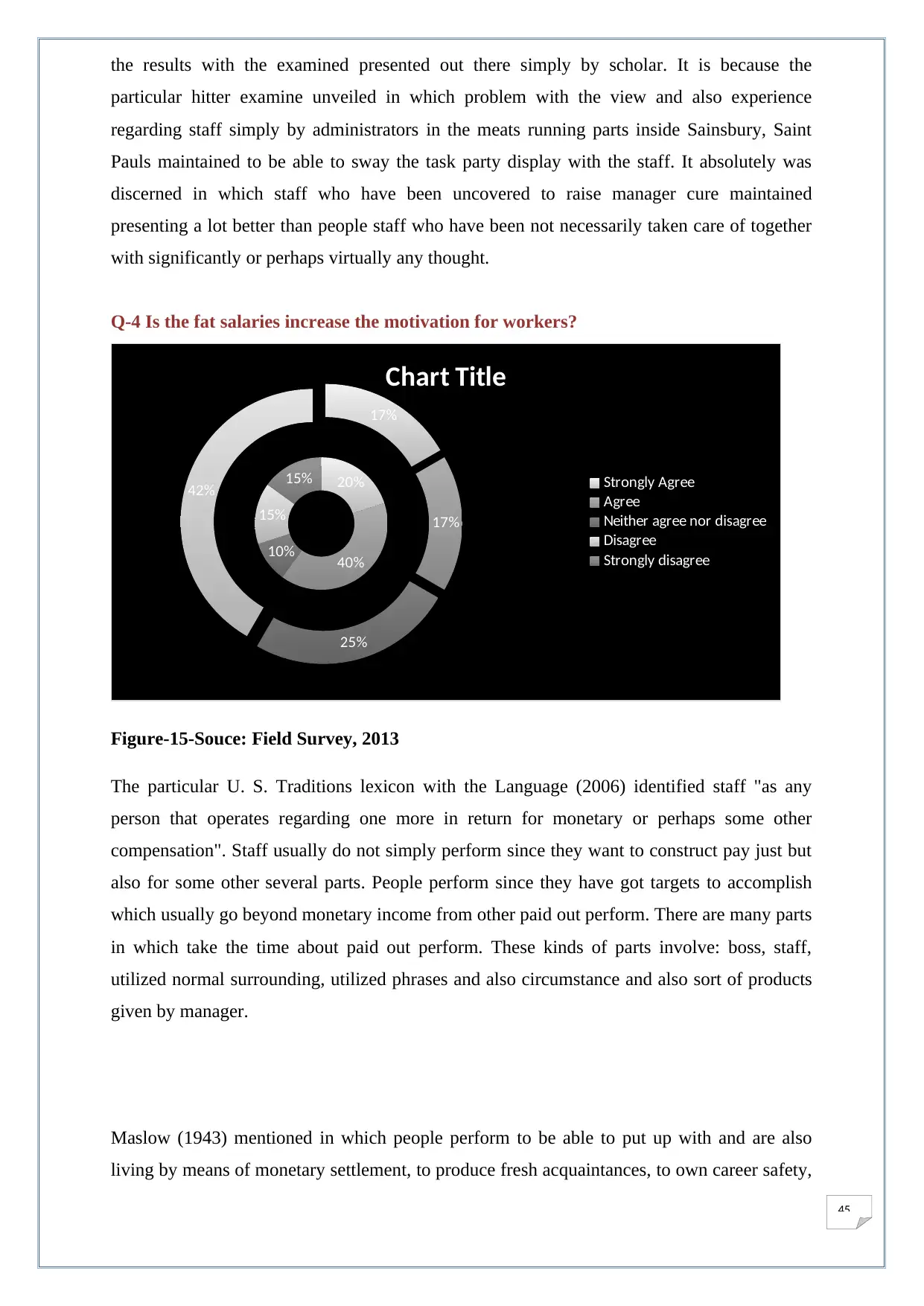
45
the results with the examined presented out there simply by scholar. It is because the
particular hitter examine unveiled in which problem with the view and also experience
regarding staff simply by administrators in the meats running parts inside Sainsbury, Saint
Pauls maintained to be able to sway the task party display with the staff. It absolutely was
discerned in which staff who have been uncovered to raise manager cure maintained
presenting a lot better than people staff who have been not necessarily taken care of together
with significantly or perhaps virtually any thought.
Q-4 Is the fat salaries increase the motivation for workers?
20%
40%
10%
15%
15%
17%
17%
25%
42%
Chart Title
Strongly Agree
Agree
Neither agree nor disagree
Disagree
Strongly disagree
Figure-15-Souce: Field Survey, 2013
The particular U. S. Traditions lexicon with the Language (2006) identified staff "as any
person that operates regarding one more in return for monetary or perhaps some other
compensation". Staff usually do not simply perform since they want to construct pay just but
also for some other several parts. People perform since they have got targets to accomplish
which usually go beyond monetary income from other paid out perform. There are many parts
in which take the time about paid out perform. These kinds of parts involve: boss, staff,
utilized normal surrounding, utilized phrases and also circumstance and also sort of products
given by manager.
Maslow (1943) mentioned in which people perform to be able to put up with and are also
living by means of monetary settlement, to produce fresh acquaintances, to own career safety,
the results with the examined presented out there simply by scholar. It is because the
particular hitter examine unveiled in which problem with the view and also experience
regarding staff simply by administrators in the meats running parts inside Sainsbury, Saint
Pauls maintained to be able to sway the task party display with the staff. It absolutely was
discerned in which staff who have been uncovered to raise manager cure maintained
presenting a lot better than people staff who have been not necessarily taken care of together
with significantly or perhaps virtually any thought.
Q-4 Is the fat salaries increase the motivation for workers?
20%
40%
10%
15%
15%
17%
17%
25%
42%
Chart Title
Strongly Agree
Agree
Neither agree nor disagree
Disagree
Strongly disagree
Figure-15-Souce: Field Survey, 2013
The particular U. S. Traditions lexicon with the Language (2006) identified staff "as any
person that operates regarding one more in return for monetary or perhaps some other
compensation". Staff usually do not simply perform since they want to construct pay just but
also for some other several parts. People perform since they have got targets to accomplish
which usually go beyond monetary income from other paid out perform. There are many parts
in which take the time about paid out perform. These kinds of parts involve: boss, staff,
utilized normal surrounding, utilized phrases and also circumstance and also sort of products
given by manager.
Maslow (1943) mentioned in which people perform to be able to put up with and are also
living by means of monetary settlement, to produce fresh acquaintances, to own career safety,
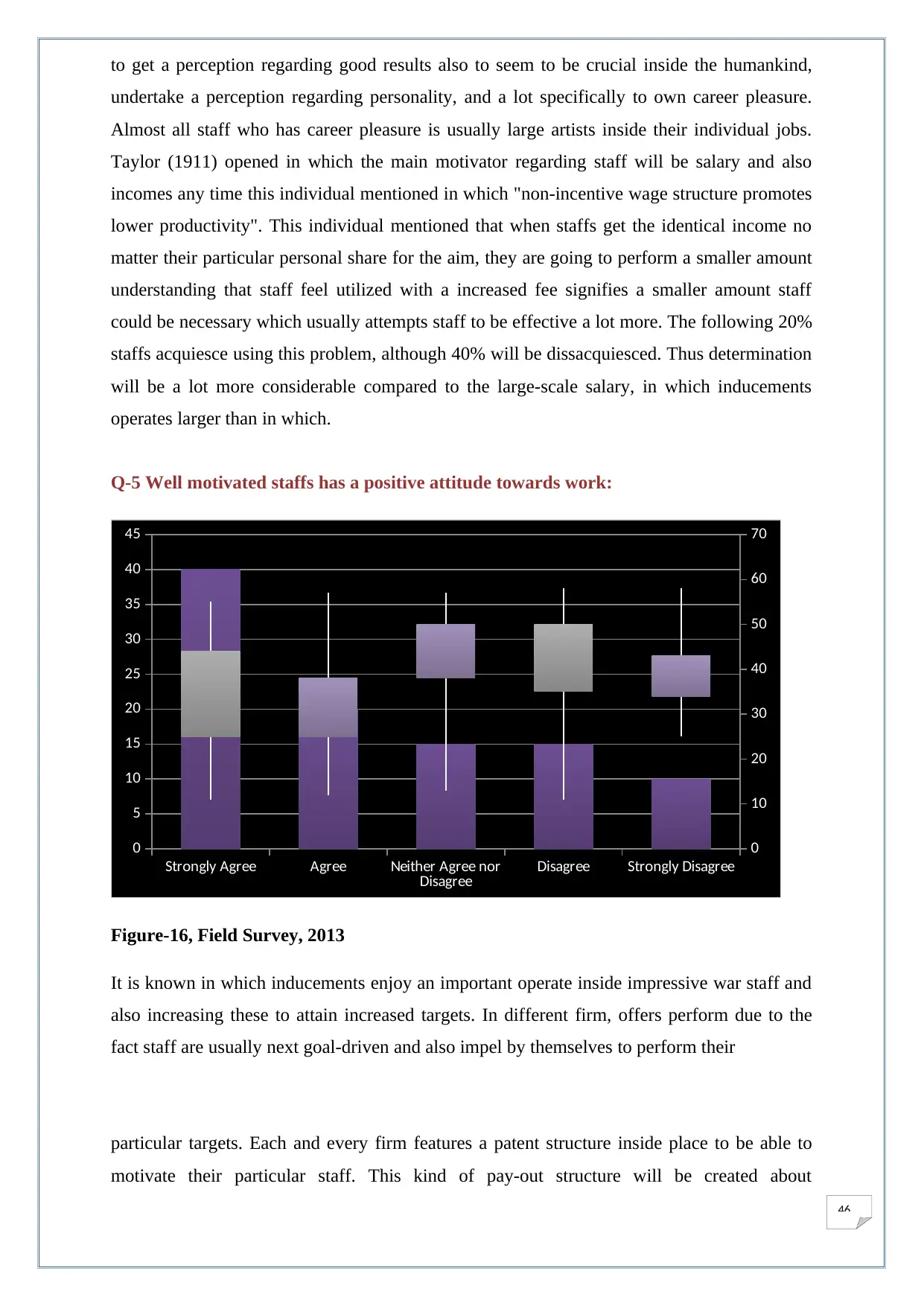
46
to get a perception regarding good results also to seem to be crucial inside the humankind,
undertake a perception regarding personality, and a lot specifically to own career pleasure.
Almost all staff who has career pleasure is usually large artists inside their individual jobs.
Taylor (1911) opened in which the main motivator regarding staff will be salary and also
incomes any time this individual mentioned in which "non-incentive wage structure promotes
lower productivity". This individual mentioned that when staffs get the identical income no
matter their particular personal share for the aim, they are going to perform a smaller amount
understanding that staff feel utilized with a increased fee signifies a smaller amount staff
could be necessary which usually attempts staff to be effective a lot more. The following 20%
staffs acquiesce using this problem, although 40% will be dissacquiesced. Thus determination
will be a lot more considerable compared to the large-scale salary, in which inducements
operates larger than in which.
Q-5 Well motivated staffs has a positive attitude towards work:
Strongly Agree Agree Neither Agree nor
Disagree Disagree Strongly Disagree
0
5
10
15
20
25
30
35
40
45
0
10
20
30
40
50
60
70
Figure-16, Field Survey, 2013
It is known in which inducements enjoy an important operate inside impressive war staff and
also increasing these to attain increased targets. In different firm, offers perform due to the
fact staff are usually next goal-driven and also impel by themselves to perform their
particular targets. Each and every firm features a patent structure inside place to be able to
motivate their particular staff. This kind of pay-out structure will be created about
to get a perception regarding good results also to seem to be crucial inside the humankind,
undertake a perception regarding personality, and a lot specifically to own career pleasure.
Almost all staff who has career pleasure is usually large artists inside their individual jobs.
Taylor (1911) opened in which the main motivator regarding staff will be salary and also
incomes any time this individual mentioned in which "non-incentive wage structure promotes
lower productivity". This individual mentioned that when staffs get the identical income no
matter their particular personal share for the aim, they are going to perform a smaller amount
understanding that staff feel utilized with a increased fee signifies a smaller amount staff
could be necessary which usually attempts staff to be effective a lot more. The following 20%
staffs acquiesce using this problem, although 40% will be dissacquiesced. Thus determination
will be a lot more considerable compared to the large-scale salary, in which inducements
operates larger than in which.
Q-5 Well motivated staffs has a positive attitude towards work:
Strongly Agree Agree Neither Agree nor
Disagree Disagree Strongly Disagree
0
5
10
15
20
25
30
35
40
45
0
10
20
30
40
50
60
70
Figure-16, Field Survey, 2013
It is known in which inducements enjoy an important operate inside impressive war staff and
also increasing these to attain increased targets. In different firm, offers perform due to the
fact staff are usually next goal-driven and also impel by themselves to perform their
particular targets. Each and every firm features a patent structure inside place to be able to
motivate their particular staff. This kind of pay-out structure will be created about
Secure Best Marks with AI Grader
Need help grading? Try our AI Grader for instant feedback on your assignments.
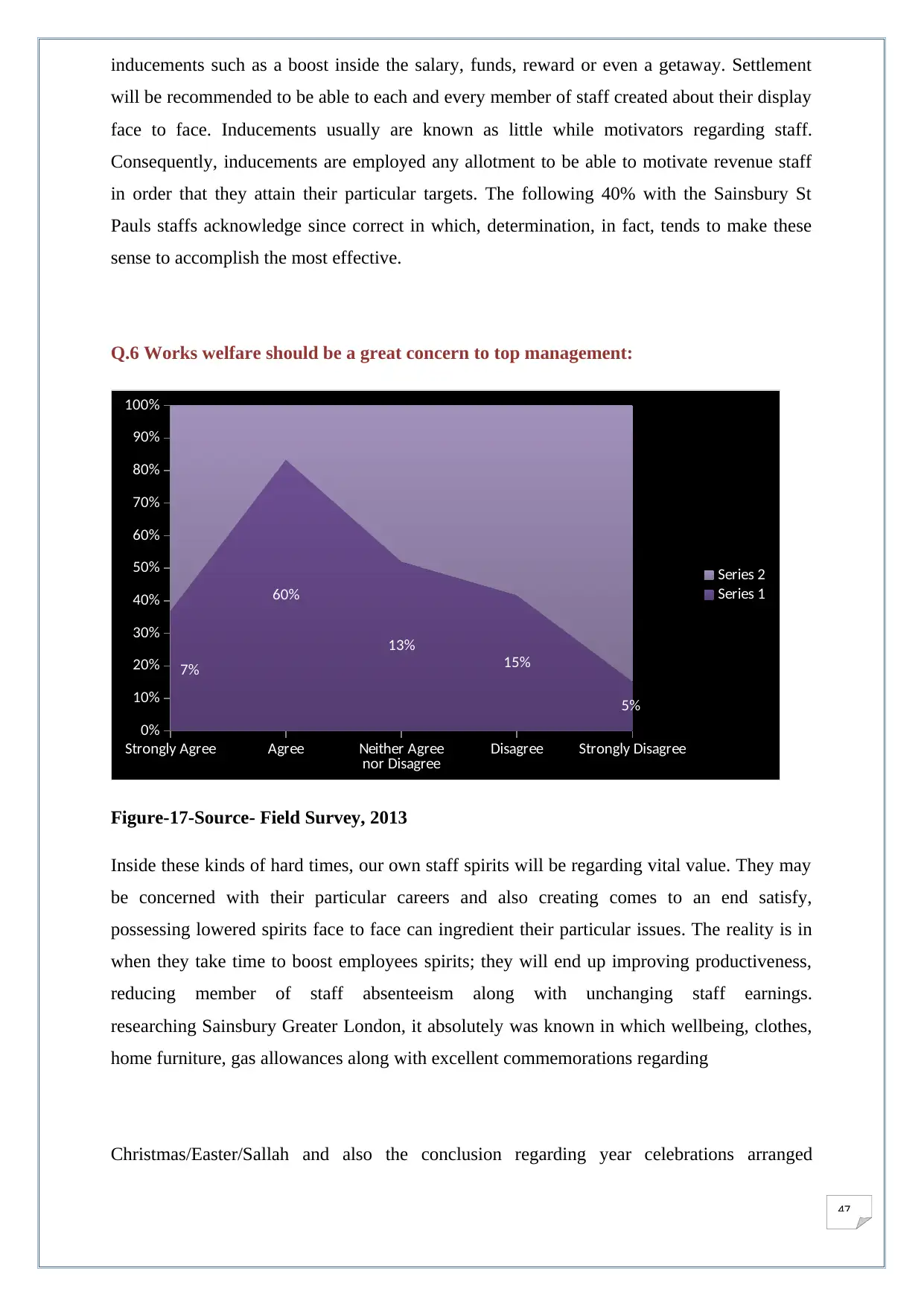
47
inducements such as a boost inside the salary, funds, reward or even a getaway. Settlement
will be recommended to be able to each and every member of staff created about their display
face to face. Inducements usually are known as little while motivators regarding staff.
Consequently, inducements are employed any allotment to be able to motivate revenue staff
in order that they attain their particular targets. The following 40% with the Sainsbury St
Pauls staffs acknowledge since correct in which, determination, in fact, tends to make these
sense to accomplish the most effective.
Q.6 Works welfare should be a great concern to top management:
Strongly Agree Agree Neither Agree
nor Disagree Disagree Strongly Disagree
0%
10%
20%
30%
40%
50%
60%
70%
80%
90%
100%
7%
60%
13%
15%
5%
Series 2
Series 1
Figure-17-Source- Field Survey, 2013
Inside these kinds of hard times, our own staff spirits will be regarding vital value. They may
be concerned with their particular careers and also creating comes to an end satisfy,
possessing lowered spirits face to face can ingredient their particular issues. The reality is in
when they take time to boost employees spirits; they will end up improving productiveness,
reducing member of staff absenteeism along with unchanging staff earnings.
researching Sainsbury Greater London, it absolutely was known in which wellbeing, clothes,
home furniture, gas allowances along with excellent commemorations regarding
Christmas/Easter/Sallah and also the conclusion regarding year celebrations arranged
inducements such as a boost inside the salary, funds, reward or even a getaway. Settlement
will be recommended to be able to each and every member of staff created about their display
face to face. Inducements usually are known as little while motivators regarding staff.
Consequently, inducements are employed any allotment to be able to motivate revenue staff
in order that they attain their particular targets. The following 40% with the Sainsbury St
Pauls staffs acknowledge since correct in which, determination, in fact, tends to make these
sense to accomplish the most effective.
Q.6 Works welfare should be a great concern to top management:
Strongly Agree Agree Neither Agree
nor Disagree Disagree Strongly Disagree
0%
10%
20%
30%
40%
50%
60%
70%
80%
90%
100%
7%
60%
13%
15%
5%
Series 2
Series 1
Figure-17-Source- Field Survey, 2013
Inside these kinds of hard times, our own staff spirits will be regarding vital value. They may
be concerned with their particular careers and also creating comes to an end satisfy,
possessing lowered spirits face to face can ingredient their particular issues. The reality is in
when they take time to boost employees spirits; they will end up improving productiveness,
reducing member of staff absenteeism along with unchanging staff earnings.
researching Sainsbury Greater London, it absolutely was known in which wellbeing, clothes,
home furniture, gas allowances along with excellent commemorations regarding
Christmas/Easter/Sallah and also the conclusion regarding year celebrations arranged
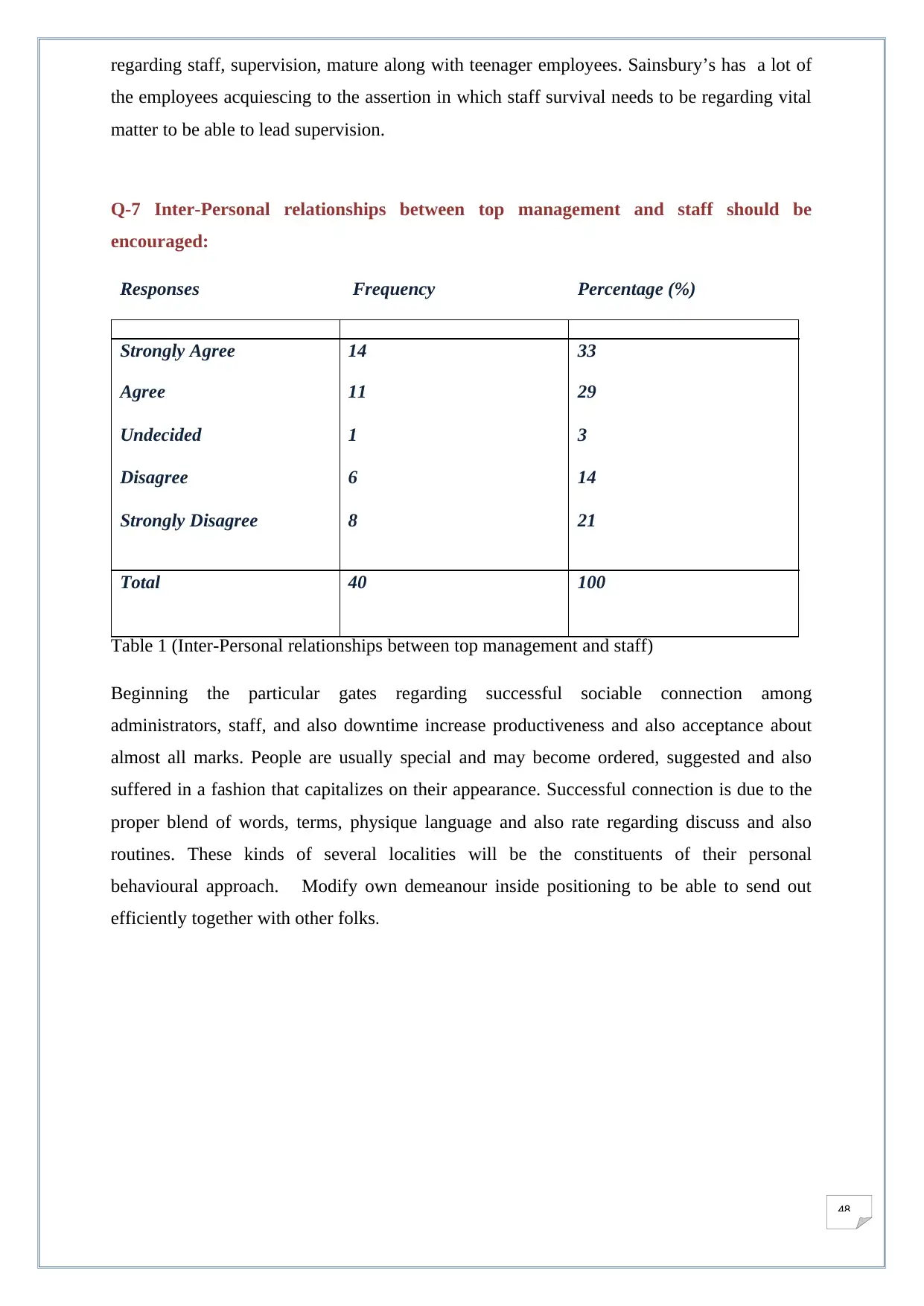
48
regarding staff, supervision, mature along with teenager employees. Sainsbury’s has a lot of
the employees acquiescing to the assertion in which staff survival needs to be regarding vital
matter to be able to lead supervision.
Q-7 Inter-Personal relationships between top management and staff should be
encouraged:
Responses Frequency Percentage (%)
Strongly Agree 14 33
Agree 11 29
Undecided 1 3
Disagree 6 14
Strongly Disagree 8 21
Total 40 100
Table 1 (Inter-Personal relationships between top management and staff)
Beginning the particular gates regarding successful sociable connection among
administrators, staff, and also downtime increase productiveness and also acceptance about
almost all marks. People are usually special and may become ordered, suggested and also
suffered in a fashion that capitalizes on their appearance. Successful connection is due to the
proper blend of words, terms, physique language and also rate regarding discuss and also
routines. These kinds of several localities will be the constituents of their personal
behavioural approach. Modify own demeanour inside positioning to be able to send out
efficiently together with other folks.
regarding staff, supervision, mature along with teenager employees. Sainsbury’s has a lot of
the employees acquiescing to the assertion in which staff survival needs to be regarding vital
matter to be able to lead supervision.
Q-7 Inter-Personal relationships between top management and staff should be
encouraged:
Responses Frequency Percentage (%)
Strongly Agree 14 33
Agree 11 29
Undecided 1 3
Disagree 6 14
Strongly Disagree 8 21
Total 40 100
Table 1 (Inter-Personal relationships between top management and staff)
Beginning the particular gates regarding successful sociable connection among
administrators, staff, and also downtime increase productiveness and also acceptance about
almost all marks. People are usually special and may become ordered, suggested and also
suffered in a fashion that capitalizes on their appearance. Successful connection is due to the
proper blend of words, terms, physique language and also rate regarding discuss and also
routines. These kinds of several localities will be the constituents of their personal
behavioural approach. Modify own demeanour inside positioning to be able to send out
efficiently together with other folks.
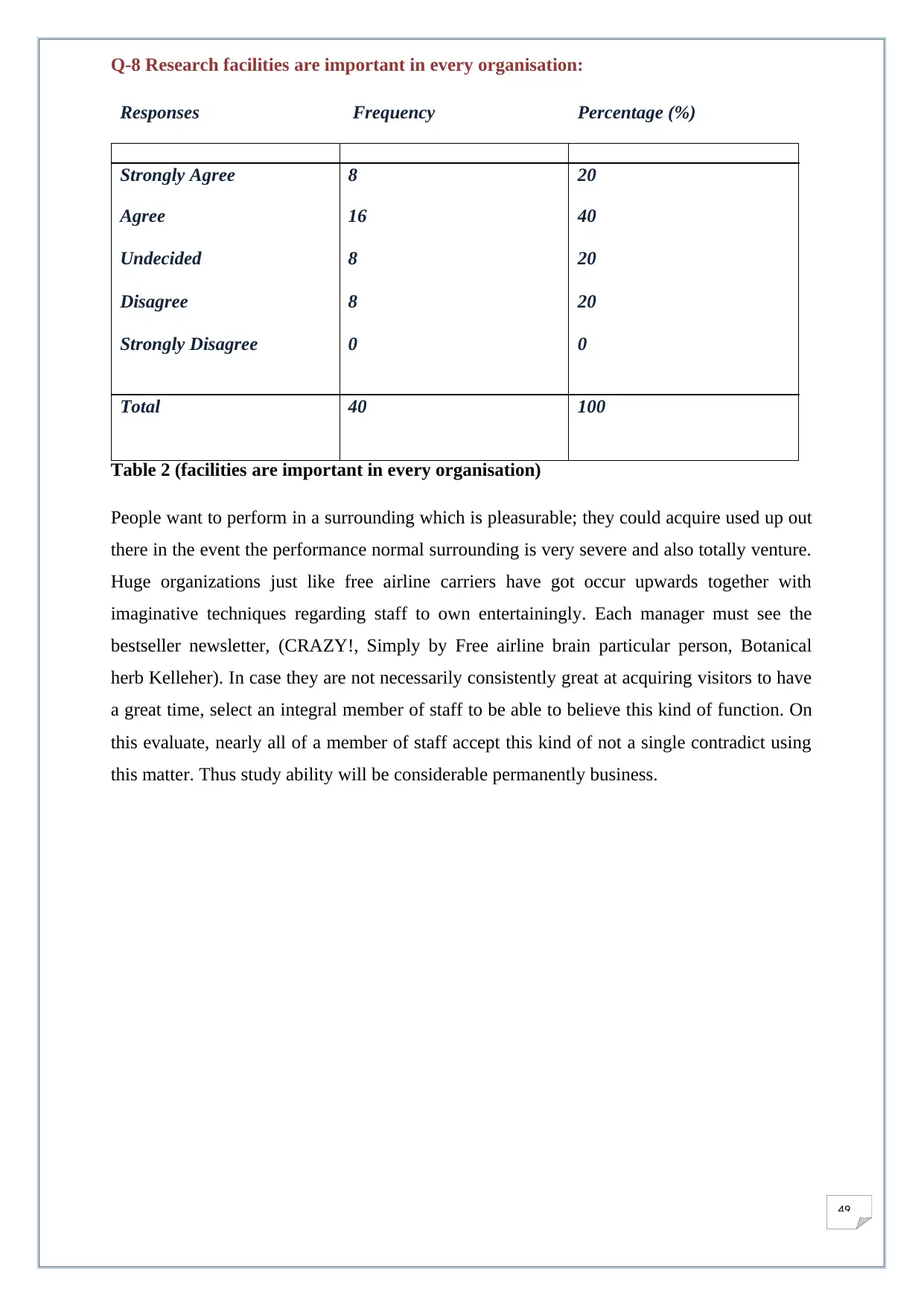
49
Q-8 Research facilities are important in every organisation:
Responses Frequency Percentage (%)
Strongly Agree 8 20
Agree 16 40
Undecided 8 20
Disagree 8 20
Strongly Disagree 0 0
Total 40 100
Table 2 (facilities are important in every organisation)
People want to perform in a surrounding which is pleasurable; they could acquire used up out
there in the event the performance normal surrounding is very severe and also totally venture.
Huge organizations just like free airline carriers have got occur upwards together with
imaginative techniques regarding staff to own entertainingly. Each manager must see the
bestseller newsletter, (CRAZY!, Simply by Free airline brain particular person, Botanical
herb Kelleher). In case they are not necessarily consistently great at acquiring visitors to have
a great time, select an integral member of staff to be able to believe this kind of function. On
this evaluate, nearly all of a member of staff accept this kind of not a single contradict using
this matter. Thus study ability will be considerable permanently business.
Q-8 Research facilities are important in every organisation:
Responses Frequency Percentage (%)
Strongly Agree 8 20
Agree 16 40
Undecided 8 20
Disagree 8 20
Strongly Disagree 0 0
Total 40 100
Table 2 (facilities are important in every organisation)
People want to perform in a surrounding which is pleasurable; they could acquire used up out
there in the event the performance normal surrounding is very severe and also totally venture.
Huge organizations just like free airline carriers have got occur upwards together with
imaginative techniques regarding staff to own entertainingly. Each manager must see the
bestseller newsletter, (CRAZY!, Simply by Free airline brain particular person, Botanical
herb Kelleher). In case they are not necessarily consistently great at acquiring visitors to have
a great time, select an integral member of staff to be able to believe this kind of function. On
this evaluate, nearly all of a member of staff accept this kind of not a single contradict using
this matter. Thus study ability will be considerable permanently business.
Paraphrase This Document
Need a fresh take? Get an instant paraphrase of this document with our AI Paraphraser
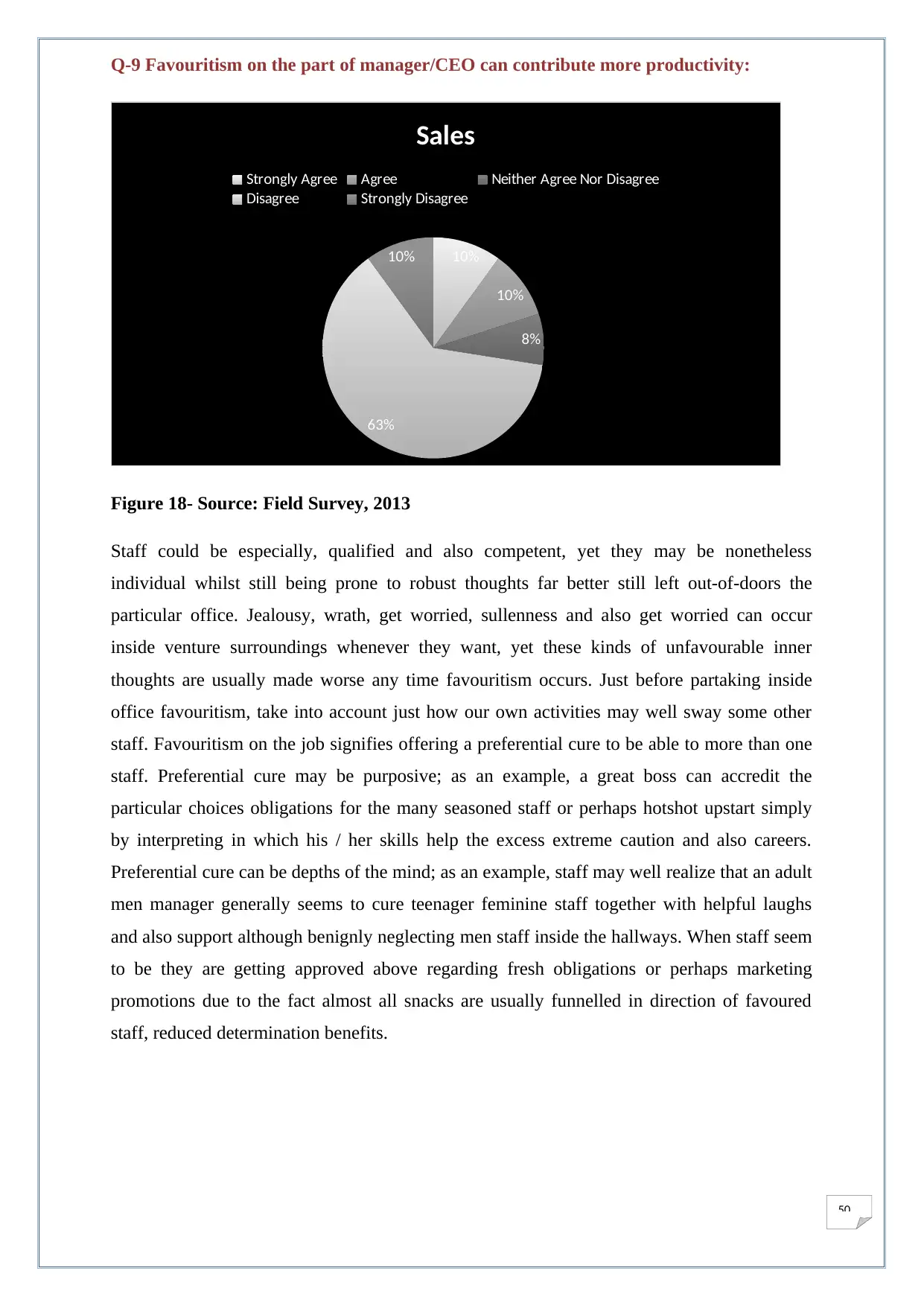
50
Q-9 Favouritism on the part of manager/CEO can contribute more productivity:
10%
10%
8%
63%
10%
Sales
Strongly Agree Agree Neither Agree Nor Disagree
Disagree Strongly Disagree
Figure 18- Source: Field Survey, 2013
Staff could be especially, qualified and also competent, yet they may be nonetheless
individual whilst still being prone to robust thoughts far better still left out-of-doors the
particular office. Jealousy, wrath, get worried, sullenness and also get worried can occur
inside venture surroundings whenever they want, yet these kinds of unfavourable inner
thoughts are usually made worse any time favouritism occurs. Just before partaking inside
office favouritism, take into account just how our own activities may well sway some other
staff. Favouritism on the job signifies offering a preferential cure to be able to more than one
staff. Preferential cure may be purposive; as an example, a great boss can accredit the
particular choices obligations for the many seasoned staff or perhaps hotshot upstart simply
by interpreting in which his / her skills help the excess extreme caution and also careers.
Preferential cure can be depths of the mind; as an example, staff may well realize that an adult
men manager generally seems to cure teenager feminine staff together with helpful laughs
and also support although benignly neglecting men staff inside the hallways. When staff seem
to be they are getting approved above regarding fresh obligations or perhaps marketing
promotions due to the fact almost all snacks are usually funnelled in direction of favoured
staff, reduced determination benefits.
Q-9 Favouritism on the part of manager/CEO can contribute more productivity:
10%
10%
8%
63%
10%
Sales
Strongly Agree Agree Neither Agree Nor Disagree
Disagree Strongly Disagree
Figure 18- Source: Field Survey, 2013
Staff could be especially, qualified and also competent, yet they may be nonetheless
individual whilst still being prone to robust thoughts far better still left out-of-doors the
particular office. Jealousy, wrath, get worried, sullenness and also get worried can occur
inside venture surroundings whenever they want, yet these kinds of unfavourable inner
thoughts are usually made worse any time favouritism occurs. Just before partaking inside
office favouritism, take into account just how our own activities may well sway some other
staff. Favouritism on the job signifies offering a preferential cure to be able to more than one
staff. Preferential cure may be purposive; as an example, a great boss can accredit the
particular choices obligations for the many seasoned staff or perhaps hotshot upstart simply
by interpreting in which his / her skills help the excess extreme caution and also careers.
Preferential cure can be depths of the mind; as an example, staff may well realize that an adult
men manager generally seems to cure teenager feminine staff together with helpful laughs
and also support although benignly neglecting men staff inside the hallways. When staff seem
to be they are getting approved above regarding fresh obligations or perhaps marketing
promotions due to the fact almost all snacks are usually funnelled in direction of favoured
staff, reduced determination benefits.
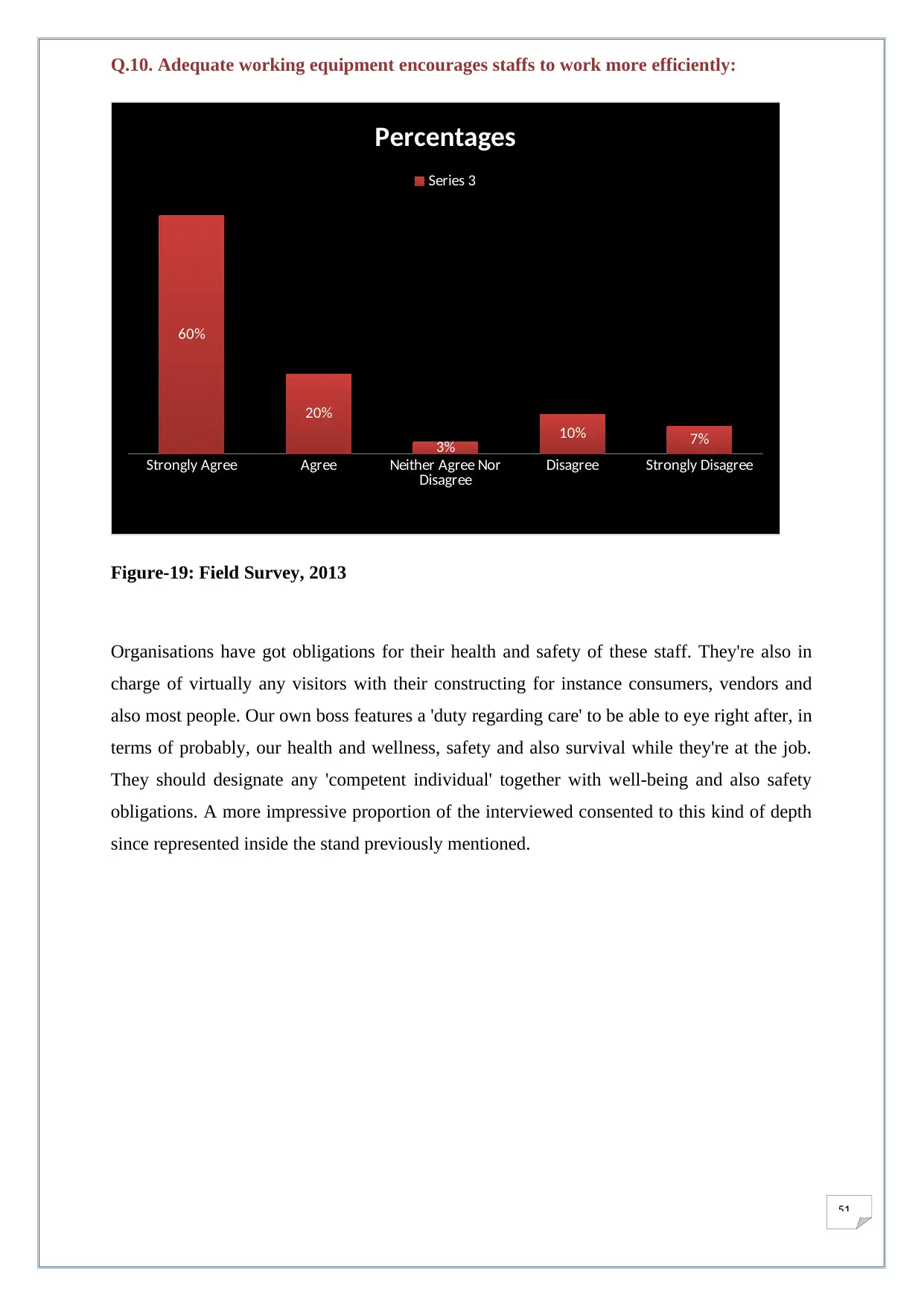
51
Q.10. Adequate working equipment encourages staffs to work more efficiently:
Strongly Agree Agree Neither Agree Nor
Disagree Disagree Strongly Disagree
60%
20%
3% 10% 7%
Percentages
Series 3
Figure-19: Field Survey, 2013
Organisations have got obligations for their health and safety of these staff. They're also in
charge of virtually any visitors with their constructing for instance consumers, vendors and
also most people. Our own boss features a 'duty regarding care' to be able to eye right after, in
terms of probably, our health and wellness, safety and also survival while they're at the job.
They should designate any 'competent individual' together with well-being and also safety
obligations. A more impressive proportion of the interviewed consented to this kind of depth
since represented inside the stand previously mentioned.
Q.10. Adequate working equipment encourages staffs to work more efficiently:
Strongly Agree Agree Neither Agree Nor
Disagree Disagree Strongly Disagree
60%
20%
3% 10% 7%
Percentages
Series 3
Figure-19: Field Survey, 2013
Organisations have got obligations for their health and safety of these staff. They're also in
charge of virtually any visitors with their constructing for instance consumers, vendors and
also most people. Our own boss features a 'duty regarding care' to be able to eye right after, in
terms of probably, our health and wellness, safety and also survival while they're at the job.
They should designate any 'competent individual' together with well-being and also safety
obligations. A more impressive proportion of the interviewed consented to this kind of depth
since represented inside the stand previously mentioned.
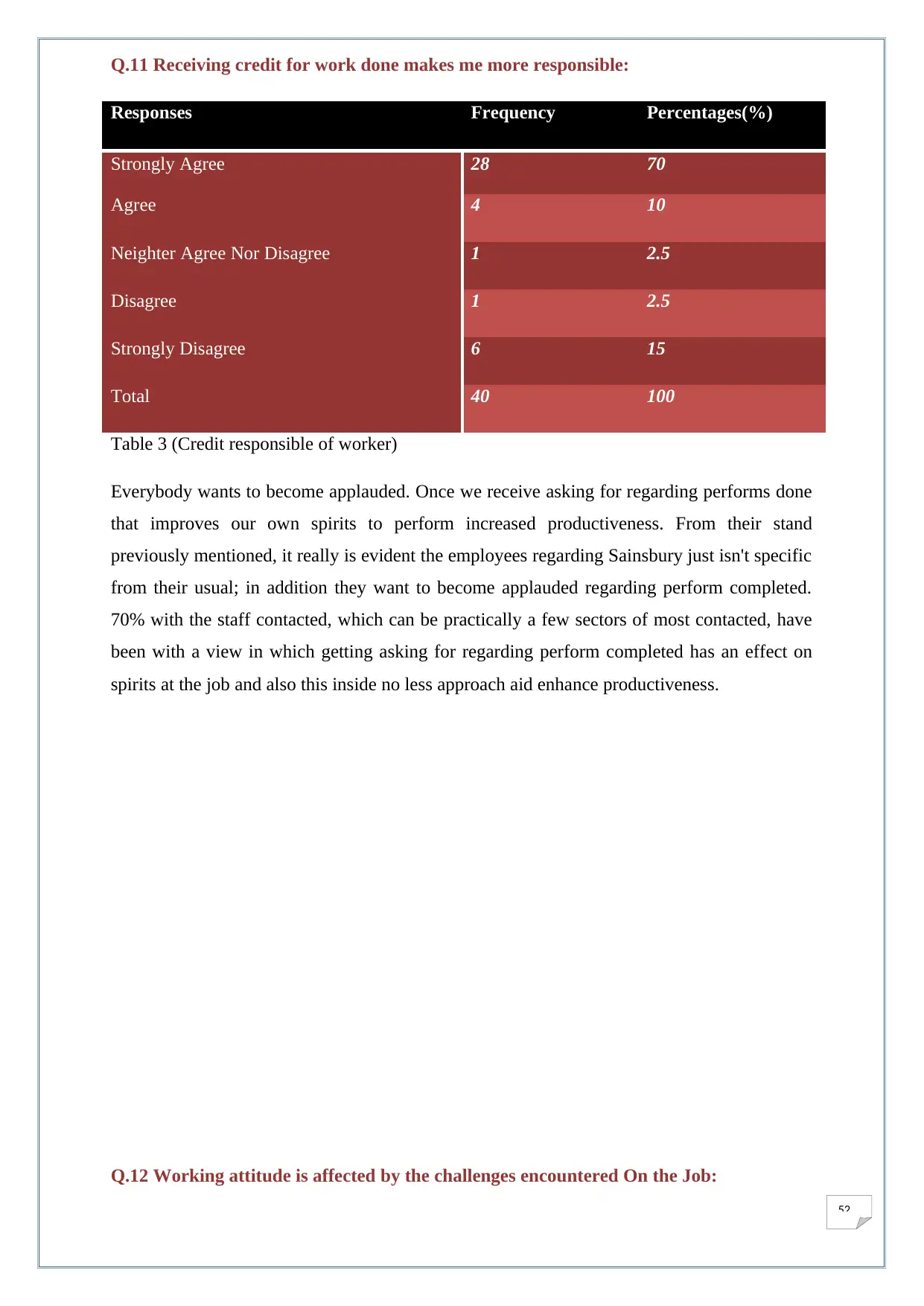
52
Q.11 Receiving credit for work done makes me more responsible:
Responses Frequency Percentages(%)
Strongly Agree 28 70
Agree 4 10
Neighter Agree Nor Disagree 1 2.5
Disagree 1 2.5
Strongly Disagree 6 15
Total 40 100
Table 3 (Credit responsible of worker)
Everybody wants to become applauded. Once we receive asking for regarding performs done
that improves our own spirits to perform increased productiveness. From their stand
previously mentioned, it really is evident the employees regarding Sainsbury just isn't specific
from their usual; in addition they want to become applauded regarding perform completed.
70% with the staff contacted, which can be practically a few sectors of most contacted, have
been with a view in which getting asking for regarding perform completed has an effect on
spirits at the job and also this inside no less approach aid enhance productiveness.
Q.12 Working attitude is affected by the challenges encountered On the Job:
Q.11 Receiving credit for work done makes me more responsible:
Responses Frequency Percentages(%)
Strongly Agree 28 70
Agree 4 10
Neighter Agree Nor Disagree 1 2.5
Disagree 1 2.5
Strongly Disagree 6 15
Total 40 100
Table 3 (Credit responsible of worker)
Everybody wants to become applauded. Once we receive asking for regarding performs done
that improves our own spirits to perform increased productiveness. From their stand
previously mentioned, it really is evident the employees regarding Sainsbury just isn't specific
from their usual; in addition they want to become applauded regarding perform completed.
70% with the staff contacted, which can be practically a few sectors of most contacted, have
been with a view in which getting asking for regarding perform completed has an effect on
spirits at the job and also this inside no less approach aid enhance productiveness.
Q.12 Working attitude is affected by the challenges encountered On the Job:
Secure Best Marks with AI Grader
Need help grading? Try our AI Grader for instant feedback on your assignments.
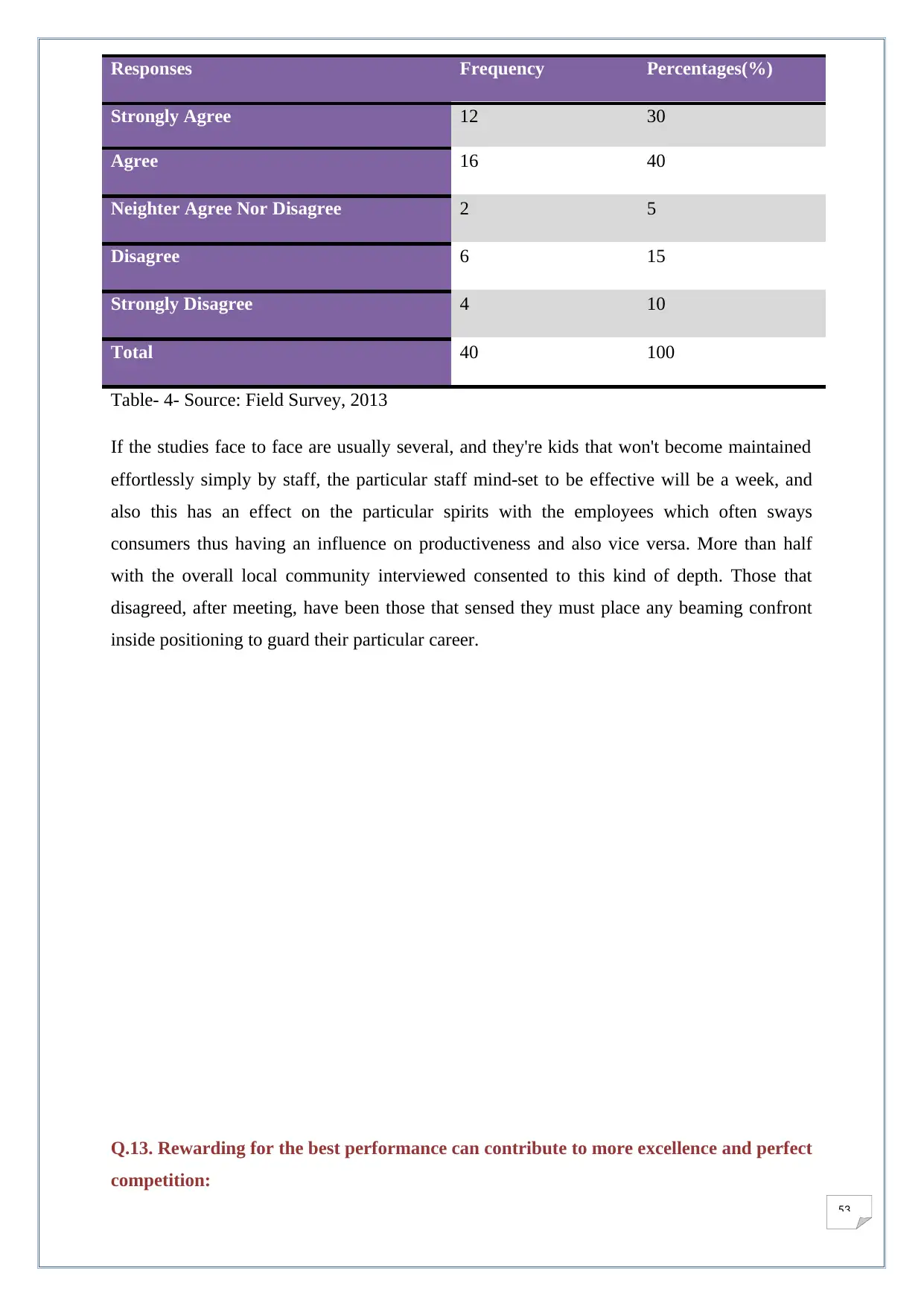
53
Responses Frequency Percentages(%)
Strongly Agree 12 30
Agree 16 40
Neighter Agree Nor Disagree 2 5
Disagree 6 15
Strongly Disagree 4 10
Total 40 100
Table- 4- Source: Field Survey, 2013
If the studies face to face are usually several, and they're kids that won't become maintained
effortlessly simply by staff, the particular staff mind-set to be effective will be a week, and
also this has an effect on the particular spirits with the employees which often sways
consumers thus having an influence on productiveness and also vice versa. More than half
with the overall local community interviewed consented to this kind of depth. Those that
disagreed, after meeting, have been those that sensed they must place any beaming confront
inside positioning to guard their particular career.
Q.13. Rewarding for the best performance can contribute to more excellence and perfect
competition:
Responses Frequency Percentages(%)
Strongly Agree 12 30
Agree 16 40
Neighter Agree Nor Disagree 2 5
Disagree 6 15
Strongly Disagree 4 10
Total 40 100
Table- 4- Source: Field Survey, 2013
If the studies face to face are usually several, and they're kids that won't become maintained
effortlessly simply by staff, the particular staff mind-set to be effective will be a week, and
also this has an effect on the particular spirits with the employees which often sways
consumers thus having an influence on productiveness and also vice versa. More than half
with the overall local community interviewed consented to this kind of depth. Those that
disagreed, after meeting, have been those that sensed they must place any beaming confront
inside positioning to guard their particular career.
Q.13. Rewarding for the best performance can contribute to more excellence and perfect
competition:
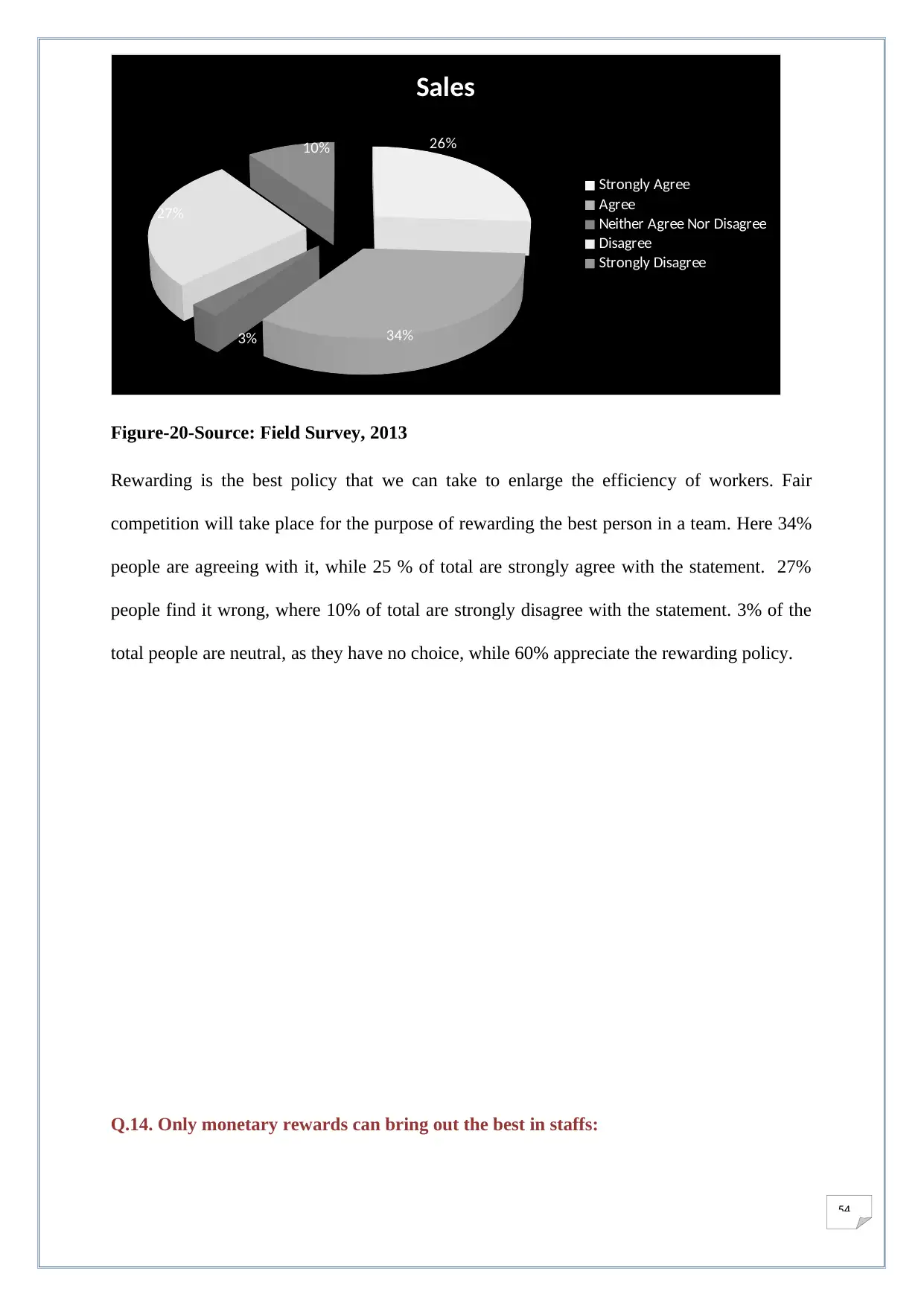
54
26%
34%3%
27%
10%
Sales
Strongly Agree
Agree
Neither Agree Nor Disagree
Disagree
Strongly Disagree
Figure-20-Source: Field Survey, 2013
Rewarding is the best policy that we can take to enlarge the efficiency of workers. Fair
competition will take place for the purpose of rewarding the best person in a team. Here 34%
people are agreeing with it, while 25 % of total are strongly agree with the statement. 27%
people find it wrong, where 10% of total are strongly disagree with the statement. 3% of the
total people are neutral, as they have no choice, while 60% appreciate the rewarding policy.
Q.14. Only monetary rewards can bring out the best in staffs:
26%
34%3%
27%
10%
Sales
Strongly Agree
Agree
Neither Agree Nor Disagree
Disagree
Strongly Disagree
Figure-20-Source: Field Survey, 2013
Rewarding is the best policy that we can take to enlarge the efficiency of workers. Fair
competition will take place for the purpose of rewarding the best person in a team. Here 34%
people are agreeing with it, while 25 % of total are strongly agree with the statement. 27%
people find it wrong, where 10% of total are strongly disagree with the statement. 3% of the
total people are neutral, as they have no choice, while 60% appreciate the rewarding policy.
Q.14. Only monetary rewards can bring out the best in staffs:
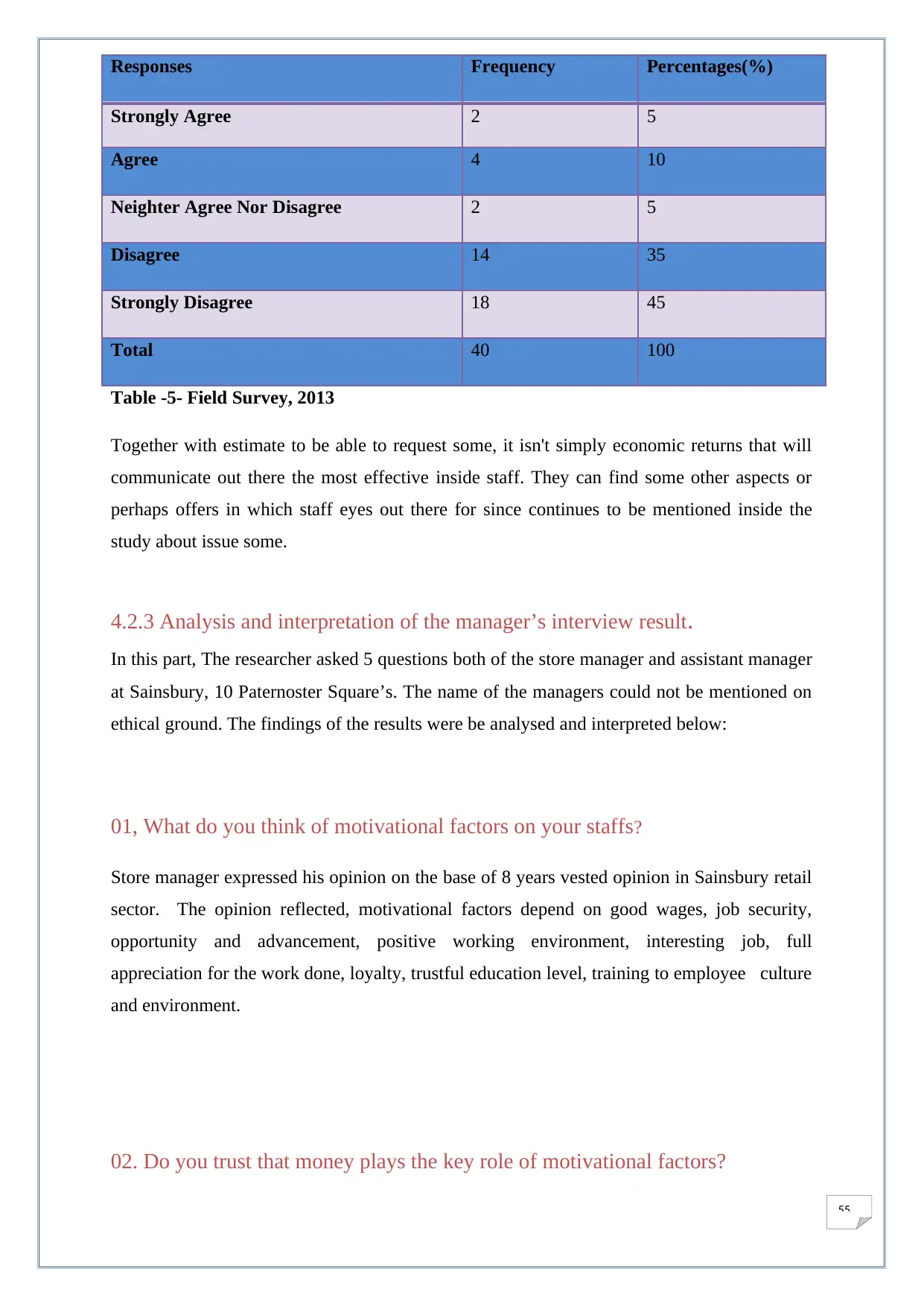
55
Responses Frequency Percentages(%)
Strongly Agree 2 5
Agree 4 10
Neighter Agree Nor Disagree 2 5
Disagree 14 35
Strongly Disagree 18 45
Total 40 100
Table -5- Field Survey, 2013
Together with estimate to be able to request some, it isn't simply economic returns that will
communicate out there the most effective inside staff. They can find some other aspects or
perhaps offers in which staff eyes out there for since continues to be mentioned inside the
study about issue some.
4.2.3 Analysis and interpretation of the manager’s interview result.
In this part, The researcher asked 5 questions both of the store manager and assistant manager
at Sainsbury, 10 Paternoster Square’s. The name of the managers could not be mentioned on
ethical ground. The findings of the results were be analysed and interpreted below:
01, What do you think of motivational factors on your staffs?
Store manager expressed his opinion on the base of 8 years vested opinion in Sainsbury retail
sector. The opinion reflected, motivational factors depend on good wages, job security,
opportunity and advancement, positive working environment, interesting job, full
appreciation for the work done, loyalty, trustful education level, training to employee culture
and environment.
02. Do you trust that money plays the key role of motivational factors?
Responses Frequency Percentages(%)
Strongly Agree 2 5
Agree 4 10
Neighter Agree Nor Disagree 2 5
Disagree 14 35
Strongly Disagree 18 45
Total 40 100
Table -5- Field Survey, 2013
Together with estimate to be able to request some, it isn't simply economic returns that will
communicate out there the most effective inside staff. They can find some other aspects or
perhaps offers in which staff eyes out there for since continues to be mentioned inside the
study about issue some.
4.2.3 Analysis and interpretation of the manager’s interview result.
In this part, The researcher asked 5 questions both of the store manager and assistant manager
at Sainsbury, 10 Paternoster Square’s. The name of the managers could not be mentioned on
ethical ground. The findings of the results were be analysed and interpreted below:
01, What do you think of motivational factors on your staffs?
Store manager expressed his opinion on the base of 8 years vested opinion in Sainsbury retail
sector. The opinion reflected, motivational factors depend on good wages, job security,
opportunity and advancement, positive working environment, interesting job, full
appreciation for the work done, loyalty, trustful education level, training to employee culture
and environment.
02. Do you trust that money plays the key role of motivational factors?
Paraphrase This Document
Need a fresh take? Get an instant paraphrase of this document with our AI Paraphraser
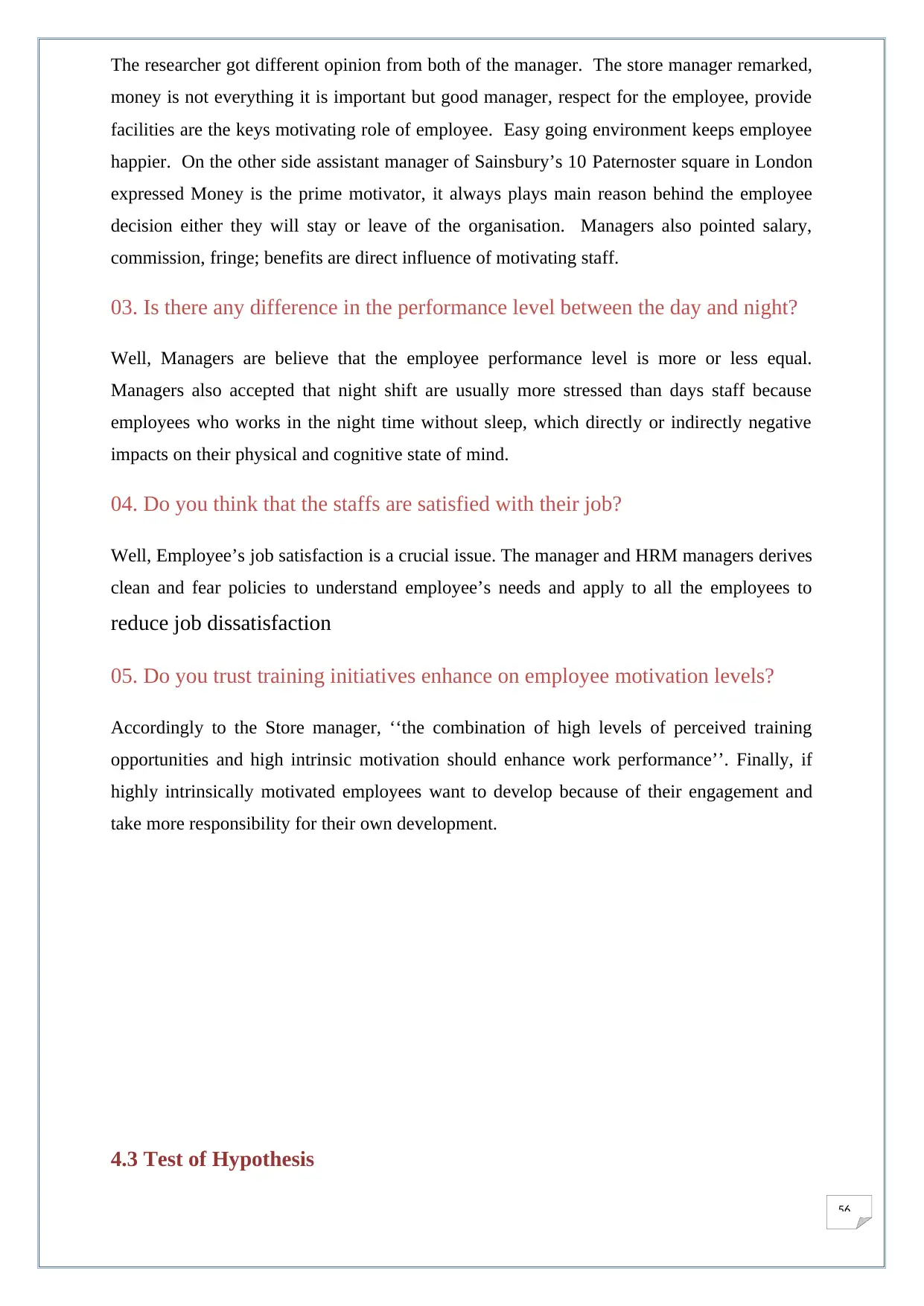
56
The researcher got different opinion from both of the manager. The store manager remarked,
money is not everything it is important but good manager, respect for the employee, provide
facilities are the keys motivating role of employee. Easy going environment keeps employee
happier. On the other side assistant manager of Sainsbury’s 10 Paternoster square in London
expressed Money is the prime motivator, it always plays main reason behind the employee
decision either they will stay or leave of the organisation. Managers also pointed salary,
commission, fringe; benefits are direct influence of motivating staff.
03. Is there any difference in the performance level between the day and night?
Well, Managers are believe that the employee performance level is more or less equal.
Managers also accepted that night shift are usually more stressed than days staff because
employees who works in the night time without sleep, which directly or indirectly negative
impacts on their physical and cognitive state of mind.
04. Do you think that the staffs are satisfied with their job?
Well, Employee’s job satisfaction is a crucial issue. The manager and HRM managers derives
clean and fear policies to understand employee’s needs and apply to all the employees to
reduce job dissatisfaction
05. Do you trust training initiatives enhance on employee motivation levels?
Accordingly to the Store manager, ‘‘the combination of high levels of perceived training
opportunities and high intrinsic motivation should enhance work performance’’. Finally, if
highly intrinsically motivated employees want to develop because of their engagement and
take more responsibility for their own development.
4.3 Test of Hypothesis
The researcher got different opinion from both of the manager. The store manager remarked,
money is not everything it is important but good manager, respect for the employee, provide
facilities are the keys motivating role of employee. Easy going environment keeps employee
happier. On the other side assistant manager of Sainsbury’s 10 Paternoster square in London
expressed Money is the prime motivator, it always plays main reason behind the employee
decision either they will stay or leave of the organisation. Managers also pointed salary,
commission, fringe; benefits are direct influence of motivating staff.
03. Is there any difference in the performance level between the day and night?
Well, Managers are believe that the employee performance level is more or less equal.
Managers also accepted that night shift are usually more stressed than days staff because
employees who works in the night time without sleep, which directly or indirectly negative
impacts on their physical and cognitive state of mind.
04. Do you think that the staffs are satisfied with their job?
Well, Employee’s job satisfaction is a crucial issue. The manager and HRM managers derives
clean and fear policies to understand employee’s needs and apply to all the employees to
reduce job dissatisfaction
05. Do you trust training initiatives enhance on employee motivation levels?
Accordingly to the Store manager, ‘‘the combination of high levels of perceived training
opportunities and high intrinsic motivation should enhance work performance’’. Finally, if
highly intrinsically motivated employees want to develop because of their engagement and
take more responsibility for their own development.
4.3 Test of Hypothesis
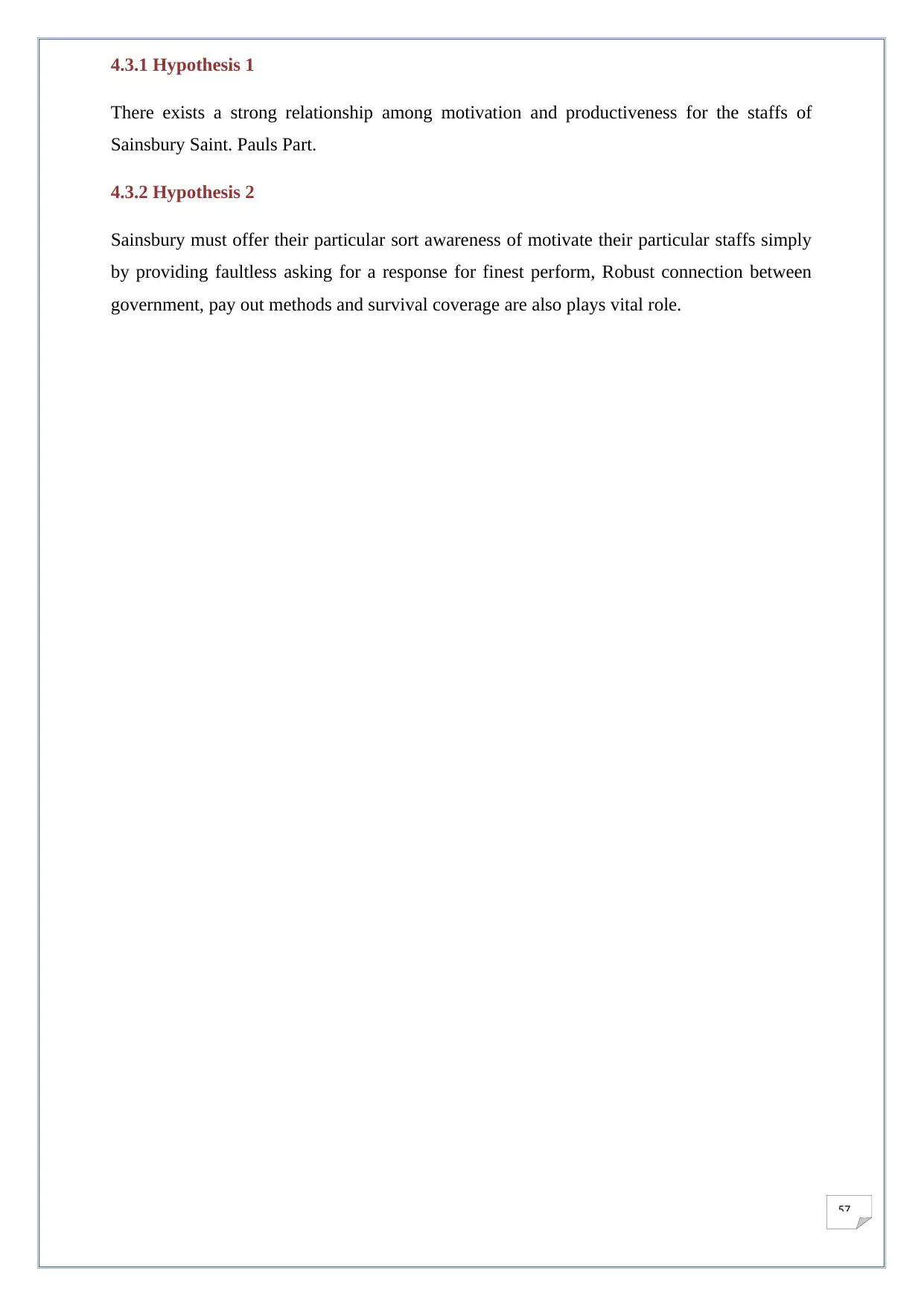
57
4.3.1 Hypothesis 1
There exists a strong relationship among motivation and productiveness for the staffs of
Sainsbury Saint. Pauls Part.
4.3.2 Hypothesis 2
Sainsbury must offer their particular sort awareness of motivate their particular staffs simply
by providing faultless asking for a response for finest perform, Robust connection between
government, pay out methods and survival coverage are also plays vital role.
4.3.1 Hypothesis 1
There exists a strong relationship among motivation and productiveness for the staffs of
Sainsbury Saint. Pauls Part.
4.3.2 Hypothesis 2
Sainsbury must offer their particular sort awareness of motivate their particular staffs simply
by providing faultless asking for a response for finest perform, Robust connection between
government, pay out methods and survival coverage are also plays vital role.
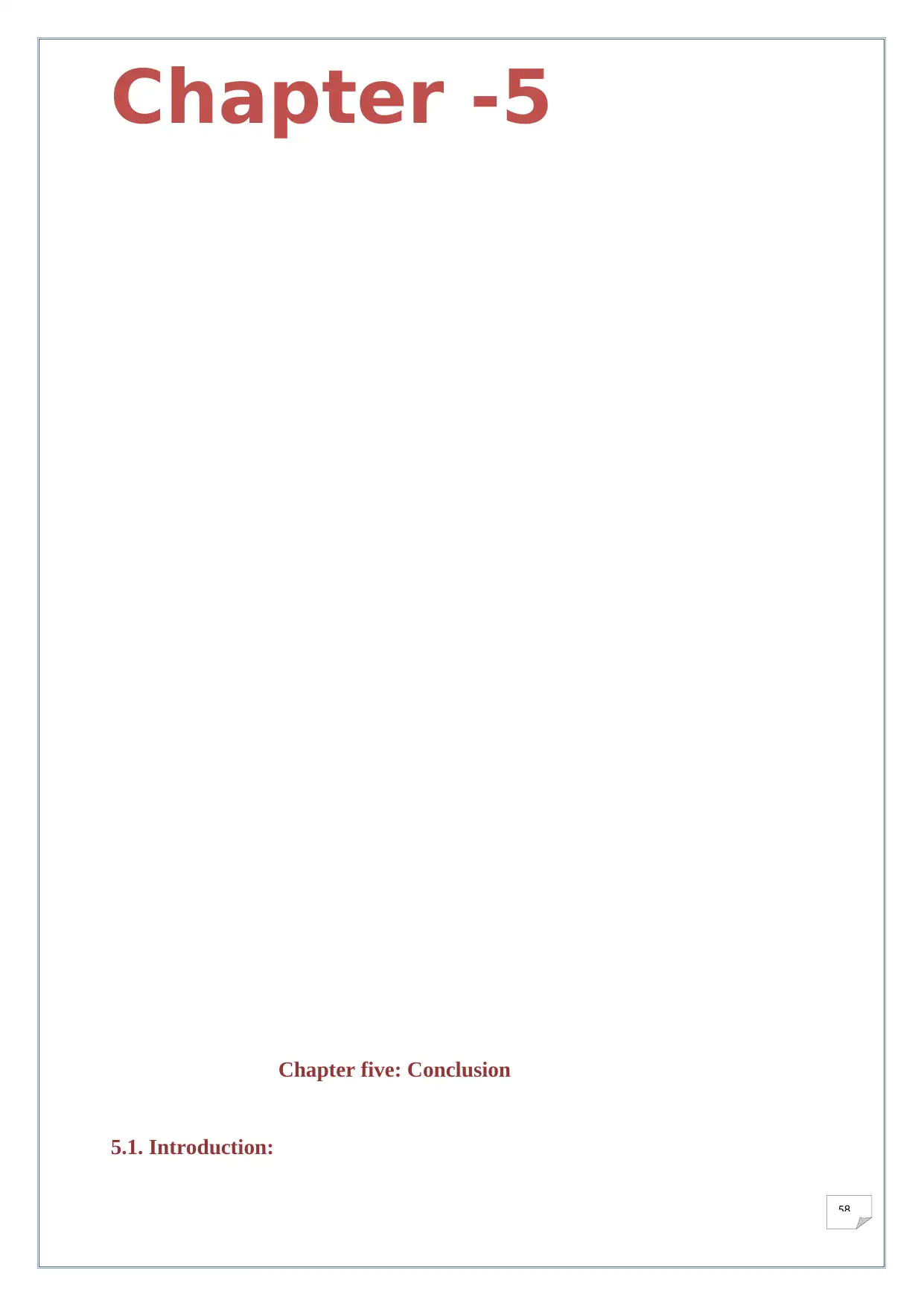
58
Chapter -5
Chapter five: Conclusion
5.1. Introduction:
Chapter -5
Chapter five: Conclusion
5.1. Introduction:
Secure Best Marks with AI Grader
Need help grading? Try our AI Grader for instant feedback on your assignments.
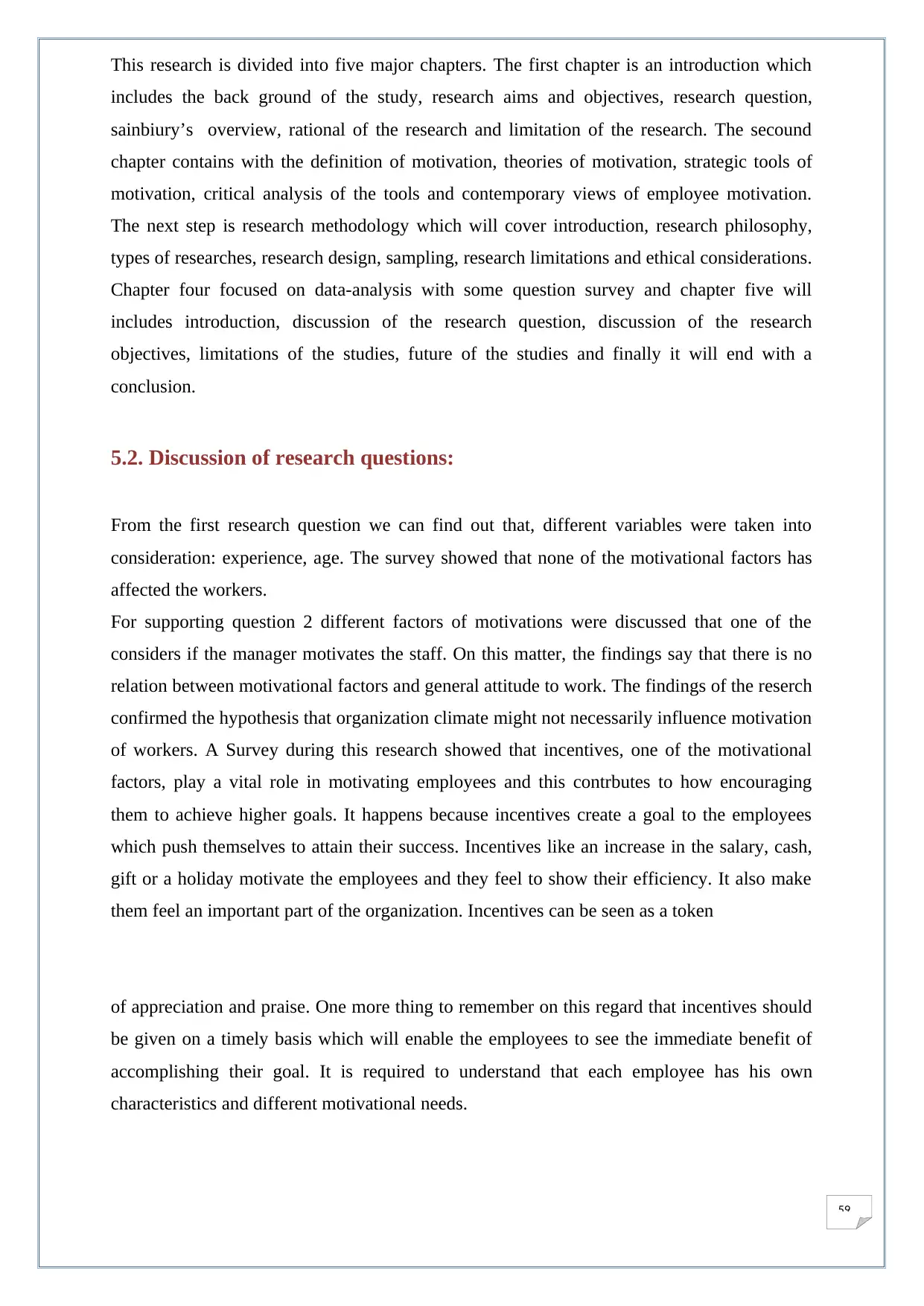
59
This research is divided into five major chapters. The first chapter is an introduction which
includes the back ground of the study, research aims and objectives, research question,
sainbiury’s overview, rational of the research and limitation of the research. The secound
chapter contains with the definition of motivation, theories of motivation, strategic tools of
motivation, critical analysis of the tools and contemporary views of employee motivation.
The next step is research methodology which will cover introduction, research philosophy,
types of researches, research design, sampling, research limitations and ethical considerations.
Chapter four focused on data-analysis with some question survey and chapter five will
includes introduction, discussion of the research question, discussion of the research
objectives, limitations of the studies, future of the studies and finally it will end with a
conclusion.
5.2. Discussion of research questions:
From the first research question we can find out that, different variables were taken into
consideration: experience, age. The survey showed that none of the motivational factors has
affected the workers.
For supporting question 2 different factors of motivations were discussed that one of the
considers if the manager motivates the staff. On this matter, the findings say that there is no
relation between motivational factors and general attitude to work. The findings of the reserch
confirmed the hypothesis that organization climate might not necessarily influence motivation
of workers. A Survey during this research showed that incentives, one of the motivational
factors, play a vital role in motivating employees and this contrbutes to how encouraging
them to achieve higher goals. It happens because incentives create a goal to the employees
which push themselves to attain their success. Incentives like an increase in the salary, cash,
gift or a holiday motivate the employees and they feel to show their efficiency. It also make
them feel an important part of the organization. Incentives can be seen as a token
of appreciation and praise. One more thing to remember on this regard that incentives should
be given on a timely basis which will enable the employees to see the immediate benefit of
accomplishing their goal. It is required to understand that each employee has his own
characteristics and different motivational needs.
This research is divided into five major chapters. The first chapter is an introduction which
includes the back ground of the study, research aims and objectives, research question,
sainbiury’s overview, rational of the research and limitation of the research. The secound
chapter contains with the definition of motivation, theories of motivation, strategic tools of
motivation, critical analysis of the tools and contemporary views of employee motivation.
The next step is research methodology which will cover introduction, research philosophy,
types of researches, research design, sampling, research limitations and ethical considerations.
Chapter four focused on data-analysis with some question survey and chapter five will
includes introduction, discussion of the research question, discussion of the research
objectives, limitations of the studies, future of the studies and finally it will end with a
conclusion.
5.2. Discussion of research questions:
From the first research question we can find out that, different variables were taken into
consideration: experience, age. The survey showed that none of the motivational factors has
affected the workers.
For supporting question 2 different factors of motivations were discussed that one of the
considers if the manager motivates the staff. On this matter, the findings say that there is no
relation between motivational factors and general attitude to work. The findings of the reserch
confirmed the hypothesis that organization climate might not necessarily influence motivation
of workers. A Survey during this research showed that incentives, one of the motivational
factors, play a vital role in motivating employees and this contrbutes to how encouraging
them to achieve higher goals. It happens because incentives create a goal to the employees
which push themselves to attain their success. Incentives like an increase in the salary, cash,
gift or a holiday motivate the employees and they feel to show their efficiency. It also make
them feel an important part of the organization. Incentives can be seen as a token
of appreciation and praise. One more thing to remember on this regard that incentives should
be given on a timely basis which will enable the employees to see the immediate benefit of
accomplishing their goal. It is required to understand that each employee has his own
characteristics and different motivational needs.
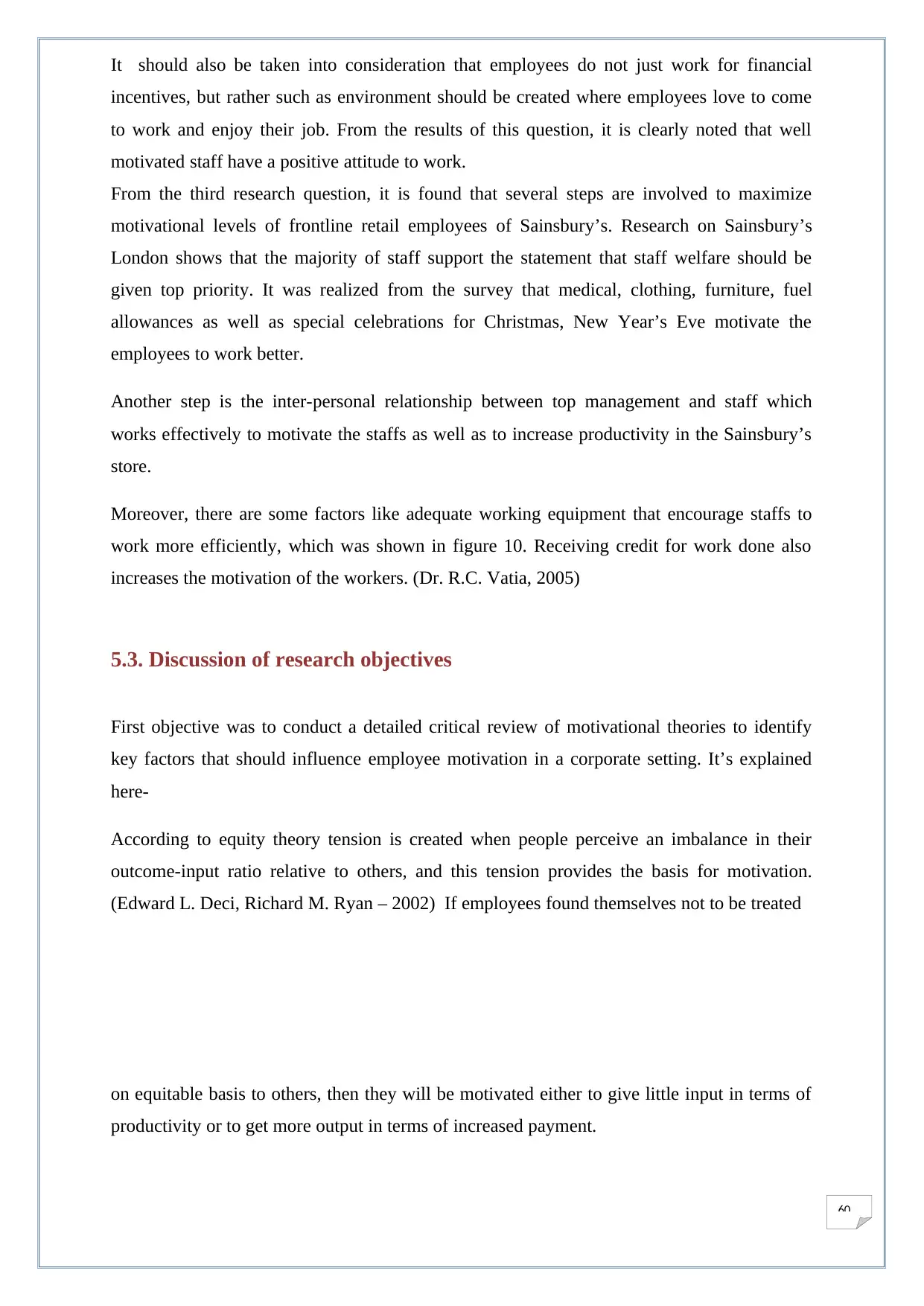
60
It should also be taken into consideration that employees do not just work for financial
incentives, but rather such as environment should be created where employees love to come
to work and enjoy their job. From the results of this question, it is clearly noted that well
motivated staff have a positive attitude to work.
From the third research question, it is found that several steps are involved to maximize
motivational levels of frontline retail employees of Sainsbury’s. Research on Sainsbury’s
London shows that the majority of staff support the statement that staff welfare should be
given top priority. It was realized from the survey that medical, clothing, furniture, fuel
allowances as well as special celebrations for Christmas, New Year’s Eve motivate the
employees to work better.
Another step is the inter-personal relationship between top management and staff which
works effectively to motivate the staffs as well as to increase productivity in the Sainsbury’s
store.
Moreover, there are some factors like adequate working equipment that encourage staffs to
work more efficiently, which was shown in figure 10. Receiving credit for work done also
increases the motivation of the workers. (Dr. R.C. Vatia, 2005)
5.3. Discussion of research objectives
First objective was to conduct a detailed critical review of motivational theories to identify
key factors that should influence employee motivation in a corporate setting. It’s explained
here-
According to equity theory tension is created when people perceive an imbalance in their
outcome-input ratio relative to others, and this tension provides the basis for motivation.
(Edward L. Deci, Richard M. Ryan – 2002) If employees found themselves not to be treated
on equitable basis to others, then they will be motivated either to give little input in terms of
productivity or to get more output in terms of increased payment.
It should also be taken into consideration that employees do not just work for financial
incentives, but rather such as environment should be created where employees love to come
to work and enjoy their job. From the results of this question, it is clearly noted that well
motivated staff have a positive attitude to work.
From the third research question, it is found that several steps are involved to maximize
motivational levels of frontline retail employees of Sainsbury’s. Research on Sainsbury’s
London shows that the majority of staff support the statement that staff welfare should be
given top priority. It was realized from the survey that medical, clothing, furniture, fuel
allowances as well as special celebrations for Christmas, New Year’s Eve motivate the
employees to work better.
Another step is the inter-personal relationship between top management and staff which
works effectively to motivate the staffs as well as to increase productivity in the Sainsbury’s
store.
Moreover, there are some factors like adequate working equipment that encourage staffs to
work more efficiently, which was shown in figure 10. Receiving credit for work done also
increases the motivation of the workers. (Dr. R.C. Vatia, 2005)
5.3. Discussion of research objectives
First objective was to conduct a detailed critical review of motivational theories to identify
key factors that should influence employee motivation in a corporate setting. It’s explained
here-
According to equity theory tension is created when people perceive an imbalance in their
outcome-input ratio relative to others, and this tension provides the basis for motivation.
(Edward L. Deci, Richard M. Ryan – 2002) If employees found themselves not to be treated
on equitable basis to others, then they will be motivated either to give little input in terms of
productivity or to get more output in terms of increased payment.
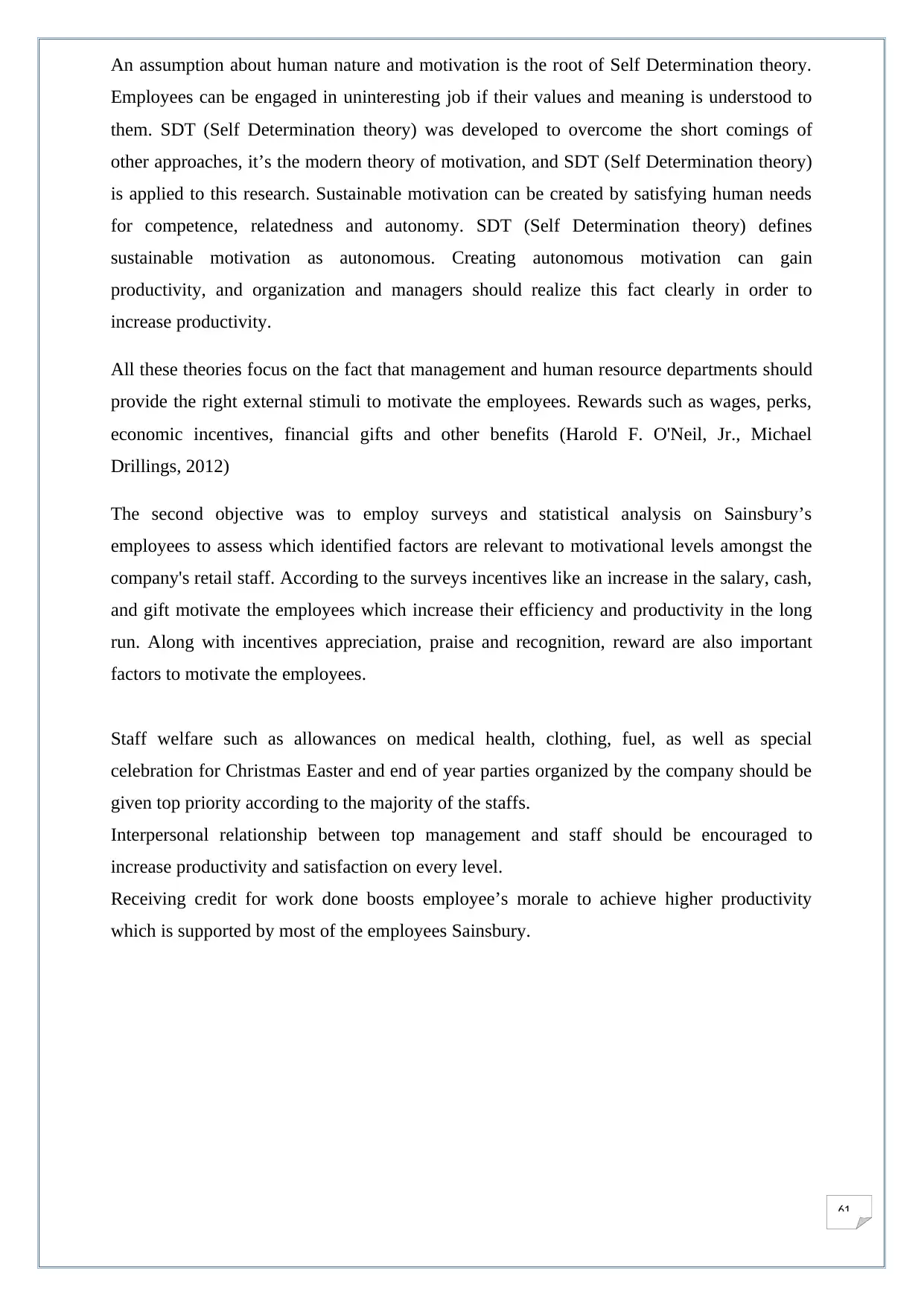
61
An assumption about human nature and motivation is the root of Self Determination theory.
Employees can be engaged in uninteresting job if their values and meaning is understood to
them. SDT (Self Determination theory) was developed to overcome the short comings of
other approaches, it’s the modern theory of motivation, and SDT (Self Determination theory)
is applied to this research. Sustainable motivation can be created by satisfying human needs
for competence, relatedness and autonomy. SDT (Self Determination theory) defines
sustainable motivation as autonomous. Creating autonomous motivation can gain
productivity, and organization and managers should realize this fact clearly in order to
increase productivity.
All these theories focus on the fact that management and human resource departments should
provide the right external stimuli to motivate the employees. Rewards such as wages, perks,
economic incentives, financial gifts and other benefits (Harold F. O'Neil, Jr., Michael
Drillings, 2012)
The second objective was to employ surveys and statistical analysis on Sainsbury’s
employees to assess which identified factors are relevant to motivational levels amongst the
company's retail staff. According to the surveys incentives like an increase in the salary, cash,
and gift motivate the employees which increase their efficiency and productivity in the long
run. Along with incentives appreciation, praise and recognition, reward are also important
factors to motivate the employees.
Staff welfare such as allowances on medical health, clothing, fuel, as well as special
celebration for Christmas Easter and end of year parties organized by the company should be
given top priority according to the majority of the staffs.
Interpersonal relationship between top management and staff should be encouraged to
increase productivity and satisfaction on every level.
Receiving credit for work done boosts employee’s morale to achieve higher productivity
which is supported by most of the employees Sainsbury.
An assumption about human nature and motivation is the root of Self Determination theory.
Employees can be engaged in uninteresting job if their values and meaning is understood to
them. SDT (Self Determination theory) was developed to overcome the short comings of
other approaches, it’s the modern theory of motivation, and SDT (Self Determination theory)
is applied to this research. Sustainable motivation can be created by satisfying human needs
for competence, relatedness and autonomy. SDT (Self Determination theory) defines
sustainable motivation as autonomous. Creating autonomous motivation can gain
productivity, and organization and managers should realize this fact clearly in order to
increase productivity.
All these theories focus on the fact that management and human resource departments should
provide the right external stimuli to motivate the employees. Rewards such as wages, perks,
economic incentives, financial gifts and other benefits (Harold F. O'Neil, Jr., Michael
Drillings, 2012)
The second objective was to employ surveys and statistical analysis on Sainsbury’s
employees to assess which identified factors are relevant to motivational levels amongst the
company's retail staff. According to the surveys incentives like an increase in the salary, cash,
and gift motivate the employees which increase their efficiency and productivity in the long
run. Along with incentives appreciation, praise and recognition, reward are also important
factors to motivate the employees.
Staff welfare such as allowances on medical health, clothing, fuel, as well as special
celebration for Christmas Easter and end of year parties organized by the company should be
given top priority according to the majority of the staffs.
Interpersonal relationship between top management and staff should be encouraged to
increase productivity and satisfaction on every level.
Receiving credit for work done boosts employee’s morale to achieve higher productivity
which is supported by most of the employees Sainsbury.
Paraphrase This Document
Need a fresh take? Get an instant paraphrase of this document with our AI Paraphraser
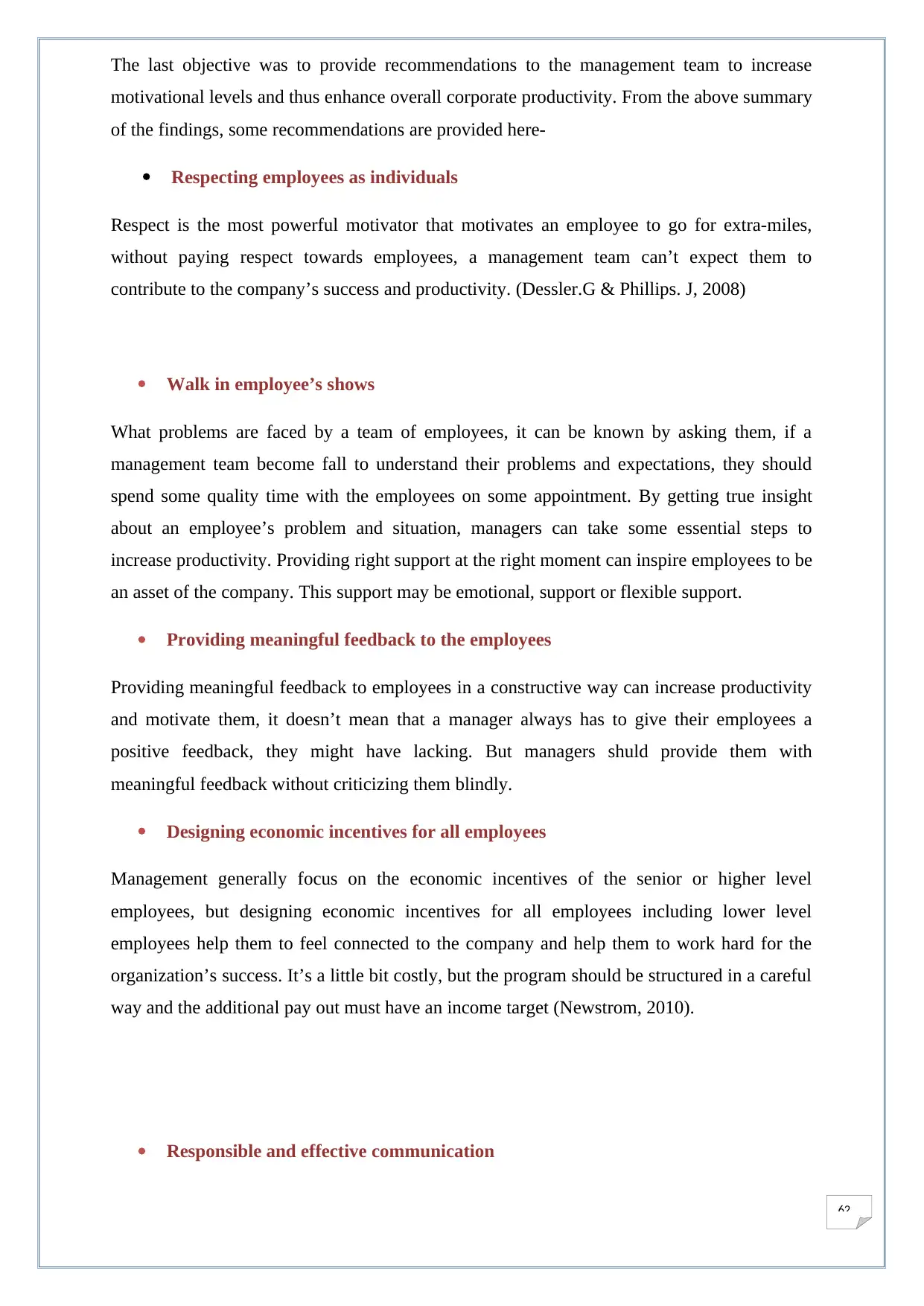
62
The last objective was to provide recommendations to the management team to increase
motivational levels and thus enhance overall corporate productivity. From the above summary
of the findings, some recommendations are provided here-
Respecting employees as individuals
Respect is the most powerful motivator that motivates an employee to go for extra-miles,
without paying respect towards employees, a management team can’t expect them to
contribute to the company’s success and productivity. (Dessler.G & Phillips. J, 2008)
Walk in employee’s shows
What problems are faced by a team of employees, it can be known by asking them, if a
management team become fall to understand their problems and expectations, they should
spend some quality time with the employees on some appointment. By getting true insight
about an employee’s problem and situation, managers can take some essential steps to
increase productivity. Providing right support at the right moment can inspire employees to be
an asset of the company. This support may be emotional, support or flexible support.
Providing meaningful feedback to the employees
Providing meaningful feedback to employees in a constructive way can increase productivity
and motivate them, it doesn’t mean that a manager always has to give their employees a
positive feedback, they might have lacking. But managers shuld provide them with
meaningful feedback without criticizing them blindly.
Designing economic incentives for all employees
Management generally focus on the economic incentives of the senior or higher level
employees, but designing economic incentives for all employees including lower level
employees help them to feel connected to the company and help them to work hard for the
organization’s success. It’s a little bit costly, but the program should be structured in a careful
way and the additional pay out must have an income target (Newstrom, 2010).
Responsible and effective communication
The last objective was to provide recommendations to the management team to increase
motivational levels and thus enhance overall corporate productivity. From the above summary
of the findings, some recommendations are provided here-
Respecting employees as individuals
Respect is the most powerful motivator that motivates an employee to go for extra-miles,
without paying respect towards employees, a management team can’t expect them to
contribute to the company’s success and productivity. (Dessler.G & Phillips. J, 2008)
Walk in employee’s shows
What problems are faced by a team of employees, it can be known by asking them, if a
management team become fall to understand their problems and expectations, they should
spend some quality time with the employees on some appointment. By getting true insight
about an employee’s problem and situation, managers can take some essential steps to
increase productivity. Providing right support at the right moment can inspire employees to be
an asset of the company. This support may be emotional, support or flexible support.
Providing meaningful feedback to the employees
Providing meaningful feedback to employees in a constructive way can increase productivity
and motivate them, it doesn’t mean that a manager always has to give their employees a
positive feedback, they might have lacking. But managers shuld provide them with
meaningful feedback without criticizing them blindly.
Designing economic incentives for all employees
Management generally focus on the economic incentives of the senior or higher level
employees, but designing economic incentives for all employees including lower level
employees help them to feel connected to the company and help them to work hard for the
organization’s success. It’s a little bit costly, but the program should be structured in a careful
way and the additional pay out must have an income target (Newstrom, 2010).
Responsible and effective communication
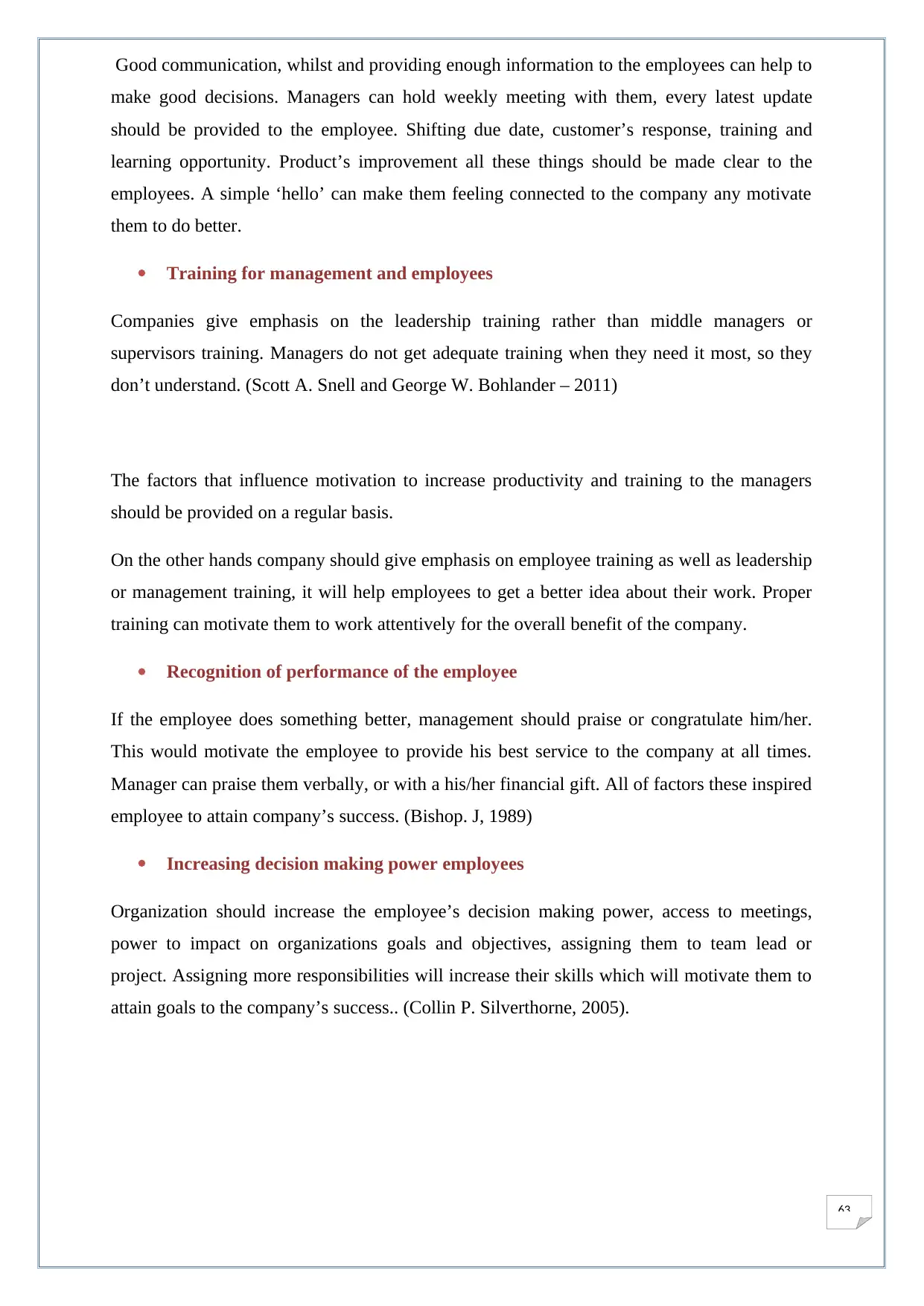
63
Good communication, whilst and providing enough information to the employees can help to
make good decisions. Managers can hold weekly meeting with them, every latest update
should be provided to the employee. Shifting due date, customer’s response, training and
learning opportunity. Product’s improvement all these things should be made clear to the
employees. A simple ‘hello’ can make them feeling connected to the company any motivate
them to do better.
Training for management and employees
Companies give emphasis on the leadership training rather than middle managers or
supervisors training. Managers do not get adequate training when they need it most, so they
don’t understand. (Scott A. Snell and George W. Bohlander – 2011)
The factors that influence motivation to increase productivity and training to the managers
should be provided on a regular basis.
On the other hands company should give emphasis on employee training as well as leadership
or management training, it will help employees to get a better idea about their work. Proper
training can motivate them to work attentively for the overall benefit of the company.
Recognition of performance of the employee
If the employee does something better, management should praise or congratulate him/her.
This would motivate the employee to provide his best service to the company at all times.
Manager can praise them verbally, or with a his/her financial gift. All of factors these inspired
employee to attain company’s success. (Bishop. J, 1989)
Increasing decision making power employees
Organization should increase the employee’s decision making power, access to meetings,
power to impact on organizations goals and objectives, assigning them to team lead or
project. Assigning more responsibilities will increase their skills which will motivate them to
attain goals to the company’s success.. (Collin P. Silverthorne, 2005).
Good communication, whilst and providing enough information to the employees can help to
make good decisions. Managers can hold weekly meeting with them, every latest update
should be provided to the employee. Shifting due date, customer’s response, training and
learning opportunity. Product’s improvement all these things should be made clear to the
employees. A simple ‘hello’ can make them feeling connected to the company any motivate
them to do better.
Training for management and employees
Companies give emphasis on the leadership training rather than middle managers or
supervisors training. Managers do not get adequate training when they need it most, so they
don’t understand. (Scott A. Snell and George W. Bohlander – 2011)
The factors that influence motivation to increase productivity and training to the managers
should be provided on a regular basis.
On the other hands company should give emphasis on employee training as well as leadership
or management training, it will help employees to get a better idea about their work. Proper
training can motivate them to work attentively for the overall benefit of the company.
Recognition of performance of the employee
If the employee does something better, management should praise or congratulate him/her.
This would motivate the employee to provide his best service to the company at all times.
Manager can praise them verbally, or with a his/her financial gift. All of factors these inspired
employee to attain company’s success. (Bishop. J, 1989)
Increasing decision making power employees
Organization should increase the employee’s decision making power, access to meetings,
power to impact on organizations goals and objectives, assigning them to team lead or
project. Assigning more responsibilities will increase their skills which will motivate them to
attain goals to the company’s success.. (Collin P. Silverthorne, 2005).
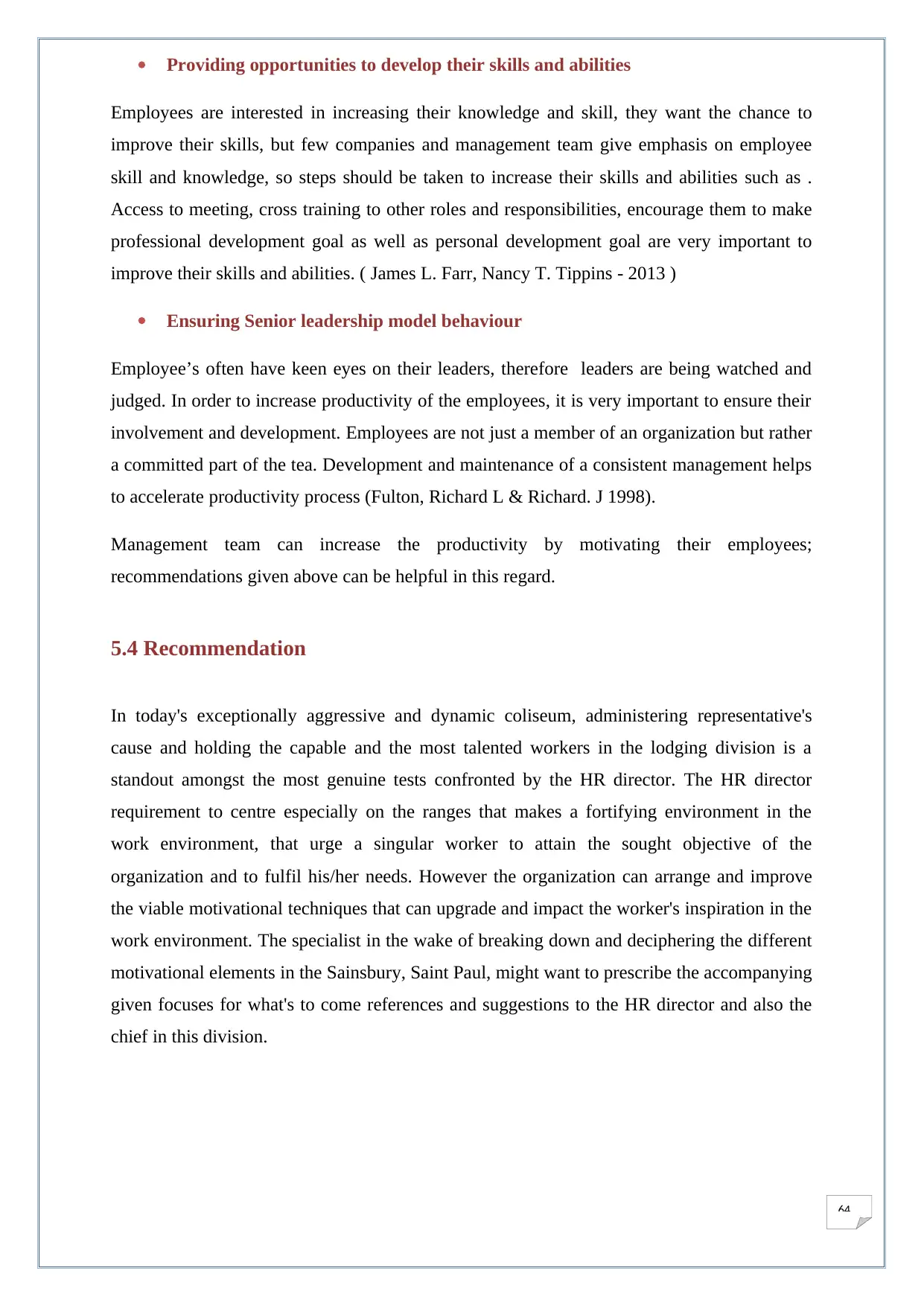
64
Providing opportunities to develop their skills and abilities
Employees are interested in increasing their knowledge and skill, they want the chance to
improve their skills, but few companies and management team give emphasis on employee
skill and knowledge, so steps should be taken to increase their skills and abilities such as .
Access to meeting, cross training to other roles and responsibilities, encourage them to make
professional development goal as well as personal development goal are very important to
improve their skills and abilities. ( James L. Farr, Nancy T. Tippins - 2013 )
Ensuring Senior leadership model behaviour
Employee’s often have keen eyes on their leaders, therefore leaders are being watched and
judged. In order to increase productivity of the employees, it is very important to ensure their
involvement and development. Employees are not just a member of an organization but rather
a committed part of the tea. Development and maintenance of a consistent management helps
to accelerate productivity process (Fulton, Richard L & Richard. J 1998).
Management team can increase the productivity by motivating their employees;
recommendations given above can be helpful in this regard.
5.4 Recommendation
In today's exceptionally aggressive and dynamic coliseum, administering representative's
cause and holding the capable and the most talented workers in the lodging division is a
standout amongst the most genuine tests confronted by the HR director. The HR director
requirement to centre especially on the ranges that makes a fortifying environment in the
work environment, that urge a singular worker to attain the sought objective of the
organization and to fulfil his/her needs. However the organization can arrange and improve
the viable motivational techniques that can upgrade and impact the worker's inspiration in the
work environment. The specialist in the wake of breaking down and deciphering the different
motivational elements in the Sainsbury, Saint Paul, might want to prescribe the accompanying
given focuses for what's to come references and suggestions to the HR director and also the
chief in this division.
Providing opportunities to develop their skills and abilities
Employees are interested in increasing their knowledge and skill, they want the chance to
improve their skills, but few companies and management team give emphasis on employee
skill and knowledge, so steps should be taken to increase their skills and abilities such as .
Access to meeting, cross training to other roles and responsibilities, encourage them to make
professional development goal as well as personal development goal are very important to
improve their skills and abilities. ( James L. Farr, Nancy T. Tippins - 2013 )
Ensuring Senior leadership model behaviour
Employee’s often have keen eyes on their leaders, therefore leaders are being watched and
judged. In order to increase productivity of the employees, it is very important to ensure their
involvement and development. Employees are not just a member of an organization but rather
a committed part of the tea. Development and maintenance of a consistent management helps
to accelerate productivity process (Fulton, Richard L & Richard. J 1998).
Management team can increase the productivity by motivating their employees;
recommendations given above can be helpful in this regard.
5.4 Recommendation
In today's exceptionally aggressive and dynamic coliseum, administering representative's
cause and holding the capable and the most talented workers in the lodging division is a
standout amongst the most genuine tests confronted by the HR director. The HR director
requirement to centre especially on the ranges that makes a fortifying environment in the
work environment, that urge a singular worker to attain the sought objective of the
organization and to fulfil his/her needs. However the organization can arrange and improve
the viable motivational techniques that can upgrade and impact the worker's inspiration in the
work environment. The specialist in the wake of breaking down and deciphering the different
motivational elements in the Sainsbury, Saint Paul, might want to prescribe the accompanying
given focuses for what's to come references and suggestions to the HR director and also the
chief in this division.
Secure Best Marks with AI Grader
Need help grading? Try our AI Grader for instant feedback on your assignments.
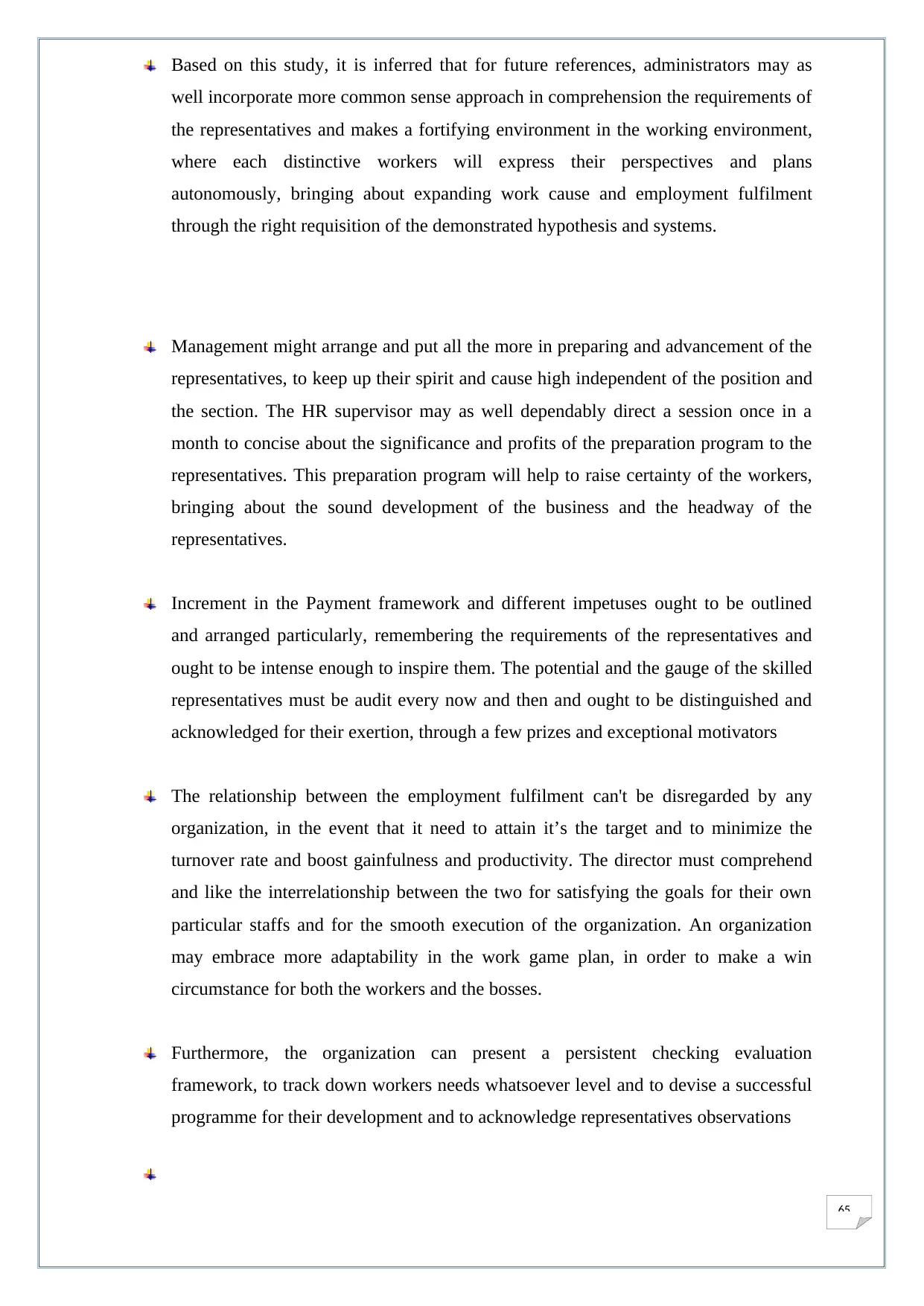
65
Based on this study, it is inferred that for future references, administrators may as
well incorporate more common sense approach in comprehension the requirements of
the representatives and makes a fortifying environment in the working environment,
where each distinctive workers will express their perspectives and plans
autonomously, bringing about expanding work cause and employment fulfilment
through the right requisition of the demonstrated hypothesis and systems.
Management might arrange and put all the more in preparing and advancement of the
representatives, to keep up their spirit and cause high independent of the position and
the section. The HR supervisor may as well dependably direct a session once in a
month to concise about the significance and profits of the preparation program to the
representatives. This preparation program will help to raise certainty of the workers,
bringing about the sound development of the business and the headway of the
representatives.
Increment in the Payment framework and different impetuses ought to be outlined
and arranged particularly, remembering the requirements of the representatives and
ought to be intense enough to inspire them. The potential and the gauge of the skilled
representatives must be audit every now and then and ought to be distinguished and
acknowledged for their exertion, through a few prizes and exceptional motivators
The relationship between the employment fulfilment can't be disregarded by any
organization, in the event that it need to attain it’s the target and to minimize the
turnover rate and boost gainfulness and productivity. The director must comprehend
and like the interrelationship between the two for satisfying the goals for their own
particular staffs and for the smooth execution of the organization. An organization
may embrace more adaptability in the work game plan, in order to make a win
circumstance for both the workers and the bosses.
Furthermore, the organization can present a persistent checking evaluation
framework, to track down workers needs whatsoever level and to devise a successful
programme for their development and to acknowledge representatives observations
Based on this study, it is inferred that for future references, administrators may as
well incorporate more common sense approach in comprehension the requirements of
the representatives and makes a fortifying environment in the working environment,
where each distinctive workers will express their perspectives and plans
autonomously, bringing about expanding work cause and employment fulfilment
through the right requisition of the demonstrated hypothesis and systems.
Management might arrange and put all the more in preparing and advancement of the
representatives, to keep up their spirit and cause high independent of the position and
the section. The HR supervisor may as well dependably direct a session once in a
month to concise about the significance and profits of the preparation program to the
representatives. This preparation program will help to raise certainty of the workers,
bringing about the sound development of the business and the headway of the
representatives.
Increment in the Payment framework and different impetuses ought to be outlined
and arranged particularly, remembering the requirements of the representatives and
ought to be intense enough to inspire them. The potential and the gauge of the skilled
representatives must be audit every now and then and ought to be distinguished and
acknowledged for their exertion, through a few prizes and exceptional motivators
The relationship between the employment fulfilment can't be disregarded by any
organization, in the event that it need to attain it’s the target and to minimize the
turnover rate and boost gainfulness and productivity. The director must comprehend
and like the interrelationship between the two for satisfying the goals for their own
particular staffs and for the smooth execution of the organization. An organization
may embrace more adaptability in the work game plan, in order to make a win
circumstance for both the workers and the bosses.
Furthermore, the organization can present a persistent checking evaluation
framework, to track down workers needs whatsoever level and to devise a successful
programme for their development and to acknowledge representatives observations
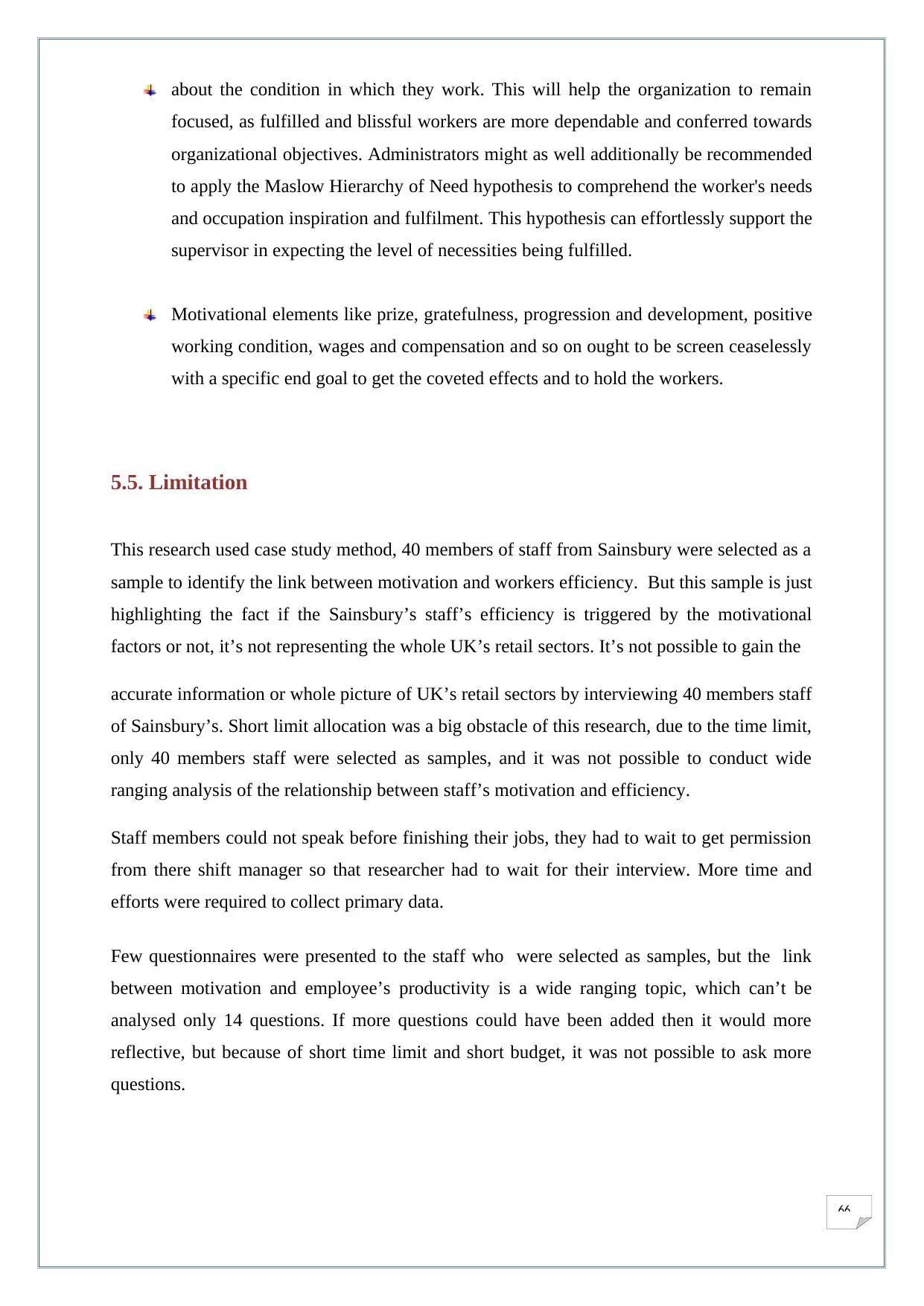
66
about the condition in which they work. This will help the organization to remain
focused, as fulfilled and blissful workers are more dependable and conferred towards
organizational objectives. Administrators might as well additionally be recommended
to apply the Maslow Hierarchy of Need hypothesis to comprehend the worker's needs
and occupation inspiration and fulfilment. This hypothesis can effortlessly support the
supervisor in expecting the level of necessities being fulfilled.
Motivational elements like prize, gratefulness, progression and development, positive
working condition, wages and compensation and so on ought to be screen ceaselessly
with a specific end goal to get the coveted effects and to hold the workers.
5.5. Limitation
This research used case study method, 40 members of staff from Sainsbury were selected as a
sample to identify the link between motivation and workers efficiency. But this sample is just
highlighting the fact if the Sainsbury’s staff’s efficiency is triggered by the motivational
factors or not, it’s not representing the whole UK’s retail sectors. It’s not possible to gain the
accurate information or whole picture of UK’s retail sectors by interviewing 40 members staff
of Sainsbury’s. Short limit allocation was a big obstacle of this research, due to the time limit,
only 40 members staff were selected as samples, and it was not possible to conduct wide
ranging analysis of the relationship between staff’s motivation and efficiency.
Staff members could not speak before finishing their jobs, they had to wait to get permission
from there shift manager so that researcher had to wait for their interview. More time and
efforts were required to collect primary data.
Few questionnaires were presented to the staff who were selected as samples, but the link
between motivation and employee’s productivity is a wide ranging topic, which can’t be
analysed only 14 questions. If more questions could have been added then it would more
reflective, but because of short time limit and short budget, it was not possible to ask more
questions.
about the condition in which they work. This will help the organization to remain
focused, as fulfilled and blissful workers are more dependable and conferred towards
organizational objectives. Administrators might as well additionally be recommended
to apply the Maslow Hierarchy of Need hypothesis to comprehend the worker's needs
and occupation inspiration and fulfilment. This hypothesis can effortlessly support the
supervisor in expecting the level of necessities being fulfilled.
Motivational elements like prize, gratefulness, progression and development, positive
working condition, wages and compensation and so on ought to be screen ceaselessly
with a specific end goal to get the coveted effects and to hold the workers.
5.5. Limitation
This research used case study method, 40 members of staff from Sainsbury were selected as a
sample to identify the link between motivation and workers efficiency. But this sample is just
highlighting the fact if the Sainsbury’s staff’s efficiency is triggered by the motivational
factors or not, it’s not representing the whole UK’s retail sectors. It’s not possible to gain the
accurate information or whole picture of UK’s retail sectors by interviewing 40 members staff
of Sainsbury’s. Short limit allocation was a big obstacle of this research, due to the time limit,
only 40 members staff were selected as samples, and it was not possible to conduct wide
ranging analysis of the relationship between staff’s motivation and efficiency.
Staff members could not speak before finishing their jobs, they had to wait to get permission
from there shift manager so that researcher had to wait for their interview. More time and
efforts were required to collect primary data.
Few questionnaires were presented to the staff who were selected as samples, but the link
between motivation and employee’s productivity is a wide ranging topic, which can’t be
analysed only 14 questions. If more questions could have been added then it would more
reflective, but because of short time limit and short budget, it was not possible to ask more
questions.
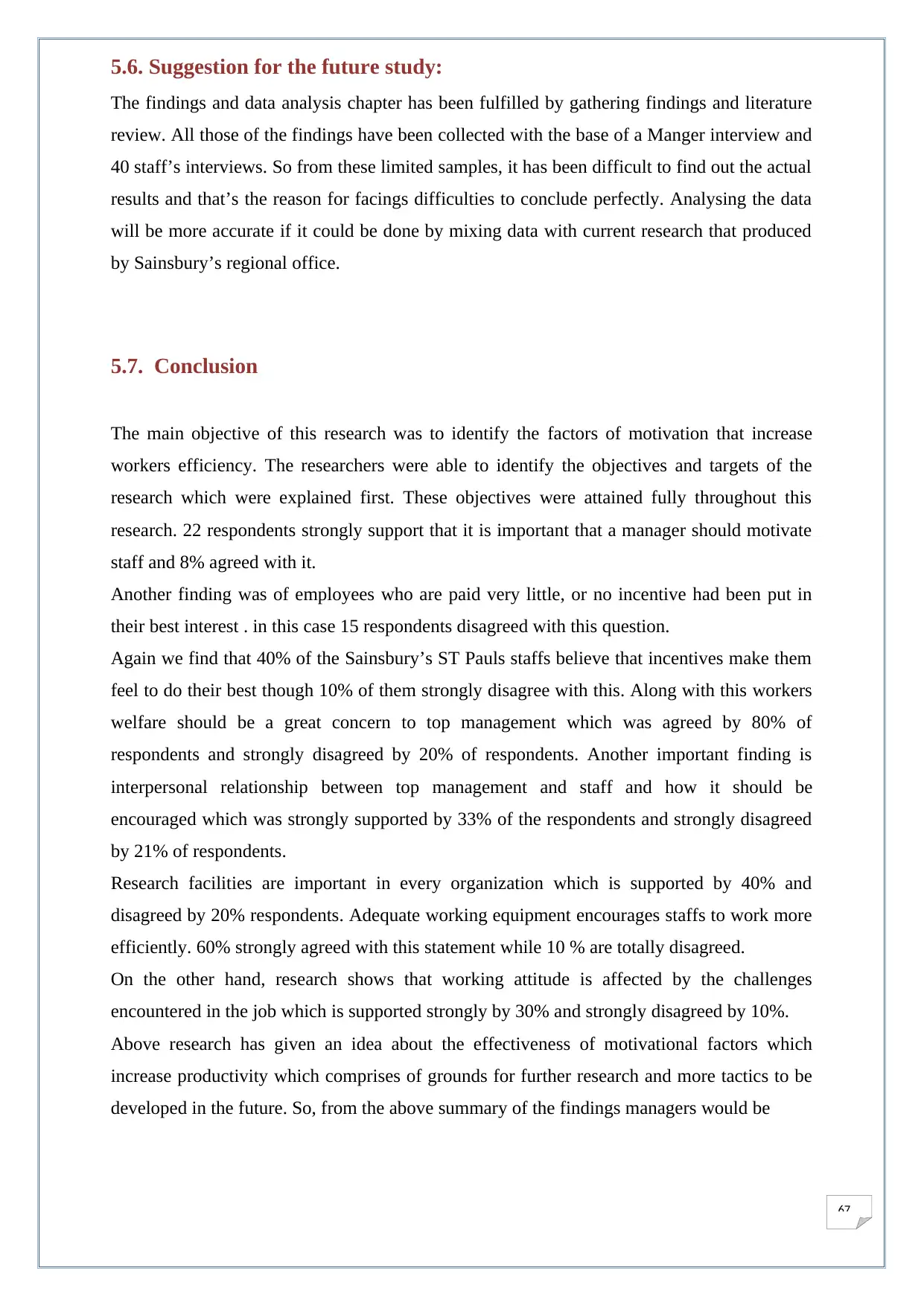
67
5.6. Suggestion for the future study:
The findings and data analysis chapter has been fulfilled by gathering findings and literature
review. All those of the findings have been collected with the base of a Manger interview and
40 staff’s interviews. So from these limited samples, it has been difficult to find out the actual
results and that’s the reason for facings difficulties to conclude perfectly. Analysing the data
will be more accurate if it could be done by mixing data with current research that produced
by Sainsbury’s regional office.
5.7. Conclusion
The main objective of this research was to identify the factors of motivation that increase
workers efficiency. The researchers were able to identify the objectives and targets of the
research which were explained first. These objectives were attained fully throughout this
research. 22 respondents strongly support that it is important that a manager should motivate
staff and 8% agreed with it.
Another finding was of employees who are paid very little, or no incentive had been put in
their best interest . in this case 15 respondents disagreed with this question.
Again we find that 40% of the Sainsbury’s ST Pauls staffs believe that incentives make them
feel to do their best though 10% of them strongly disagree with this. Along with this workers
welfare should be a great concern to top management which was agreed by 80% of
respondents and strongly disagreed by 20% of respondents. Another important finding is
interpersonal relationship between top management and staff and how it should be
encouraged which was strongly supported by 33% of the respondents and strongly disagreed
by 21% of respondents.
Research facilities are important in every organization which is supported by 40% and
disagreed by 20% respondents. Adequate working equipment encourages staffs to work more
efficiently. 60% strongly agreed with this statement while 10 % are totally disagreed.
On the other hand, research shows that working attitude is affected by the challenges
encountered in the job which is supported strongly by 30% and strongly disagreed by 10%.
Above research has given an idea about the effectiveness of motivational factors which
increase productivity which comprises of grounds for further research and more tactics to be
developed in the future. So, from the above summary of the findings managers would be
5.6. Suggestion for the future study:
The findings and data analysis chapter has been fulfilled by gathering findings and literature
review. All those of the findings have been collected with the base of a Manger interview and
40 staff’s interviews. So from these limited samples, it has been difficult to find out the actual
results and that’s the reason for facings difficulties to conclude perfectly. Analysing the data
will be more accurate if it could be done by mixing data with current research that produced
by Sainsbury’s regional office.
5.7. Conclusion
The main objective of this research was to identify the factors of motivation that increase
workers efficiency. The researchers were able to identify the objectives and targets of the
research which were explained first. These objectives were attained fully throughout this
research. 22 respondents strongly support that it is important that a manager should motivate
staff and 8% agreed with it.
Another finding was of employees who are paid very little, or no incentive had been put in
their best interest . in this case 15 respondents disagreed with this question.
Again we find that 40% of the Sainsbury’s ST Pauls staffs believe that incentives make them
feel to do their best though 10% of them strongly disagree with this. Along with this workers
welfare should be a great concern to top management which was agreed by 80% of
respondents and strongly disagreed by 20% of respondents. Another important finding is
interpersonal relationship between top management and staff and how it should be
encouraged which was strongly supported by 33% of the respondents and strongly disagreed
by 21% of respondents.
Research facilities are important in every organization which is supported by 40% and
disagreed by 20% respondents. Adequate working equipment encourages staffs to work more
efficiently. 60% strongly agreed with this statement while 10 % are totally disagreed.
On the other hand, research shows that working attitude is affected by the challenges
encountered in the job which is supported strongly by 30% and strongly disagreed by 10%.
Above research has given an idea about the effectiveness of motivational factors which
increase productivity which comprises of grounds for further research and more tactics to be
developed in the future. So, from the above summary of the findings managers would be
Paraphrase This Document
Need a fresh take? Get an instant paraphrase of this document with our AI Paraphraser
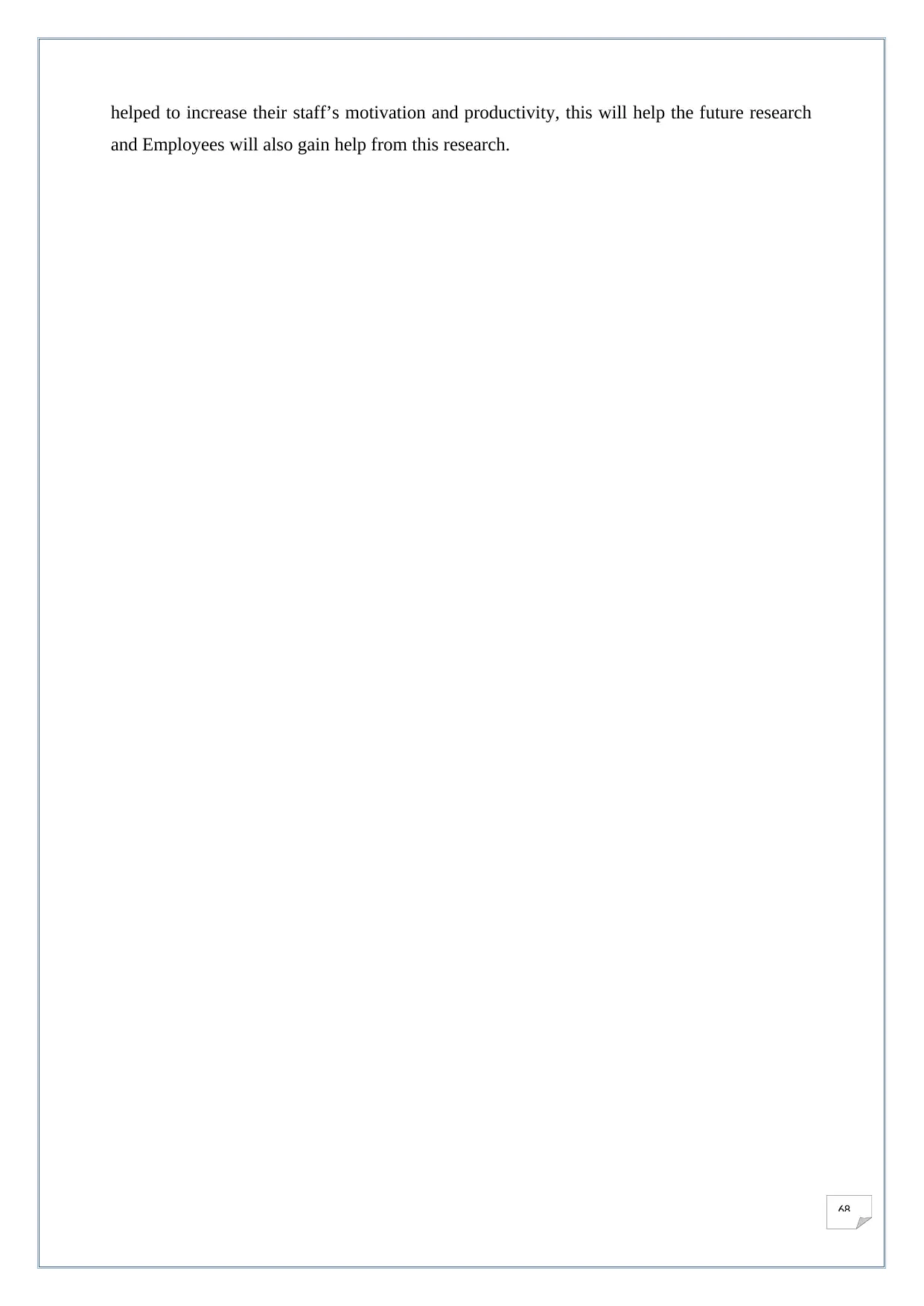
68
helped to increase their staff’s motivation and productivity, this will help the future research
and Employees will also gain help from this research.
helped to increase their staff’s motivation and productivity, this will help the future research
and Employees will also gain help from this research.

69
References
Armstrong, M., 2009. Armstrong's Handbook of Human Resource Management Practice. 11th
ed. London:
Allen, D. G. 2001, Family- support work environment: The role of organizational
perceptive.journal of vocational Behaviour, 58(3), 414-435
Anderson, S.E., Caffey, B.S.,&Byerly, R.T. (2002), Formal organization initiative and
Informal Work Place Practices: Links to work- family conflict and job related outcome.
Journal of management, pp717-730
Beardwella & Claydom,2007. Human resource management a contemporary approach.
personal educational Ltd .5th ed. GB
Baard, P.P., Deci, E.L. & Ryan, R.M., 2004. Interinsic need satisfaction: A motivational basis
for performance and well being in two work settings. Journal of Applied Social Pyschology,
34(10), pp. 2045-2068.
Bratton, J. & Gold, J., 2000. Human Resource Management: Theory and Practice. 2nd ed.
Mahwah, NJ: Lawrence Erlbaum.
Babble, E 2010. The practice of Social Research.12th ed. USA
Blattberg R. C and Scott A .Neslin (1990), Sales promotion: Concepts, methods, and
Strategies. Englewood Cliffs, NJ: Prentice-Hall
Bishop, John H. (1986) The Recognition and Reward of Employee Performance, Washington,
D.C.: Dept. of Labour: Dept. of Education.
Collins, J. & Hussey, R., 2003. Business Research: A practical guide for undergraduate and
postgraduate students. 2nd ed. Basingstoke: Palgrave-Macmillian.
Cunliffe, A.L., 2008. Organisation Theory. London: SAGE Publications
Cresweell .J.W, 2009.Research Design. 3rd ed, London: sage publication, pp.145-150
BIBLIOGRAPHY Collins, J. & Hussey, R., 2003. Business Research: A practical guide for undergraduate
and postgraduate students. 2nd ed. Basingstoke: Palgrave-Macmillian.
Deci, E.L. & Ryan, R.M., 2007. Self determination theory: An approach to human motivation
and personality. [Online] Available at: http://pysch.rochester.edu/SDT/ [Accessed 12
december 2013].
References
Armstrong, M., 2009. Armstrong's Handbook of Human Resource Management Practice. 11th
ed. London:
Allen, D. G. 2001, Family- support work environment: The role of organizational
perceptive.journal of vocational Behaviour, 58(3), 414-435
Anderson, S.E., Caffey, B.S.,&Byerly, R.T. (2002), Formal organization initiative and
Informal Work Place Practices: Links to work- family conflict and job related outcome.
Journal of management, pp717-730
Beardwella & Claydom,2007. Human resource management a contemporary approach.
personal educational Ltd .5th ed. GB
Baard, P.P., Deci, E.L. & Ryan, R.M., 2004. Interinsic need satisfaction: A motivational basis
for performance and well being in two work settings. Journal of Applied Social Pyschology,
34(10), pp. 2045-2068.
Bratton, J. & Gold, J., 2000. Human Resource Management: Theory and Practice. 2nd ed.
Mahwah, NJ: Lawrence Erlbaum.
Babble, E 2010. The practice of Social Research.12th ed. USA
Blattberg R. C and Scott A .Neslin (1990), Sales promotion: Concepts, methods, and
Strategies. Englewood Cliffs, NJ: Prentice-Hall
Bishop, John H. (1986) The Recognition and Reward of Employee Performance, Washington,
D.C.: Dept. of Labour: Dept. of Education.
Collins, J. & Hussey, R., 2003. Business Research: A practical guide for undergraduate and
postgraduate students. 2nd ed. Basingstoke: Palgrave-Macmillian.
Cunliffe, A.L., 2008. Organisation Theory. London: SAGE Publications
Cresweell .J.W, 2009.Research Design. 3rd ed, London: sage publication, pp.145-150
BIBLIOGRAPHY Collins, J. & Hussey, R., 2003. Business Research: A practical guide for undergraduate
and postgraduate students. 2nd ed. Basingstoke: Palgrave-Macmillian.
Deci, E.L. & Ryan, R.M., 2007. Self determination theory: An approach to human motivation
and personality. [Online] Available at: http://pysch.rochester.edu/SDT/ [Accessed 12
december 2013].
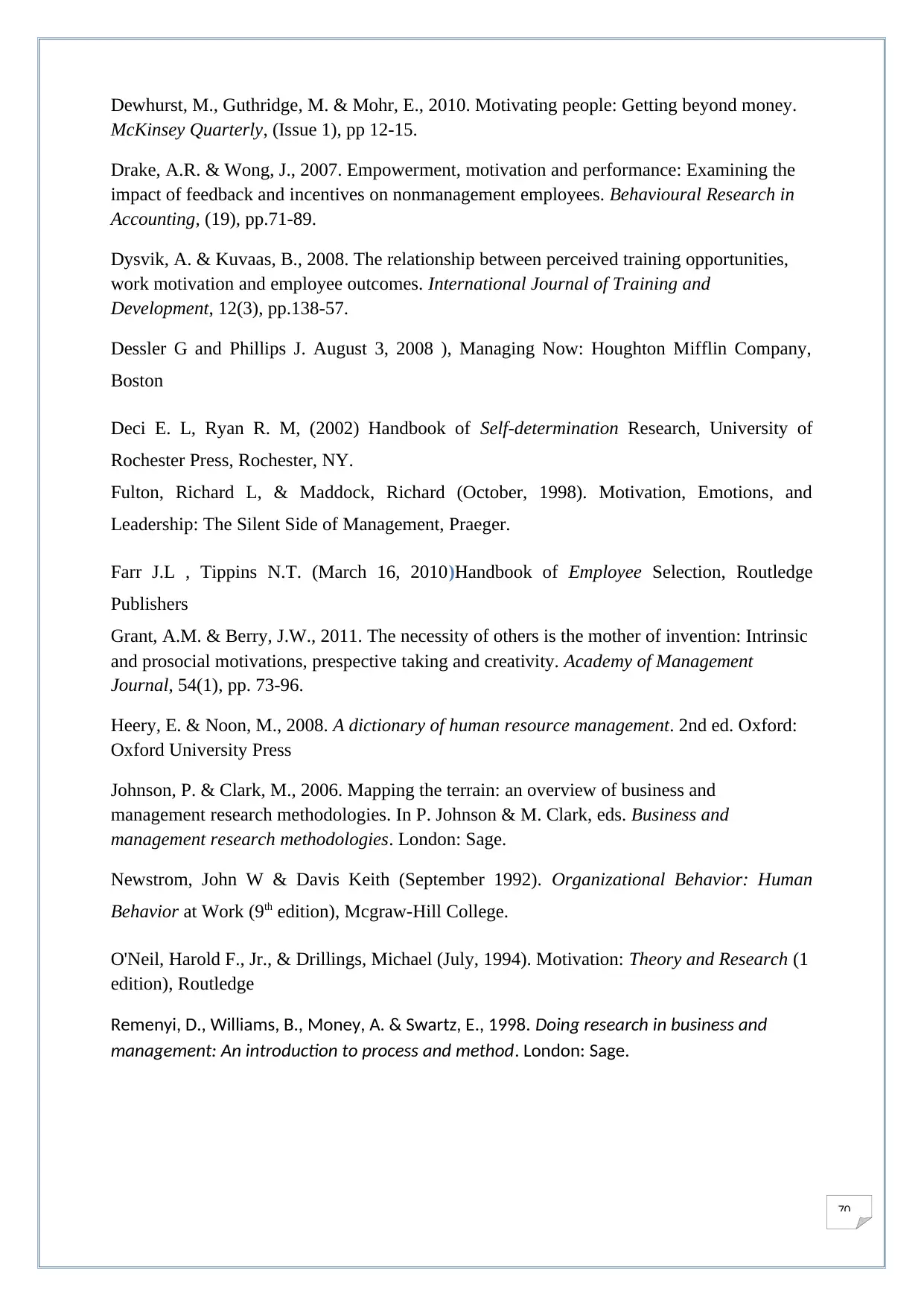
70
Dewhurst, M., Guthridge, M. & Mohr, E., 2010. Motivating people: Getting beyond money.
McKinsey Quarterly, (Issue 1), pp 12-15.
Drake, A.R. & Wong, J., 2007. Empowerment, motivation and performance: Examining the
impact of feedback and incentives on nonmanagement employees. Behavioural Research in
Accounting, (19), pp.71-89.
Dysvik, A. & Kuvaas, B., 2008. The relationship between perceived training opportunities,
work motivation and employee outcomes. International Journal of Training and
Development, 12(3), pp.138-57.
Dessler G and Phillips J. August 3, 2008 ), Managing Now: Houghton Mifflin Company,
Boston
Deci E. L, Ryan R. M, (2002) Handbook of Self-determination Research, University of
Rochester Press, Rochester, NY.
Fulton, Richard L, & Maddock, Richard (October, 1998). Motivation, Emotions, and
Leadership: The Silent Side of Management, Praeger.
Farr J.L , Tippins N.T. (March 16, 2010)Handbook of Employee Selection, Routledge
Publishers
Grant, A.M. & Berry, J.W., 2011. The necessity of others is the mother of invention: Intrinsic
and prosocial motivations, prespective taking and creativity. Academy of Management
Journal, 54(1), pp. 73-96.
Heery, E. & Noon, M., 2008. A dictionary of human resource management. 2nd ed. Oxford:
Oxford University Press
Johnson, P. & Clark, M., 2006. Mapping the terrain: an overview of business and
management research methodologies. In P. Johnson & M. Clark, eds. Business and
management research methodologies. London: Sage.
Newstrom, John W & Davis Keith (September 1992). Organizational Behavior: Human
Behavior at Work (9th edition), Mcgraw-Hill College.
O'Neil, Harold F., Jr., & Drillings, Michael (July, 1994). Motivation: Theory and Research (1
edition), Routledge
Remenyi, D., Williams, B., Money, A. & Swartz, E., 1998. Doing research in business and
management: An introduction to process and method. London: Sage.
Dewhurst, M., Guthridge, M. & Mohr, E., 2010. Motivating people: Getting beyond money.
McKinsey Quarterly, (Issue 1), pp 12-15.
Drake, A.R. & Wong, J., 2007. Empowerment, motivation and performance: Examining the
impact of feedback and incentives on nonmanagement employees. Behavioural Research in
Accounting, (19), pp.71-89.
Dysvik, A. & Kuvaas, B., 2008. The relationship between perceived training opportunities,
work motivation and employee outcomes. International Journal of Training and
Development, 12(3), pp.138-57.
Dessler G and Phillips J. August 3, 2008 ), Managing Now: Houghton Mifflin Company,
Boston
Deci E. L, Ryan R. M, (2002) Handbook of Self-determination Research, University of
Rochester Press, Rochester, NY.
Fulton, Richard L, & Maddock, Richard (October, 1998). Motivation, Emotions, and
Leadership: The Silent Side of Management, Praeger.
Farr J.L , Tippins N.T. (March 16, 2010)Handbook of Employee Selection, Routledge
Publishers
Grant, A.M. & Berry, J.W., 2011. The necessity of others is the mother of invention: Intrinsic
and prosocial motivations, prespective taking and creativity. Academy of Management
Journal, 54(1), pp. 73-96.
Heery, E. & Noon, M., 2008. A dictionary of human resource management. 2nd ed. Oxford:
Oxford University Press
Johnson, P. & Clark, M., 2006. Mapping the terrain: an overview of business and
management research methodologies. In P. Johnson & M. Clark, eds. Business and
management research methodologies. London: Sage.
Newstrom, John W & Davis Keith (September 1992). Organizational Behavior: Human
Behavior at Work (9th edition), Mcgraw-Hill College.
O'Neil, Harold F., Jr., & Drillings, Michael (July, 1994). Motivation: Theory and Research (1
edition), Routledge
Remenyi, D., Williams, B., Money, A. & Swartz, E., 1998. Doing research in business and
management: An introduction to process and method. London: Sage.
Secure Best Marks with AI Grader
Need help grading? Try our AI Grader for instant feedback on your assignments.
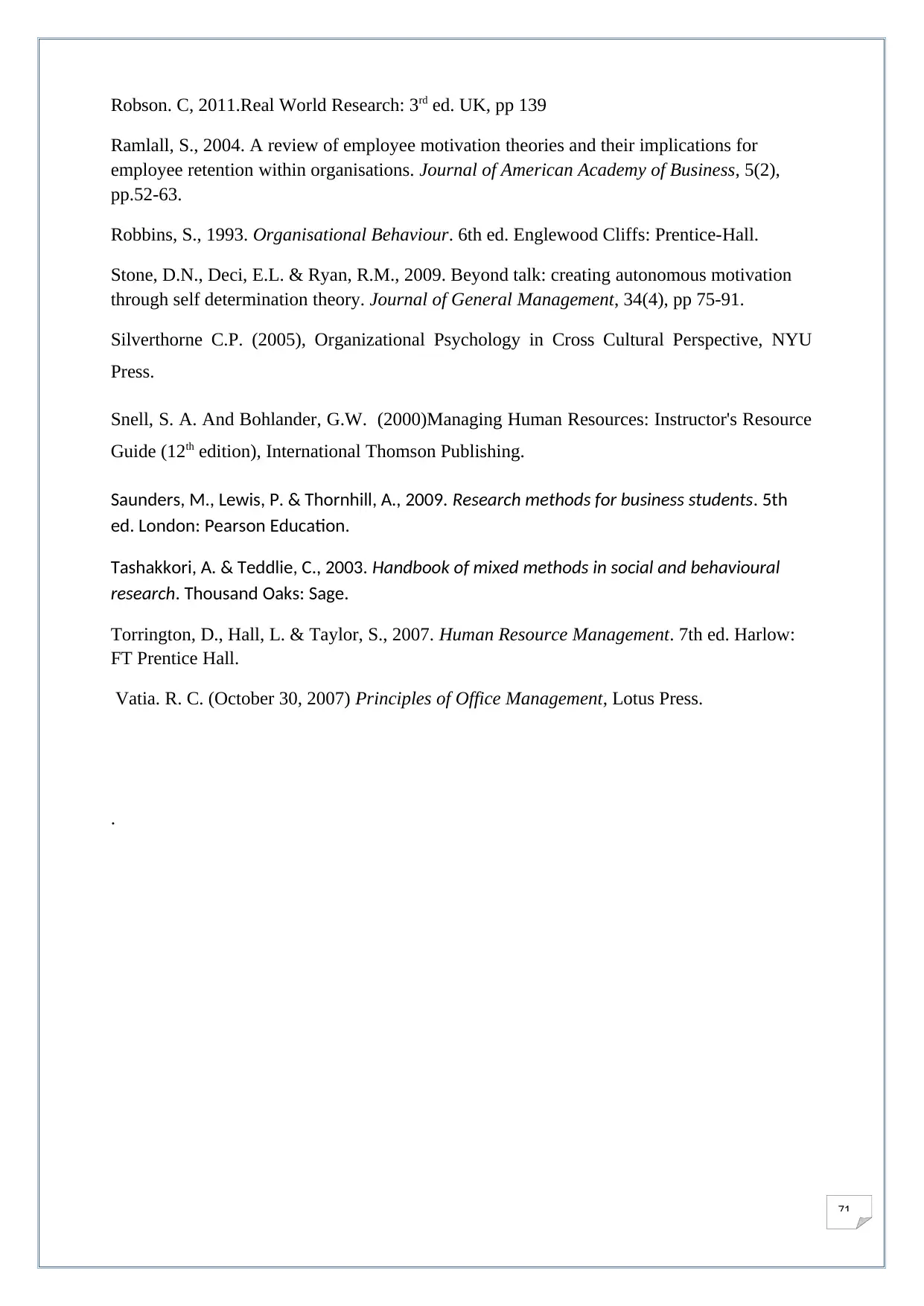
71
Robson. C, 2011.Real World Research: 3rd ed. UK, pp 139
Ramlall, S., 2004. A review of employee motivation theories and their implications for
employee retention within organisations. Journal of American Academy of Business, 5(2),
pp.52-63.
Robbins, S., 1993. Organisational Behaviour. 6th ed. Englewood Cliffs: Prentice-Hall.
Stone, D.N., Deci, E.L. & Ryan, R.M., 2009. Beyond talk: creating autonomous motivation
through self determination theory. Journal of General Management, 34(4), pp 75-91.
Silverthorne C.P. (2005), Organizational Psychology in Cross Cultural Perspective, NYU
Press.
Snell, S. A. And Bohlander, G.W. (2000)Managing Human Resources: Instructor's Resource
Guide (12th edition), International Thomson Publishing.
Saunders, M., Lewis, P. & Thornhill, A., 2009. Research methods for business students. 5th
ed. London: Pearson Education.
Tashakkori, A. & Teddlie, C., 2003. Handbook of mixed methods in social and behavioural
research. Thousand Oaks: Sage.
Torrington, D., Hall, L. & Taylor, S., 2007. Human Resource Management. 7th ed. Harlow:
FT Prentice Hall.
Vatia. R. C. (October 30, 2007) Principles of Office Management, Lotus Press.
.
Robson. C, 2011.Real World Research: 3rd ed. UK, pp 139
Ramlall, S., 2004. A review of employee motivation theories and their implications for
employee retention within organisations. Journal of American Academy of Business, 5(2),
pp.52-63.
Robbins, S., 1993. Organisational Behaviour. 6th ed. Englewood Cliffs: Prentice-Hall.
Stone, D.N., Deci, E.L. & Ryan, R.M., 2009. Beyond talk: creating autonomous motivation
through self determination theory. Journal of General Management, 34(4), pp 75-91.
Silverthorne C.P. (2005), Organizational Psychology in Cross Cultural Perspective, NYU
Press.
Snell, S. A. And Bohlander, G.W. (2000)Managing Human Resources: Instructor's Resource
Guide (12th edition), International Thomson Publishing.
Saunders, M., Lewis, P. & Thornhill, A., 2009. Research methods for business students. 5th
ed. London: Pearson Education.
Tashakkori, A. & Teddlie, C., 2003. Handbook of mixed methods in social and behavioural
research. Thousand Oaks: Sage.
Torrington, D., Hall, L. & Taylor, S., 2007. Human Resource Management. 7th ed. Harlow:
FT Prentice Hall.
Vatia. R. C. (October 30, 2007) Principles of Office Management, Lotus Press.
.
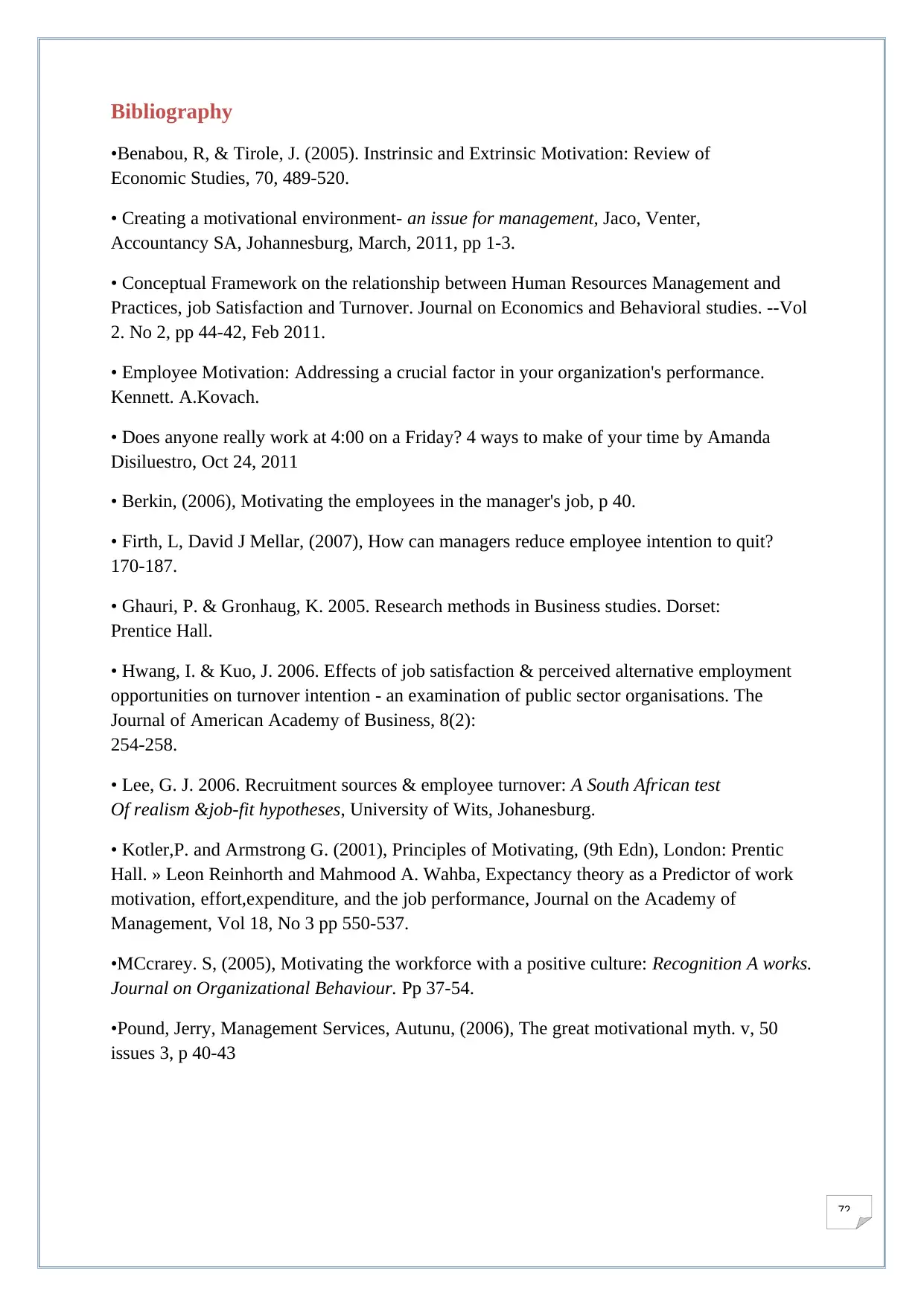
72
Bibliography
•Benabou, R, & Tirole, J. (2005). Instrinsic and Extrinsic Motivation: Review of
Economic Studies, 70, 489-520.
• Creating a motivational environment- an issue for management, Jaco, Venter,
Accountancy SA, Johannesburg, March, 2011, pp 1-3.
• Conceptual Framework on the relationship between Human Resources Management and
Practices, job Satisfaction and Turnover. Journal on Economics and Behavioral studies. --Vol
2. No 2, pp 44-42, Feb 2011.
• Employee Motivation: Addressing a crucial factor in your organization's performance.
Kennett. A.Kovach.
• Does anyone really work at 4:00 on a Friday? 4 ways to make of your time by Amanda
Disiluestro, Oct 24, 2011
• Berkin, (2006), Motivating the employees in the manager's job, p 40.
• Firth, L, David J Mellar, (2007), How can managers reduce employee intention to quit?
170-187.
• Ghauri, P. & Gronhaug, K. 2005. Research methods in Business studies. Dorset:
Prentice Hall.
• Hwang, I. & Kuo, J. 2006. Effects of job satisfaction & perceived alternative employment
opportunities on turnover intention - an examination of public sector organisations. The
Journal of American Academy of Business, 8(2):
254-258.
• Lee, G. J. 2006. Recruitment sources & employee turnover: A South African test
Of realism &job-fit hypotheses, University of Wits, Johanesburg.
• Kotler,P. and Armstrong G. (2001), Principles of Motivating, (9th Edn), London: Prentic
Hall. » Leon Reinhorth and Mahmood A. Wahba, Expectancy theory as a Predictor of work
motivation, effort,expenditure, and the job performance, Journal on the Academy of
Management, Vol 18, No 3 pp 550-537.
•MCcrarey. S, (2005), Motivating the workforce with a positive culture: Recognition A works.
Journal on Organizational Behaviour. Pp 37-54.
•Pound, Jerry, Management Services, Autunu, (2006), The great motivational myth. v, 50
issues 3, p 40-43
Bibliography
•Benabou, R, & Tirole, J. (2005). Instrinsic and Extrinsic Motivation: Review of
Economic Studies, 70, 489-520.
• Creating a motivational environment- an issue for management, Jaco, Venter,
Accountancy SA, Johannesburg, March, 2011, pp 1-3.
• Conceptual Framework on the relationship between Human Resources Management and
Practices, job Satisfaction and Turnover. Journal on Economics and Behavioral studies. --Vol
2. No 2, pp 44-42, Feb 2011.
• Employee Motivation: Addressing a crucial factor in your organization's performance.
Kennett. A.Kovach.
• Does anyone really work at 4:00 on a Friday? 4 ways to make of your time by Amanda
Disiluestro, Oct 24, 2011
• Berkin, (2006), Motivating the employees in the manager's job, p 40.
• Firth, L, David J Mellar, (2007), How can managers reduce employee intention to quit?
170-187.
• Ghauri, P. & Gronhaug, K. 2005. Research methods in Business studies. Dorset:
Prentice Hall.
• Hwang, I. & Kuo, J. 2006. Effects of job satisfaction & perceived alternative employment
opportunities on turnover intention - an examination of public sector organisations. The
Journal of American Academy of Business, 8(2):
254-258.
• Lee, G. J. 2006. Recruitment sources & employee turnover: A South African test
Of realism &job-fit hypotheses, University of Wits, Johanesburg.
• Kotler,P. and Armstrong G. (2001), Principles of Motivating, (9th Edn), London: Prentic
Hall. » Leon Reinhorth and Mahmood A. Wahba, Expectancy theory as a Predictor of work
motivation, effort,expenditure, and the job performance, Journal on the Academy of
Management, Vol 18, No 3 pp 550-537.
•MCcrarey. S, (2005), Motivating the workforce with a positive culture: Recognition A works.
Journal on Organizational Behaviour. Pp 37-54.
•Pound, Jerry, Management Services, Autunu, (2006), The great motivational myth. v, 50
issues 3, p 40-43
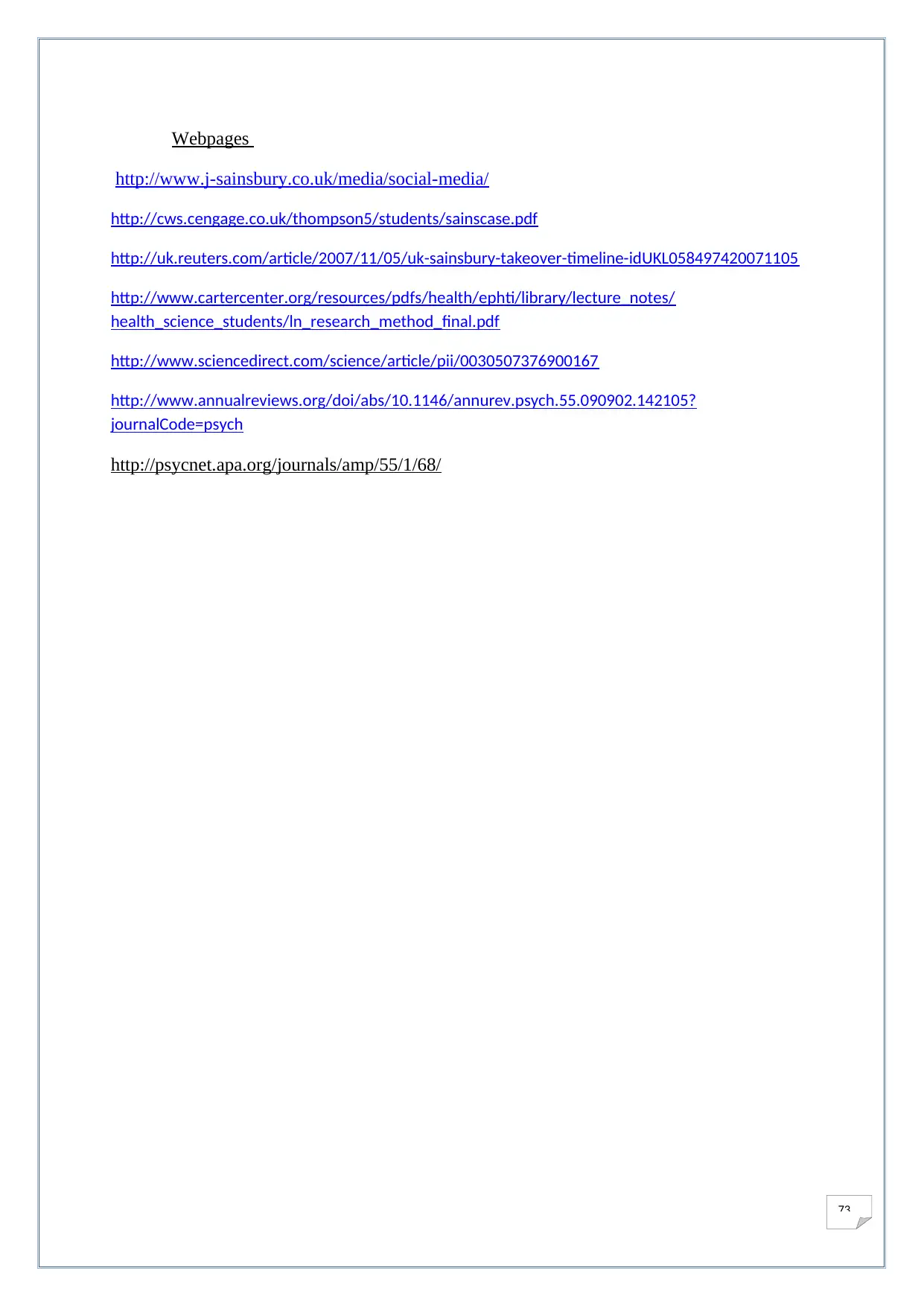
73
Webpages
http://www.j-sainsbury.co.uk/media/social-media/
http://cws.cengage.co.uk/thompson5/students/sainscase.pdf
http://uk.reuters.com/article/2007/11/05/uk-sainsbury-takeover-timeline-idUKL058497420071105
http://www.cartercenter.org/resources/pdfs/health/ephti/library/lecture_notes/
health_science_students/ln_research_method_final.pdf
http://www.sciencedirect.com/science/article/pii/0030507376900167
http://www.annualreviews.org/doi/abs/10.1146/annurev.psych.55.090902.142105?
journalCode=psych
http://psycnet.apa.org/journals/amp/55/1/68/
Webpages
http://www.j-sainsbury.co.uk/media/social-media/
http://cws.cengage.co.uk/thompson5/students/sainscase.pdf
http://uk.reuters.com/article/2007/11/05/uk-sainsbury-takeover-timeline-idUKL058497420071105
http://www.cartercenter.org/resources/pdfs/health/ephti/library/lecture_notes/
health_science_students/ln_research_method_final.pdf
http://www.sciencedirect.com/science/article/pii/0030507376900167
http://www.annualreviews.org/doi/abs/10.1146/annurev.psych.55.090902.142105?
journalCode=psych
http://psycnet.apa.org/journals/amp/55/1/68/
Paraphrase This Document
Need a fresh take? Get an instant paraphrase of this document with our AI Paraphraser
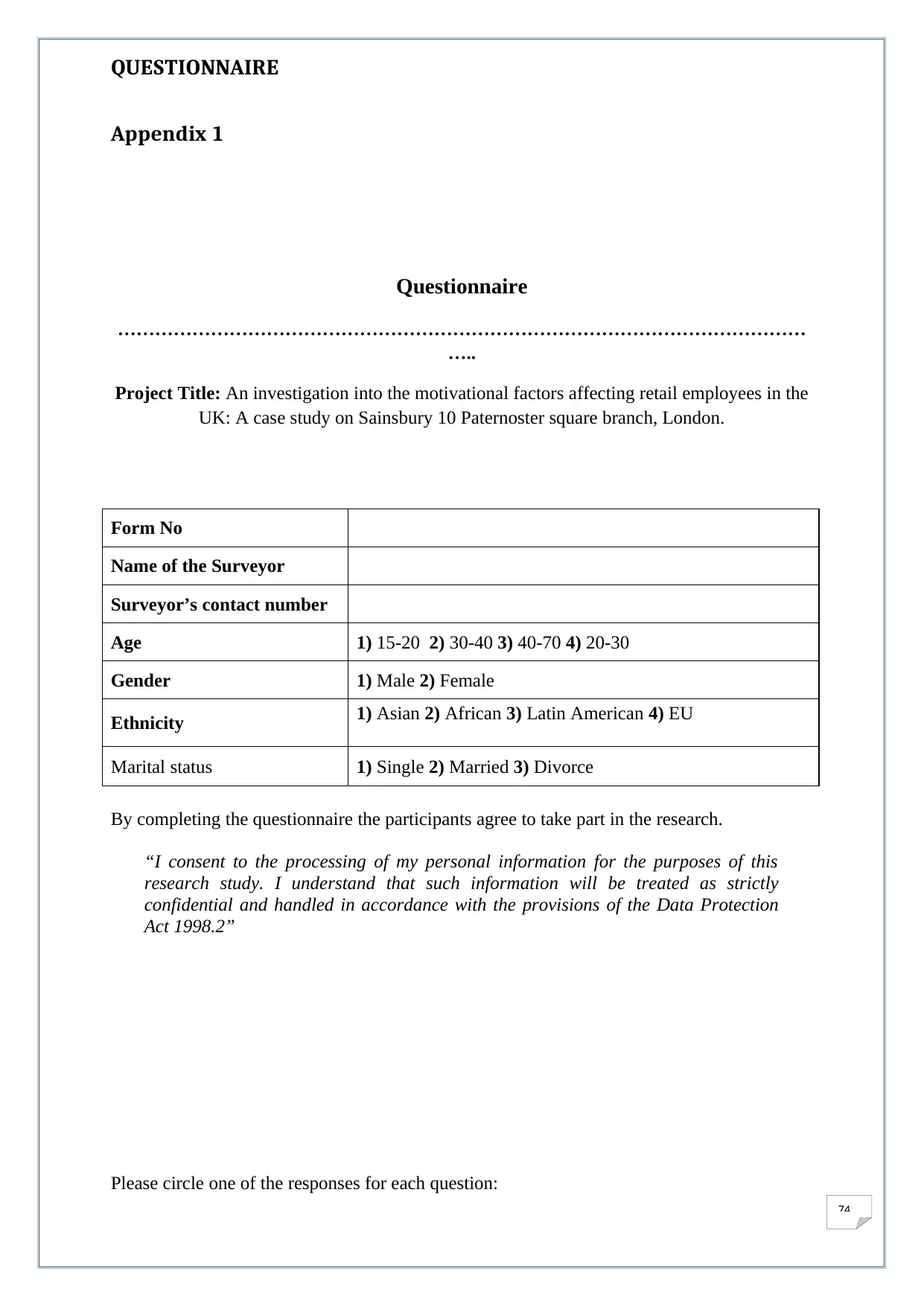
74
QUESTIONNAIRE
Appendix 1
Questionnaire
…………………………………………………………………………………………………
…..
Project Title: An investigation into the motivational factors affecting retail employees in the
UK: A case study on Sainsbury 10 Paternoster square branch, London.
Form No
Name of the Surveyor
Surveyor’s contact number
Age 1) 15-20 2) 30-40 3) 40-70 4) 20-30
Gender 1) Male 2) Female
Ethnicity 1) Asian 2) African 3) Latin American 4) EU
Marital status 1) Single 2) Married 3) Divorce
By completing the questionnaire the participants agree to take part in the research.
“I consent to the processing of my personal information for the purposes of this
research study. I understand that such information will be treated as strictly
confidential and handled in accordance with the provisions of the Data Protection
Act 1998.2”
Please circle one of the responses for each question:
QUESTIONNAIRE
Appendix 1
Questionnaire
…………………………………………………………………………………………………
…..
Project Title: An investigation into the motivational factors affecting retail employees in the
UK: A case study on Sainsbury 10 Paternoster square branch, London.
Form No
Name of the Surveyor
Surveyor’s contact number
Age 1) 15-20 2) 30-40 3) 40-70 4) 20-30
Gender 1) Male 2) Female
Ethnicity 1) Asian 2) African 3) Latin American 4) EU
Marital status 1) Single 2) Married 3) Divorce
By completing the questionnaire the participants agree to take part in the research.
“I consent to the processing of my personal information for the purposes of this
research study. I understand that such information will be treated as strictly
confidential and handled in accordance with the provisions of the Data Protection
Act 1998.2”
Please circle one of the responses for each question:
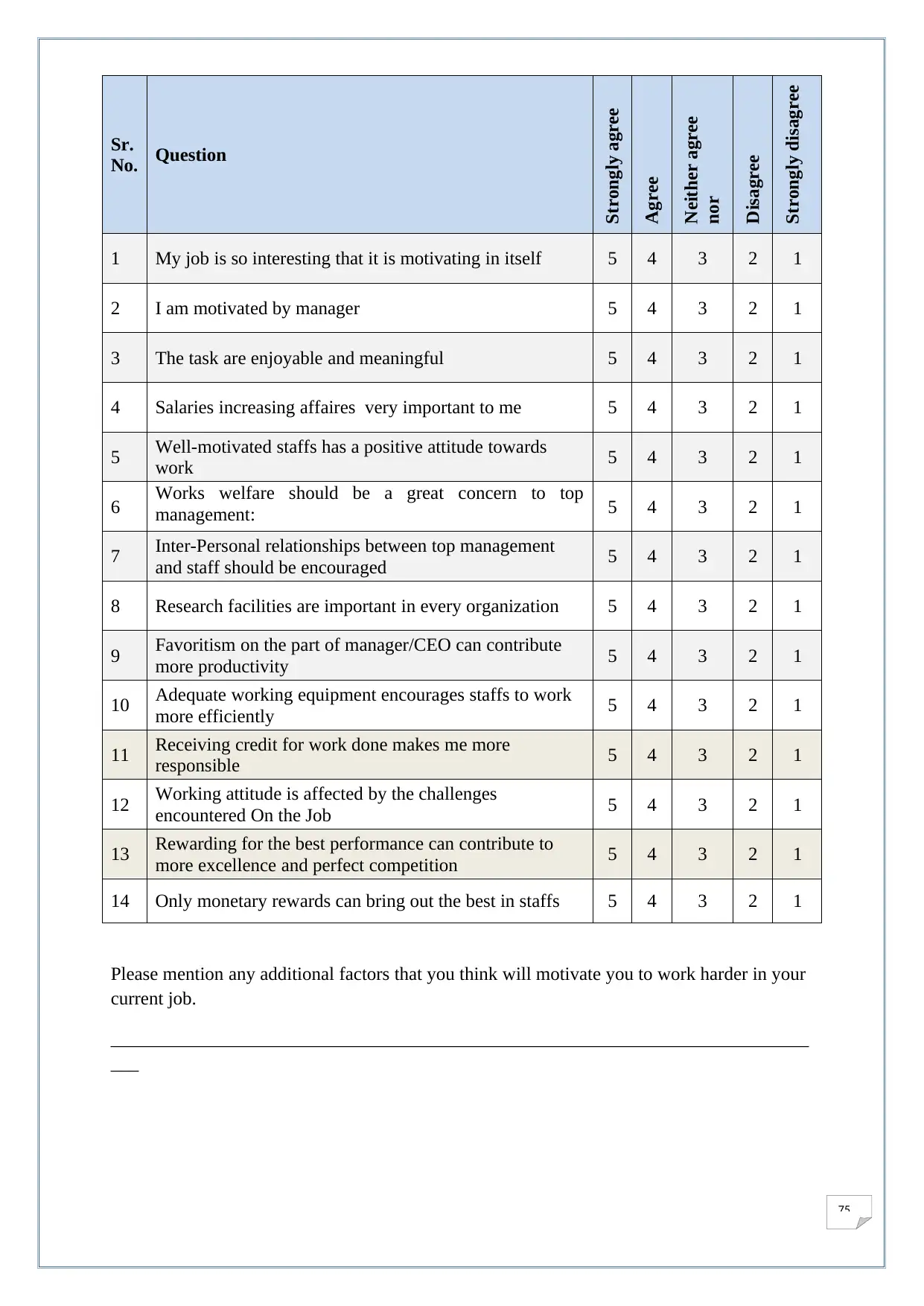
75
Sr.
No. Question
Strongly agree
Agree
Neither agree
nor
disagree
Disagree
Strongly disagree
1 My job is so interesting that it is motivating in itself 5 4 3 2 1
2 I am motivated by manager 5 4 3 2 1
3 The task are enjoyable and meaningful 5 4 3 2 1
4 Salaries increasing affaires very important to me 5 4 3 2 1
5 Well-motivated staffs has a positive attitude towards
work 5 4 3 2 1
6 Works welfare should be a great concern to top
management: 5 4 3 2 1
7 Inter-Personal relationships between top management
and staff should be encouraged 5 4 3 2 1
8 Research facilities are important in every organization 5 4 3 2 1
9 Favoritism on the part of manager/CEO can contribute
more productivity 5 4 3 2 1
10 Adequate working equipment encourages staffs to work
more efficiently 5 4 3 2 1
11 Receiving credit for work done makes me more
responsible 5 4 3 2 1
12 Working attitude is affected by the challenges
encountered On the Job 5 4 3 2 1
13 Rewarding for the best performance can contribute to
more excellence and perfect competition 5 4 3 2 1
14 Only monetary rewards can bring out the best in staffs 5 4 3 2 1
Please mention any additional factors that you think will motivate you to work harder in your
current job.
___________________________________________________________________________
___
Sr.
No. Question
Strongly agree
Agree
Neither agree
nor
disagree
Disagree
Strongly disagree
1 My job is so interesting that it is motivating in itself 5 4 3 2 1
2 I am motivated by manager 5 4 3 2 1
3 The task are enjoyable and meaningful 5 4 3 2 1
4 Salaries increasing affaires very important to me 5 4 3 2 1
5 Well-motivated staffs has a positive attitude towards
work 5 4 3 2 1
6 Works welfare should be a great concern to top
management: 5 4 3 2 1
7 Inter-Personal relationships between top management
and staff should be encouraged 5 4 3 2 1
8 Research facilities are important in every organization 5 4 3 2 1
9 Favoritism on the part of manager/CEO can contribute
more productivity 5 4 3 2 1
10 Adequate working equipment encourages staffs to work
more efficiently 5 4 3 2 1
11 Receiving credit for work done makes me more
responsible 5 4 3 2 1
12 Working attitude is affected by the challenges
encountered On the Job 5 4 3 2 1
13 Rewarding for the best performance can contribute to
more excellence and perfect competition 5 4 3 2 1
14 Only monetary rewards can bring out the best in staffs 5 4 3 2 1
Please mention any additional factors that you think will motivate you to work harder in your
current job.
___________________________________________________________________________
___
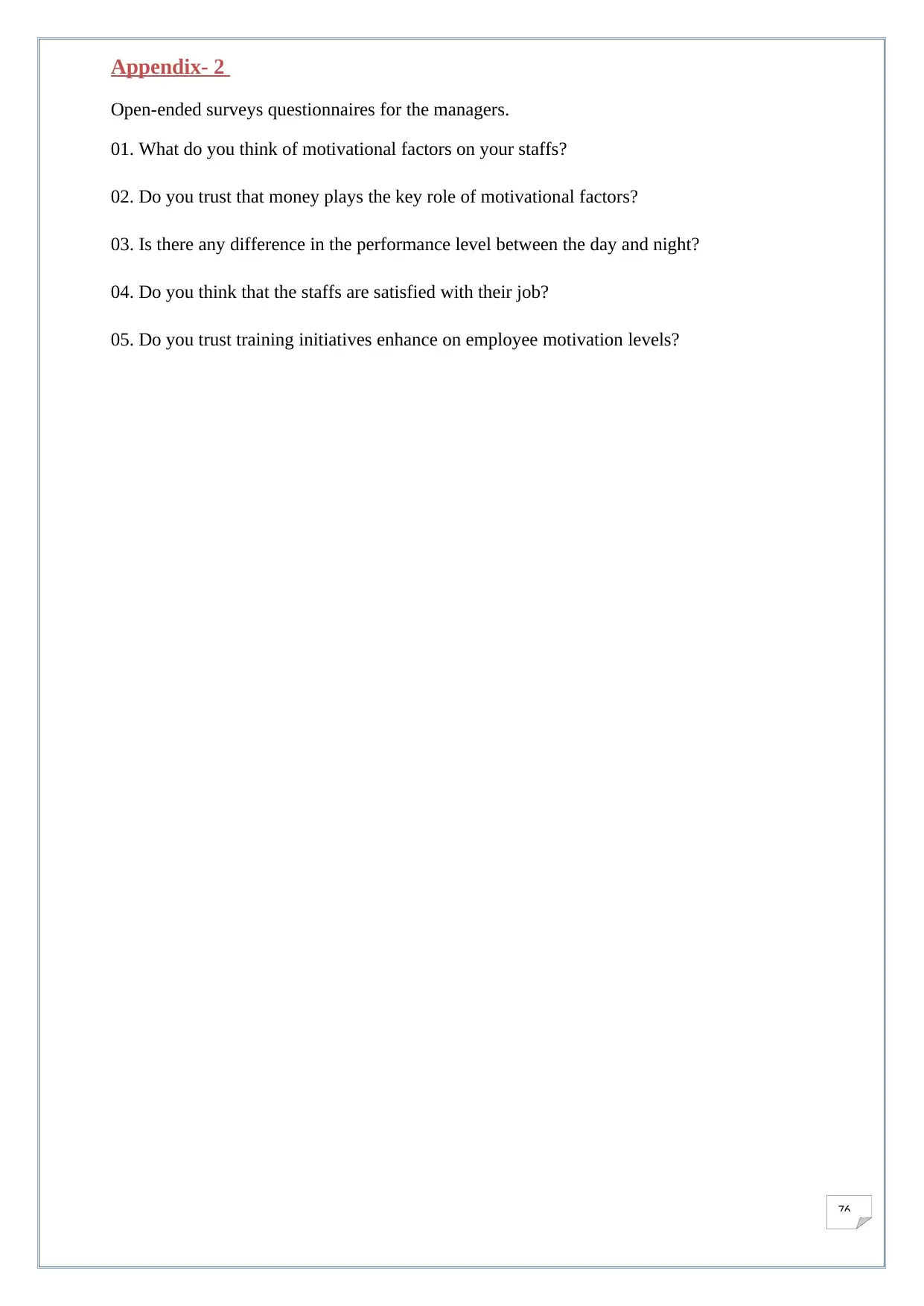
76
Appendix- 2
Open-ended surveys questionnaires for the managers.
01. What do you think of motivational factors on your staffs?
02. Do you trust that money plays the key role of motivational factors?
03. Is there any difference in the performance level between the day and night?
04. Do you think that the staffs are satisfied with their job?
05. Do you trust training initiatives enhance on employee motivation levels?
Appendix- 2
Open-ended surveys questionnaires for the managers.
01. What do you think of motivational factors on your staffs?
02. Do you trust that money plays the key role of motivational factors?
03. Is there any difference in the performance level between the day and night?
04. Do you think that the staffs are satisfied with their job?
05. Do you trust training initiatives enhance on employee motivation levels?
Secure Best Marks with AI Grader
Need help grading? Try our AI Grader for instant feedback on your assignments.

77
Thank you
Thank you
1 out of 77
Related Documents
Your All-in-One AI-Powered Toolkit for Academic Success.
+13062052269
info@desklib.com
Available 24*7 on WhatsApp / Email
![[object Object]](/_next/static/media/star-bottom.7253800d.svg)
Unlock your academic potential
© 2024 | Zucol Services PVT LTD | All rights reserved.





